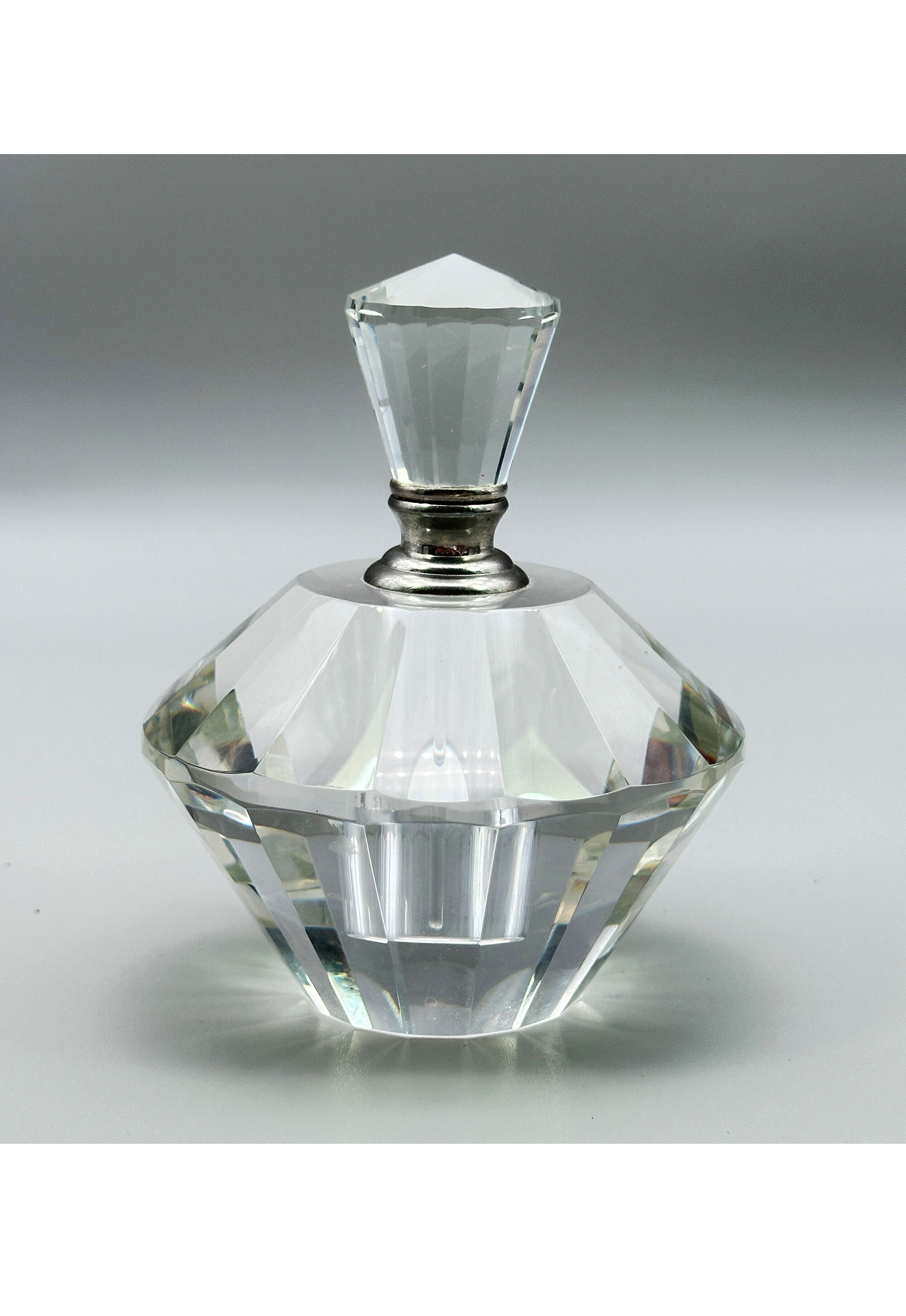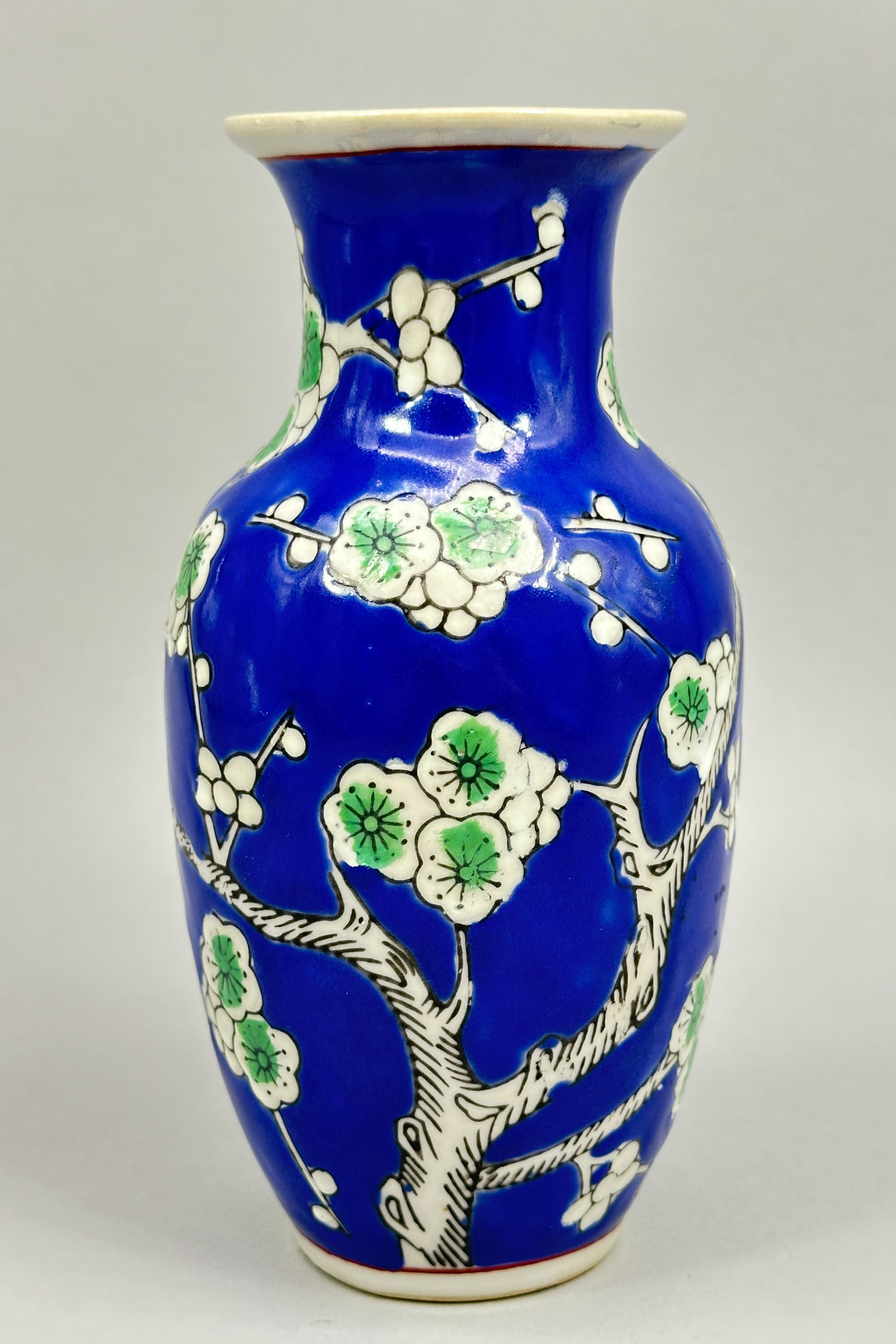
Chinese blue ground Vase decorated Prunus, late C20th
Price: £25
Hollywood Regency Ormolu and Glass Scent Bottle, second half C20th
Price: £95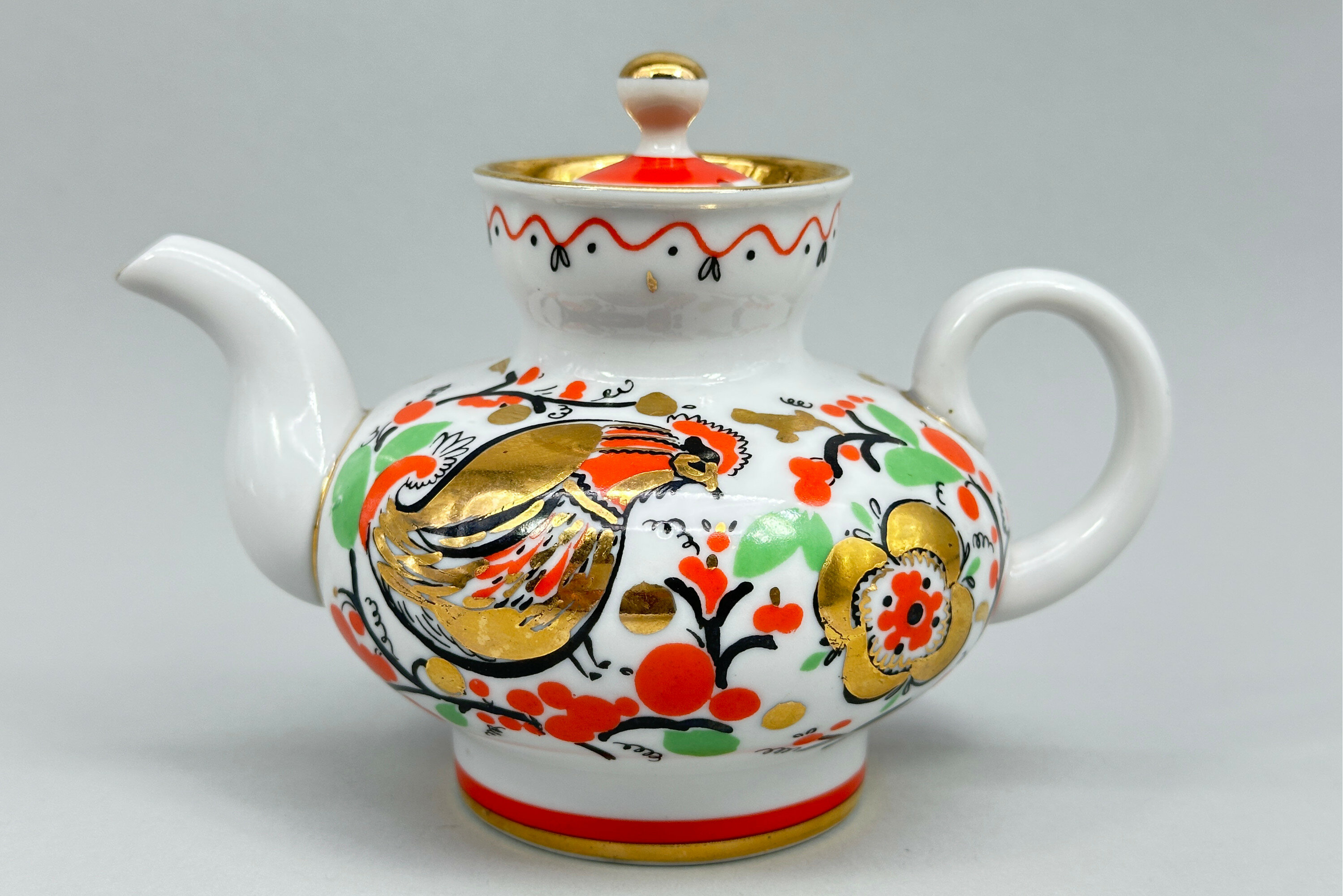
Lomonosov Teapot decorated Cockerels, late C20th
Price: £45
An art glass Perfume Bottle and Stopper, Martin Andrews Glass, C21st
Price: £75Martin Andrews (see image 9) graduated from West Surrey College of Art and Design with a BA (hons) Glass in 1991. Following this he was based in London until 2000 when he then launched his current workshop at the Ruskin Glass Centre in Stourbridge. His work often draws on the earth's natural forms and patterns and his ‘beach’ range is a prime example of this. Most of his pieces are signed, but this bottle is not, perhaps because of its size, but its inclusion in the studio’s inventory makes its provenance beyond doubt.
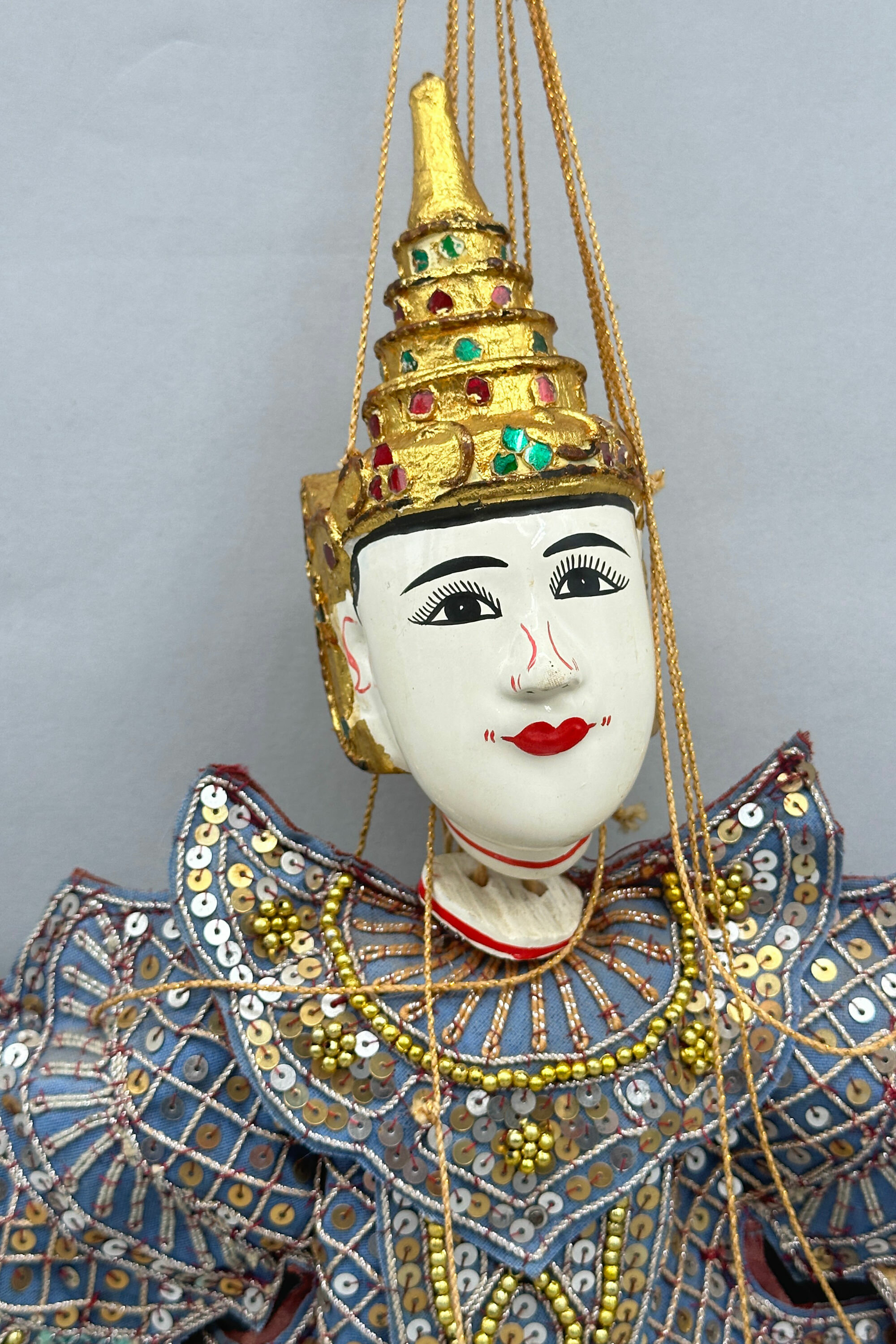
Marionette Puppet of a Dancing Lady or Princess, probably Burmese late C20th
Price: £45The style of the dress suggests Burmese work and very similar fabric decoration can be seen in the cloth wall hangings also included in this sale. Burma has a tradition of marionette puppetry (marionettes are a specific form of puppet where the figure is controlled by strings or rods) which dates back to the late eighteenth century and is still popular today with visitors to the country, now called Myanmar. Termed ‘Yoke thé’, the Burmese marionette tradition allowed political commentary under the guise of of an entertainment display. The standard ‘troupe’ comprised twenty seven characters, both animal and human, and this lady figure is probably the ‘princess’ (‘Minthami’). She is a fine example of the genre and probably dates to the 1990s when General Khin Nyunt of the ruling junta lent official support to marionette actors and troupes in an attempt to revive a tradition which had fallen somewhat into decline.

Pair cast iron Doorstops, Basket of Fruit, probably American mid C20th
Price: £45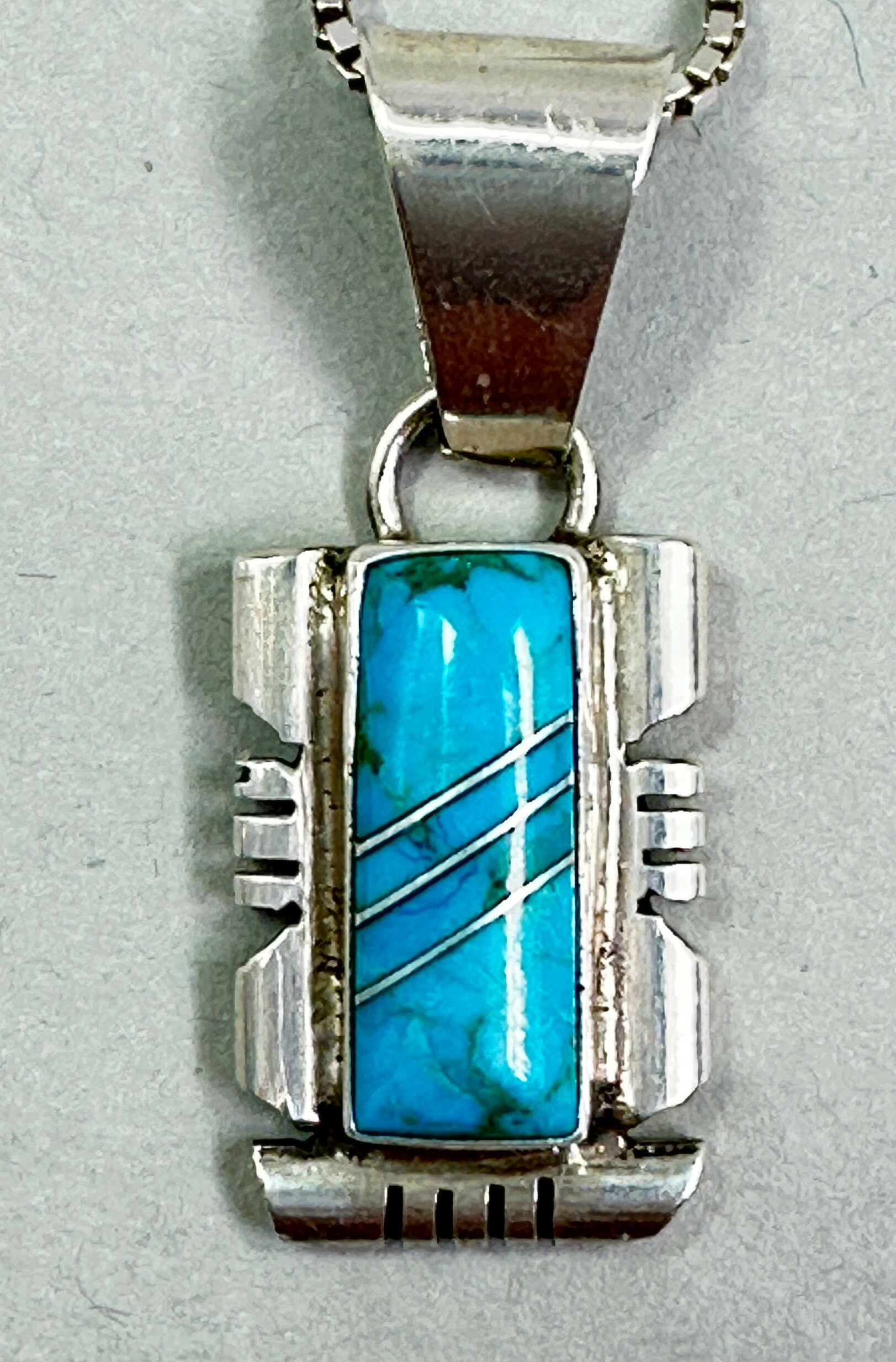
Zuni turquoise silver pendant Necklace, modern
Price: £35
Victorian style Bracelet in Mother of Pearl and Silver, modern
Price: £95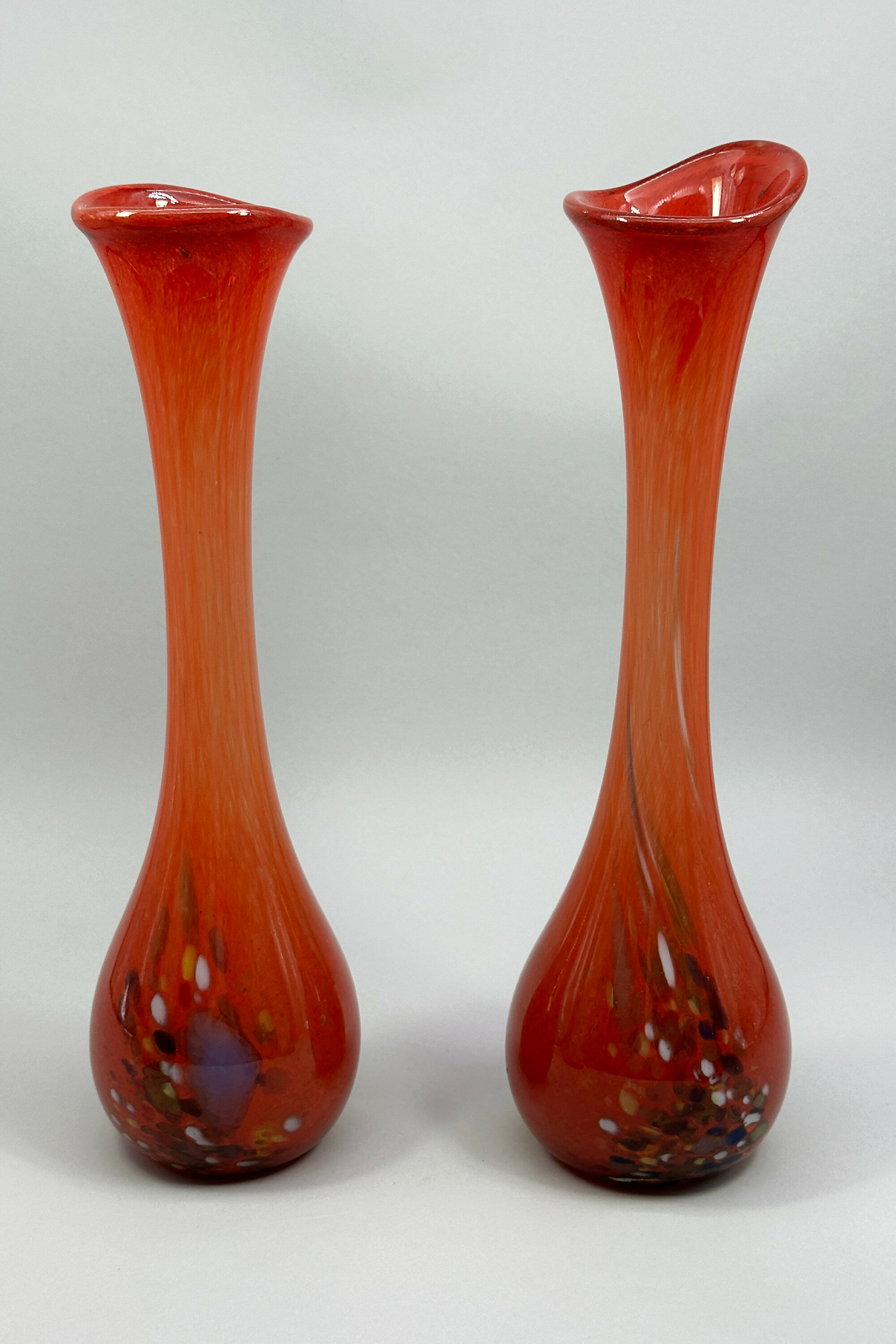
Pair of slender red glass bottle Vases, probably Joska Kristall, Germany, late C20th
Price: £85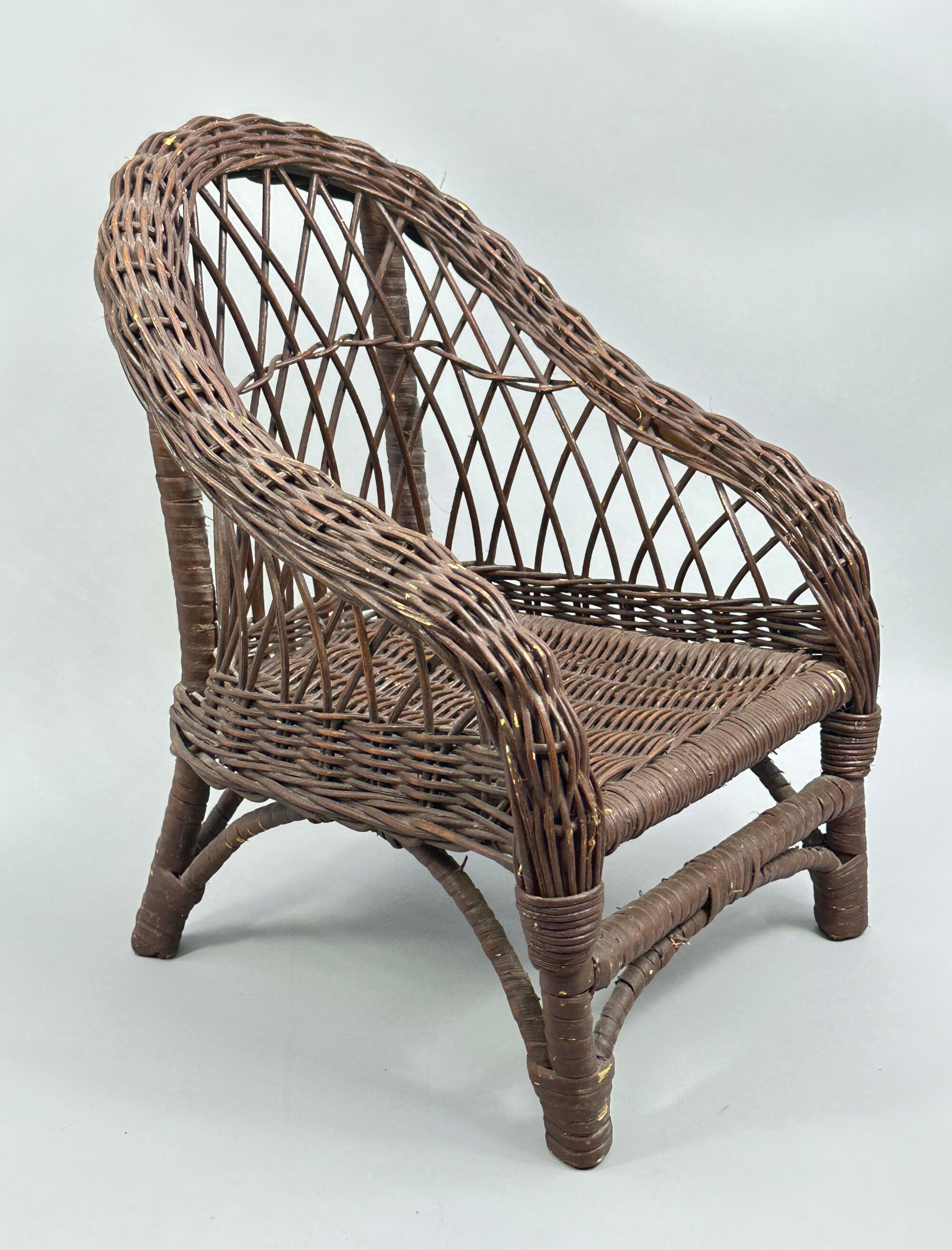
Toy Wicker Chair, mid C20th
Price: £35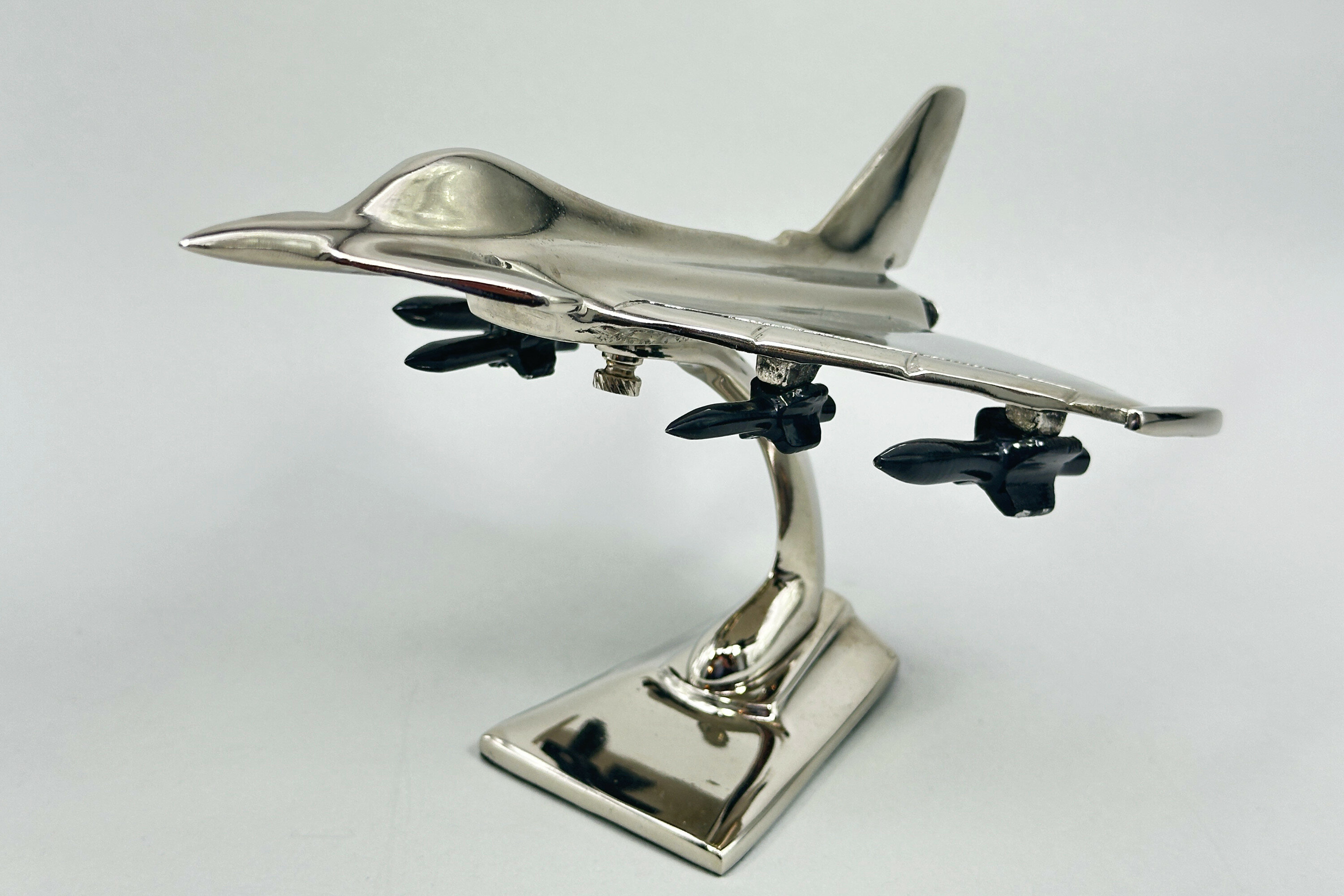
Desktop Model of a Typhoon Bomber Plane, Modern
Price: £45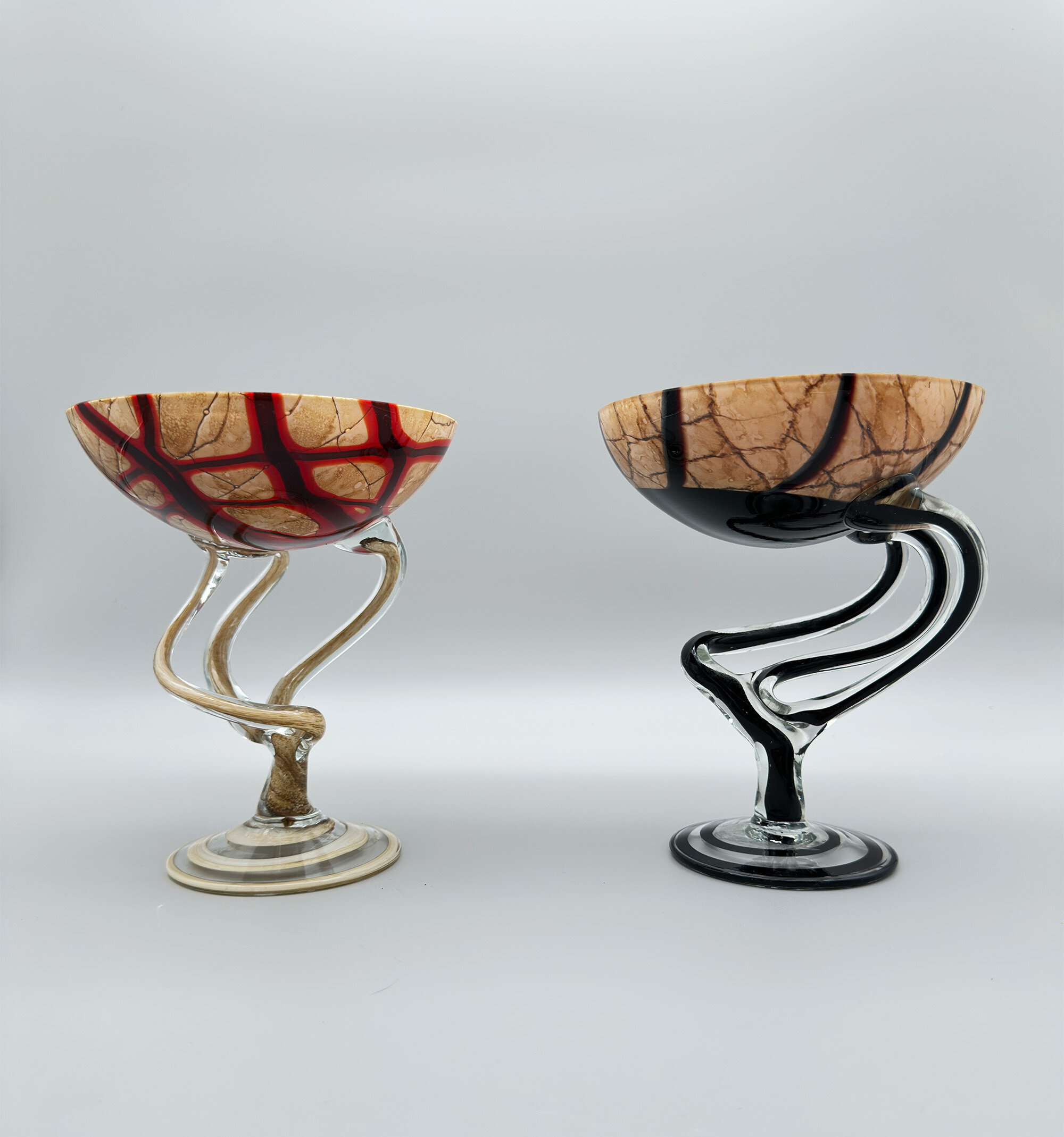
Two art glass pedestal Bowls, Jozephina Glassworks, Krosno, Polish c1980
Estimate: £60 – 80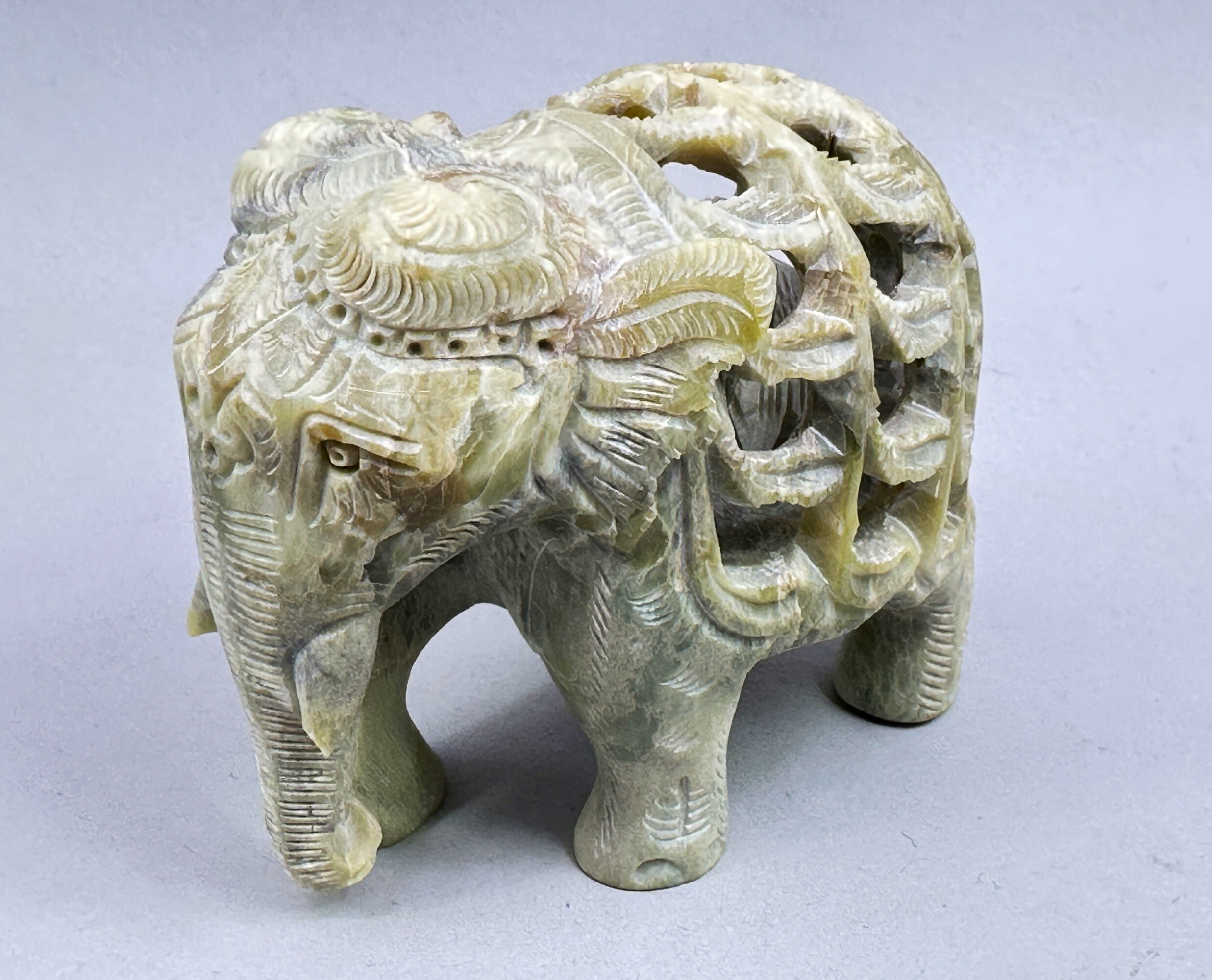
Indian carved Soapstone Figure of an Elephant and Baby Elephant
Price: £25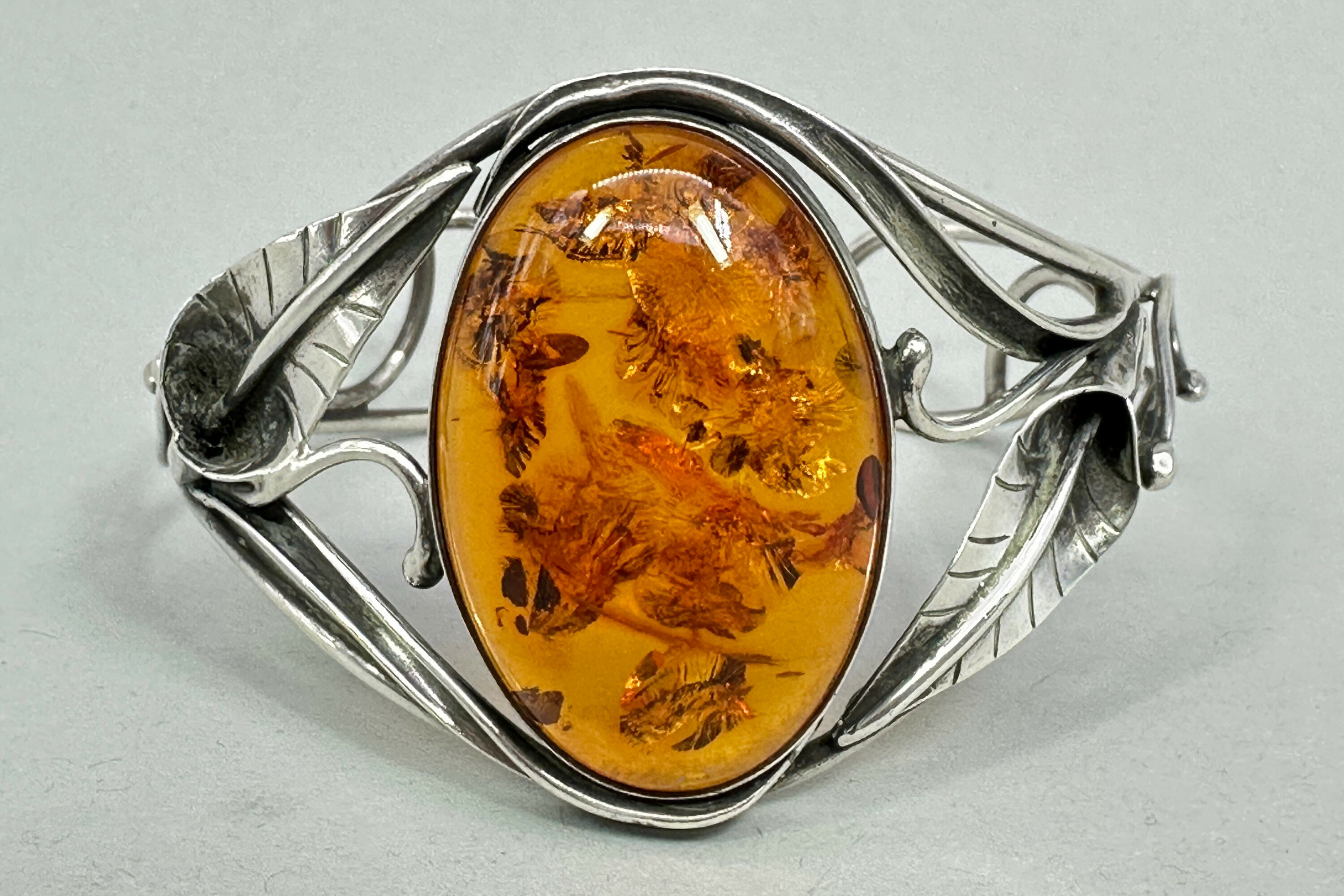
Large amber cabochon cuff Bracelet, c1970
Price: £95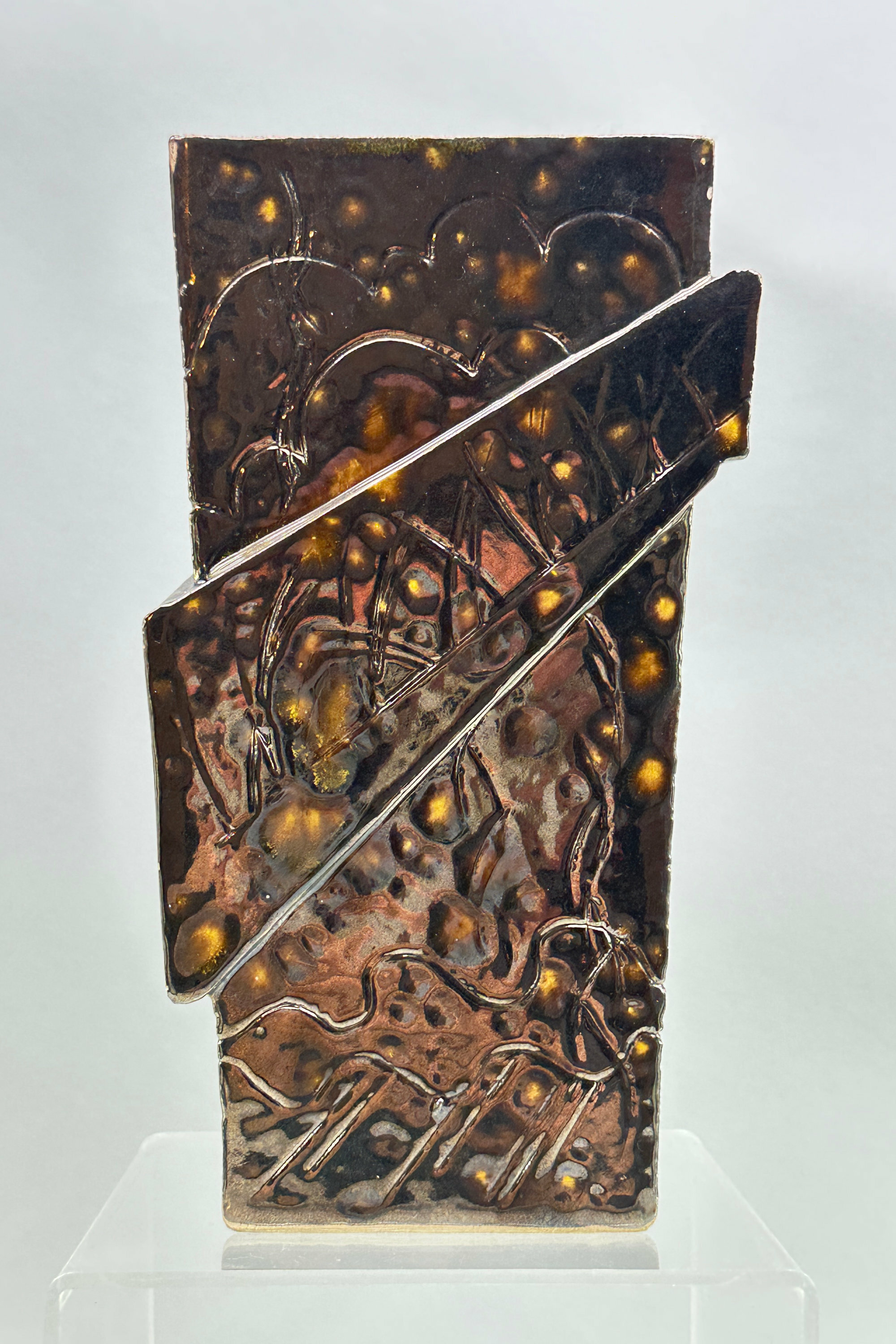
Art Deco Style brown lustre glaze triangular form Vase, signed, C20th
Price: £35
Studio Pottery Vase, Splatt Pottery, Cornwall, 1990s
Price: £55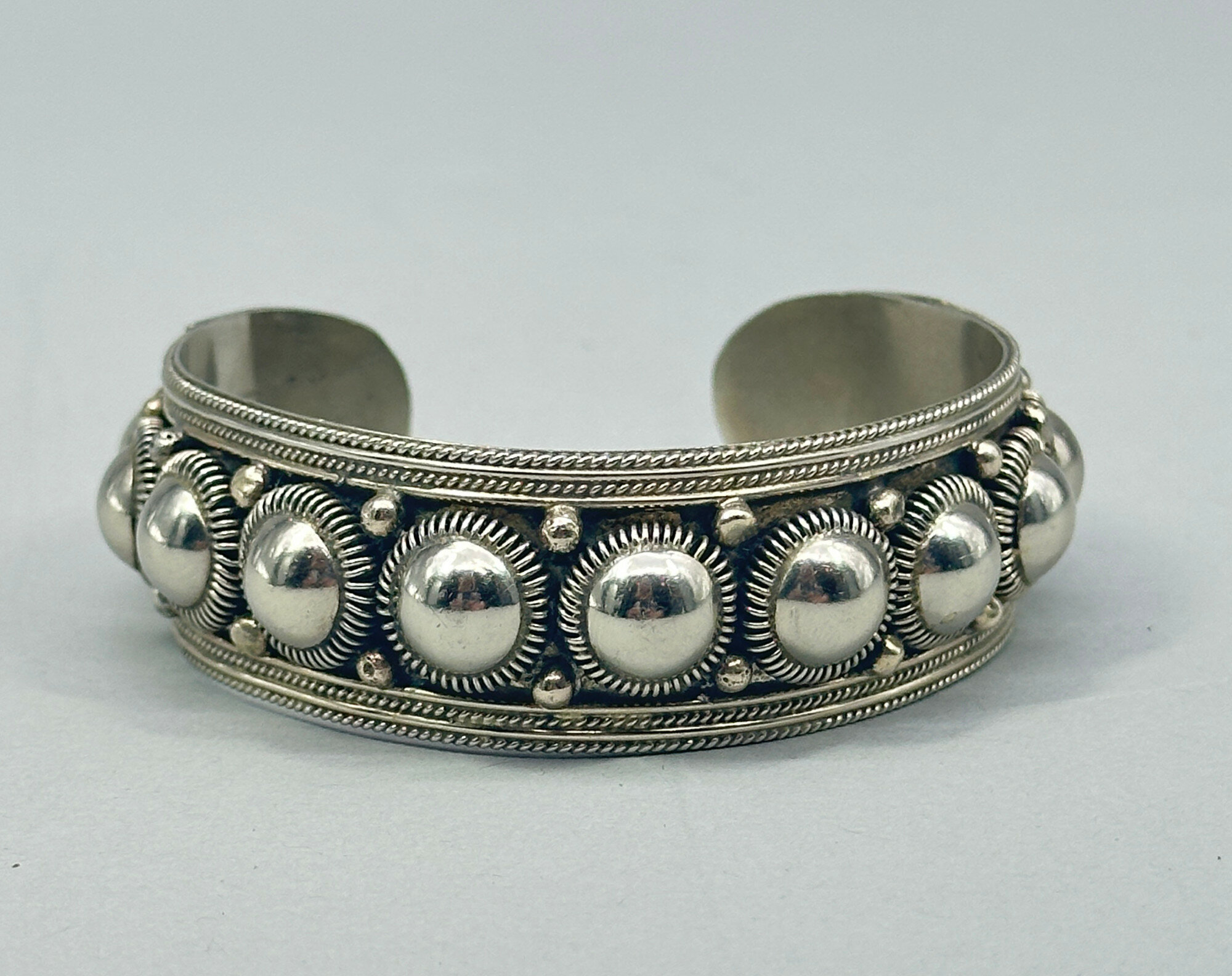
Siam silver cuff bracelet c1950
Price: £85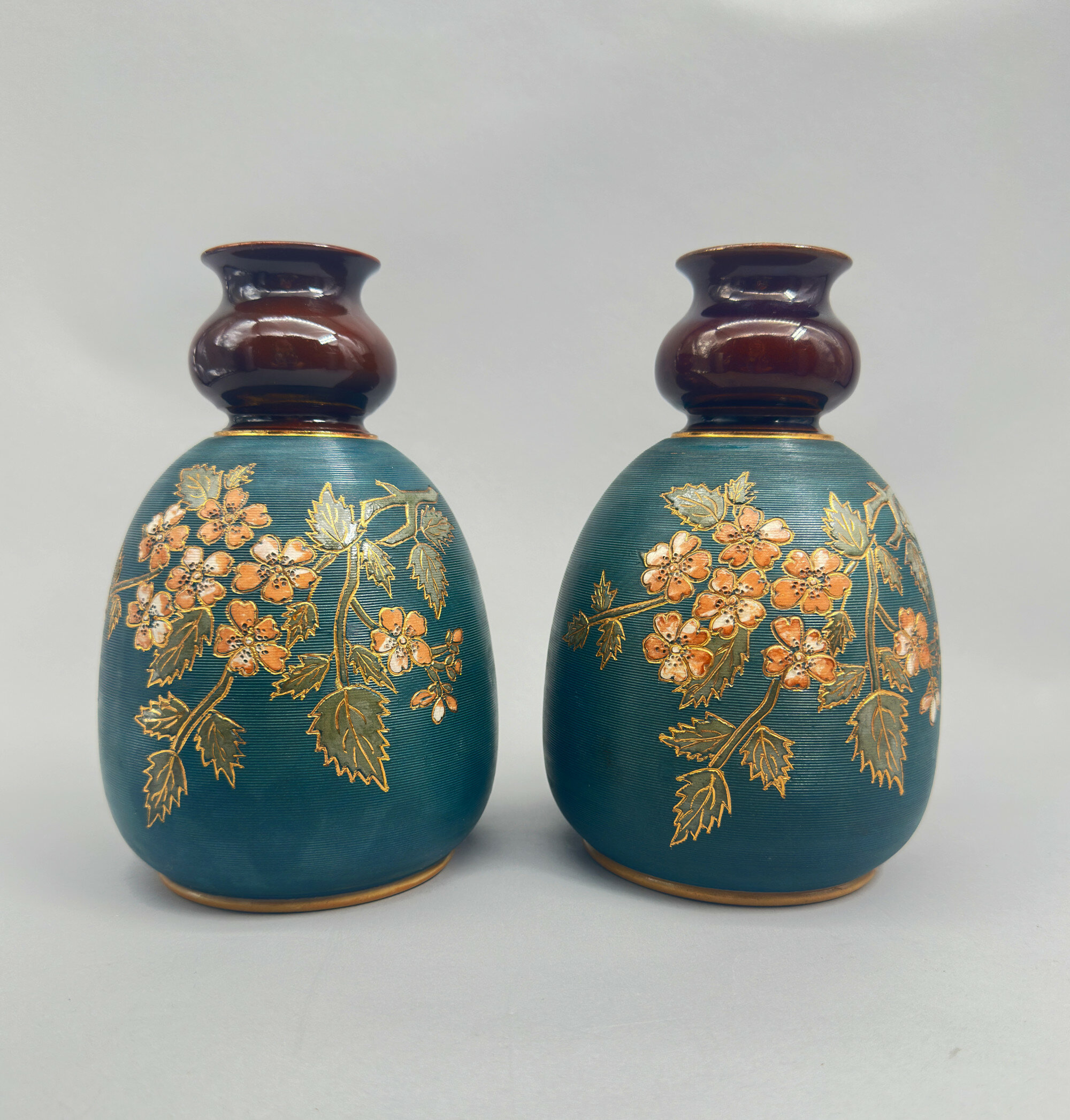
Pair of Lovatt and Lovatt Langley Mill Vases, early C20th
Price: £85The Langley Mill Pottery was located in Langley Mill, Derbyshire on the Derbyshire – Nottinghamshire border. From its establishment in 1865 to its final closure in 1982, it went through five distinct periods of ownership, producing a wide range of stoneware ranging from utilitarian items and to high quality art pottery. This pair of vases dates from the third company that traded there, Lovatt and Lovatt. The Lovatt family had entered into partnership with the owner of the founding business at Langley Mill, James Calvert. From 1895 the business was in sole control of the Lovatt family and traded as ‘Lovatt and Lovatt’ until 1935. The early years of the twentieth century proved to be something of a zenith for them and a wide range of art pottery pieces were made which enjoyed great popularity. Production techniques were streamlined without a reduction in quality and in 1905, leadless glazes were introduced. These are proudly announced on the base of this pair of vases which are an excellent example of the Lovatt and Lovatt style and probably date to 1912, indicated by the impressed numbers for that year.
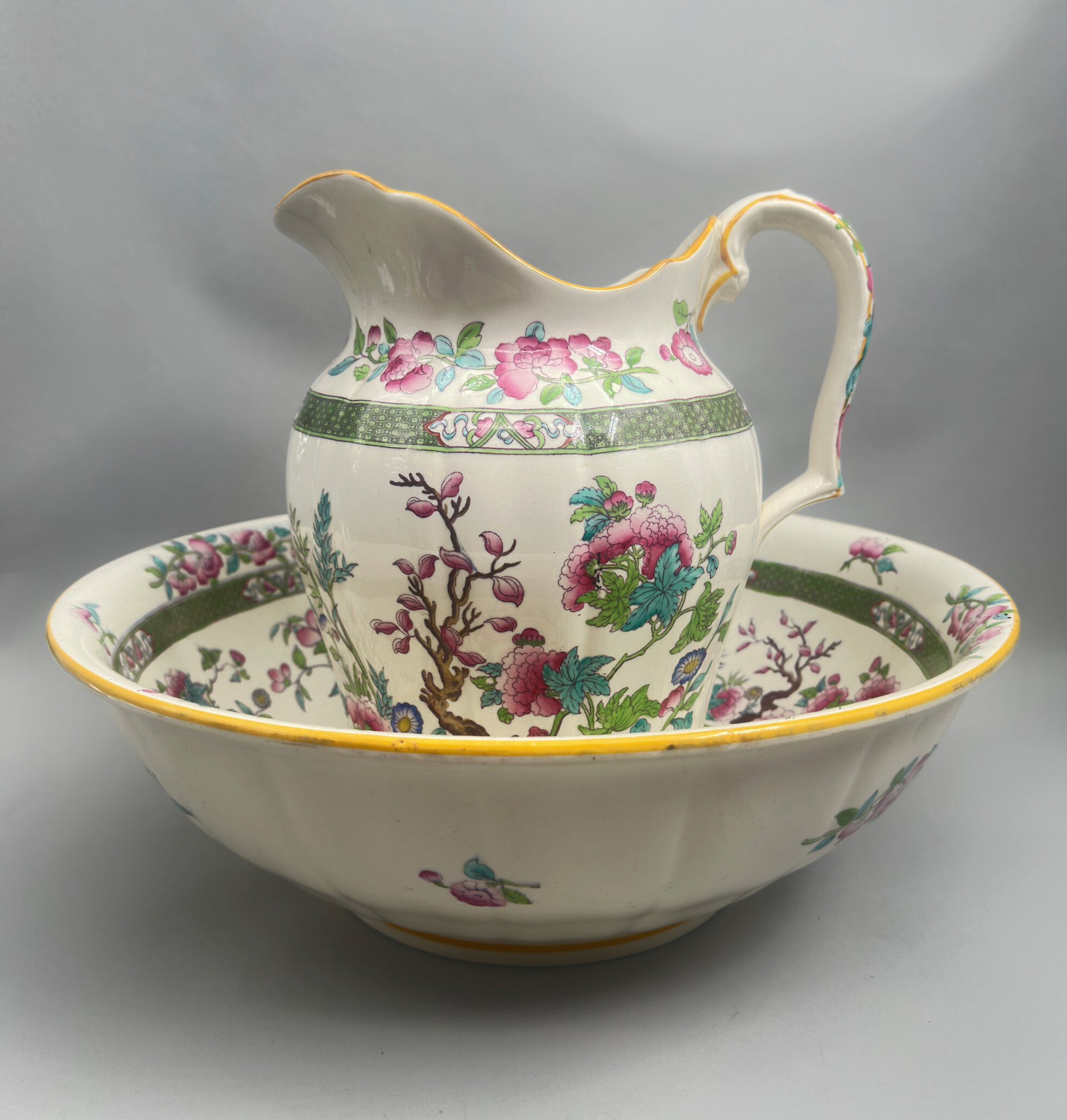
Minton Indian Tree Pattern Pitcher and Basin circa 1900
Price: £350………………………………………………………………………………………………….................................................................................
The celebrated firm of Mintons was founded by in 1793 by Thomas Minton (1765–1836) at Stoke-upon-Trent, Staffordshire, England as ‘Thomas Minton and Sons’, producing earthenware. The initial ranges were standard tablewares in blue transfer-printed or painted earthenware, including the ever-popular Willow pattern. By the mid nineteenth century and in partnership with Michael Hollins, Mintons began the production of decorative finishes for the interior and in particular floor tiles which enjoyed enormous demand and were the subject of numerous prestigious commissions including a contract for the flooring of the American Capitol. This was followed by the introduction of the plain white glazed ‘Parian’ wares and then the Italian inspired ‘majolica’ pieces with their richly coloured lead glazes. Mintons continued to follow popular trends, working with Christopher Dresser, recruiting Louis Solon from Sevres who had developed pâte-sur-pâte wares and finally contributing to Art Nouveau ceramics with a speciality in secessionist wares.
But the manufacture of tableware continued alongside all these other developments and Mintons adopted and adapted the popular ‘Indian Tree’ pattern which was first produced by Coalport in 1801. This design fused elements from Indian textiles and Chinese ceramics into an amalgam with immediate appeal. The pattern includes the crooked branch of a tree and a partial landscape including exotic flowers and leaves with a palette of colours emphasising green, blue, pink, and orange, resembling quite closely the Chinese export wares decorated in ‘Famille Rose’ enamels which had been exported to Europe in great quantities in the eighteenth century. Many of Coalport’s rivals, including Spode, Wedgwood and Royal Worcester produced their own versions of the design, but Mintons’ interpretation was held to be one of the most successful.
It was used by Mintons to decorate a variety of shapes, mainly dinner and tea wares, but the toilet pitcher and matching basin are seldom found in this pattern. Both the forms are extremely elegant, the pitcher with light fluting, a scalloped rim and a complementary handle, while the basin, also lightly fluted, employs simple lines with a turnover rim which follow the shape of a Chinese original. All the standard elements of the pattern can be seen, in particular the twisted tree, and the diaper work borders again reflect Chinese originals.
Both pieces are marked with the pattern number ‘T 216’ and a Minton stamp, the form of which allows fairly accurate dating. The globe topped by a crown with the banner ‘Mintons’ was used from 1873-1912 but ‘England’ was only added after 1891, giving a circa date in the late nineteenth or early twentieth century, probably around 1900. The original toilet set, which would have included the pitcher and basin along with, probably, a chamber pot, a soap dish, candlesticks and other accessories, was clearly a ‘deluxe’ item at the time and its quality is still apparent today when it can be enjoyed simply for its decorative appeal and as a reminder of a past era of grandeur.
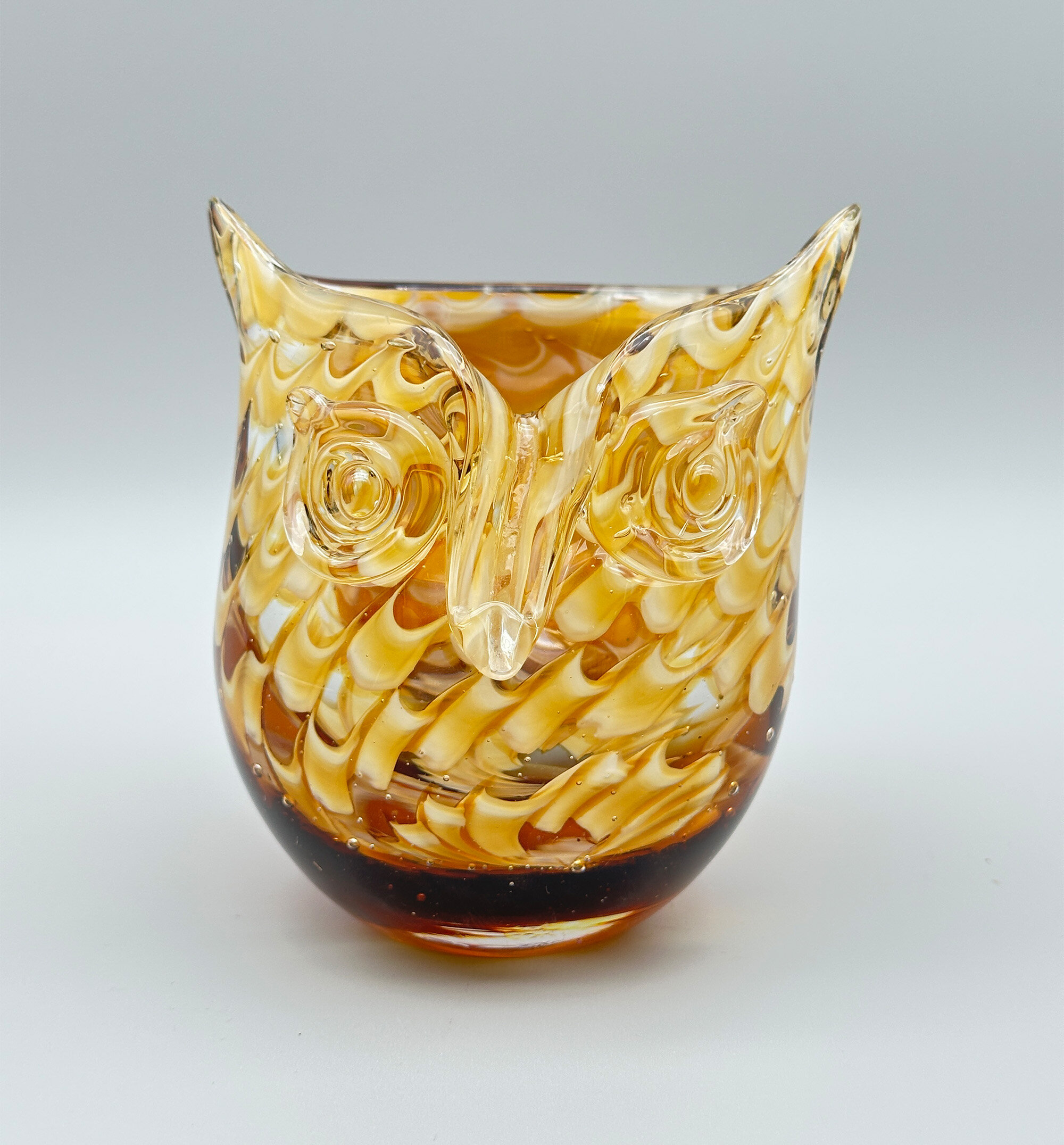
Owl glass Vase, Italian probably Murano, second half C20th
Estimate: £30 – 40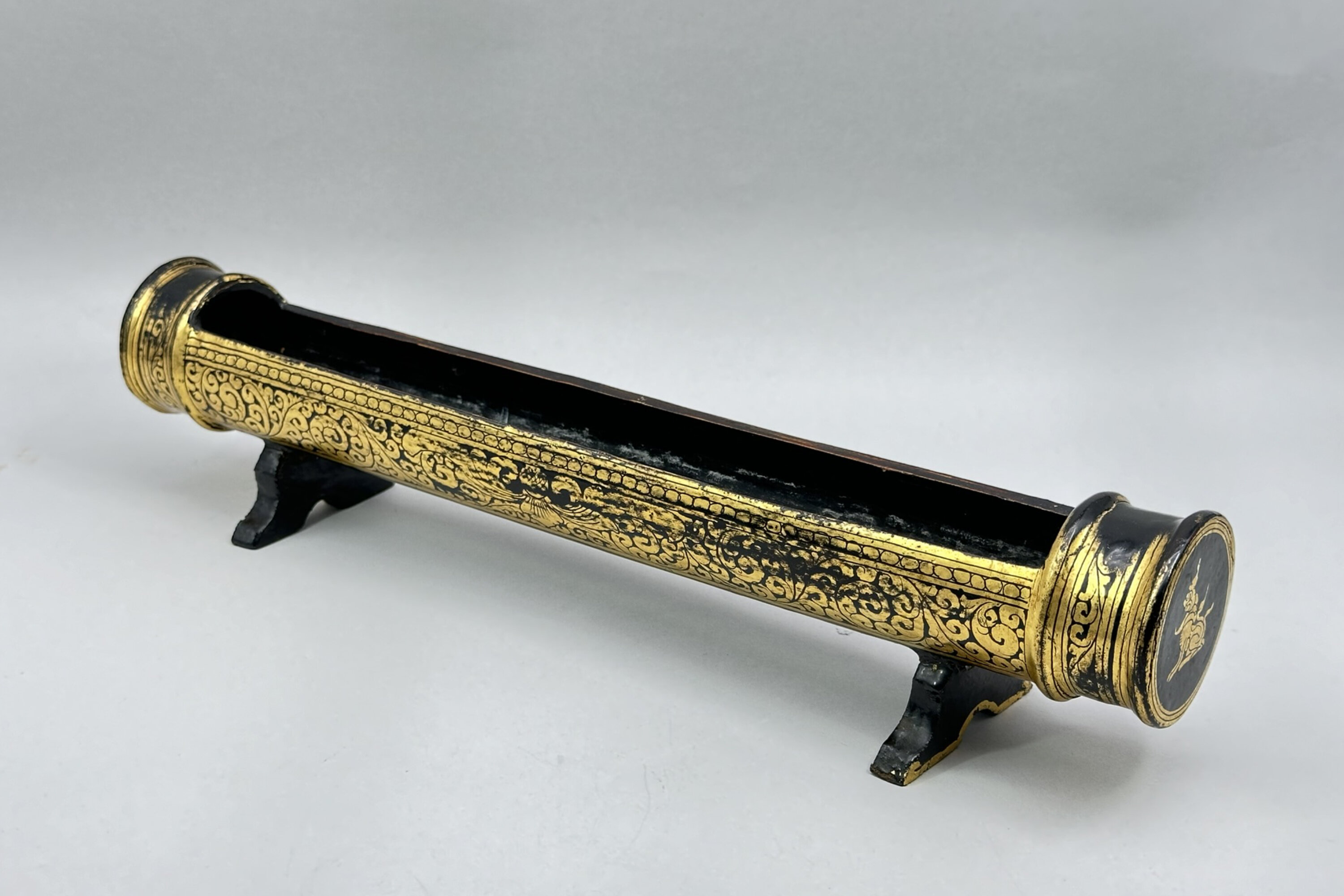
Burmese Black Lacquer and Gilt Scroll Stand, C20th
Price: £25
Blue Ground Empire Style Powder Box and Cover, Jean Pouyat, Limoges circa 1900
Price: £75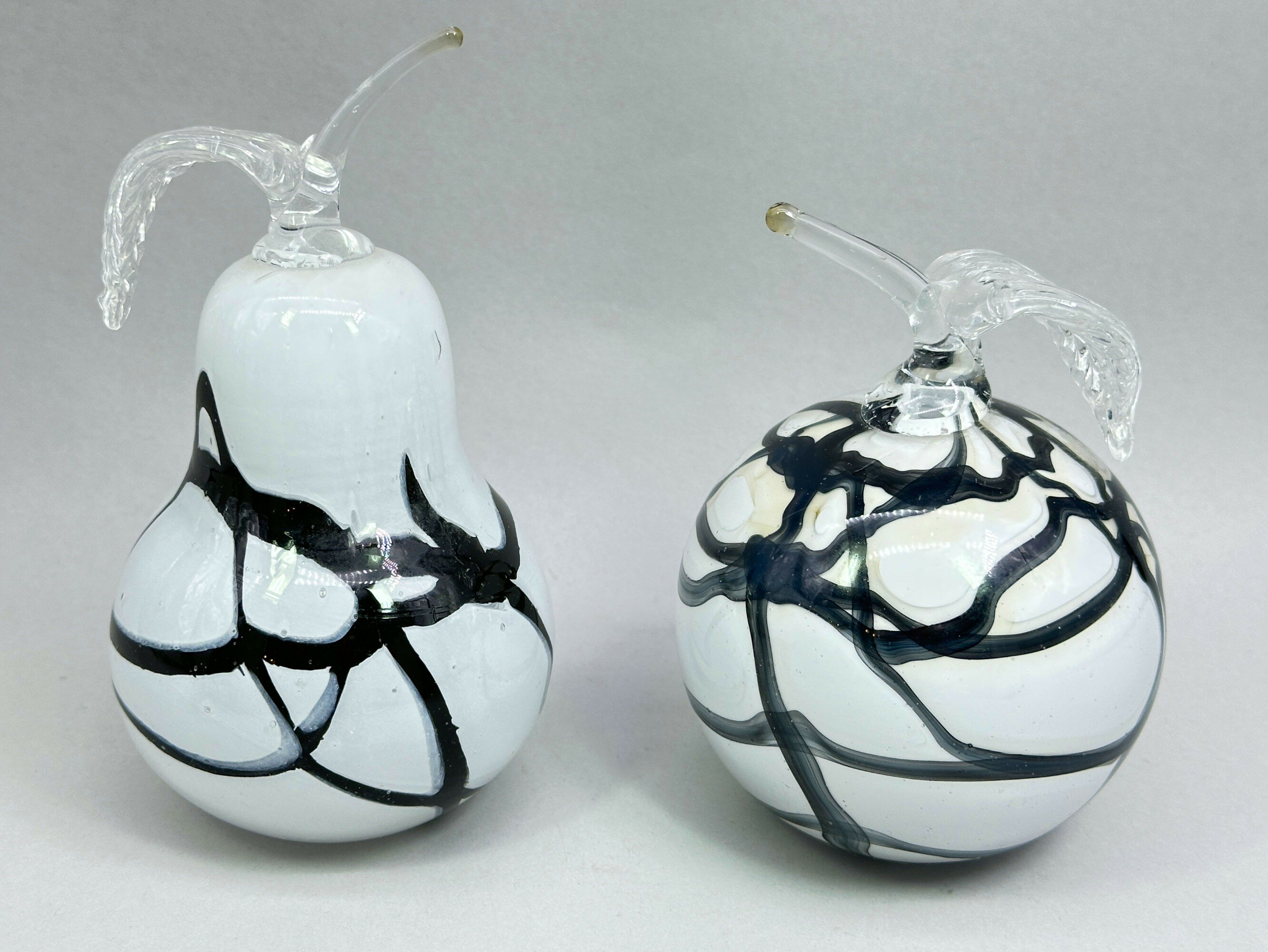
Two Amelia Art Glass Vases, Apple and Pear
Price: £30
Art Deco Flower Vase, Frog and Stand, Bagley Glass, Spinette Range, 1930s
Price: £45Bagley Glass was established in Knottingly, England (south east of Leeds) in 1871. Bottle makers at first they branched out in 1912 and opened a department 'The Crystal Glass company' which made crystal and pressed glass. But it was for the latter that Bagley were to become famous and they became the biggest manufacturer of pressed glass in England in the years before and after the war. Many of their designs were influenced by the Art Nouveau styles and this flower vase, unusually presented complete with its frog and stand, is a classic example of their range.
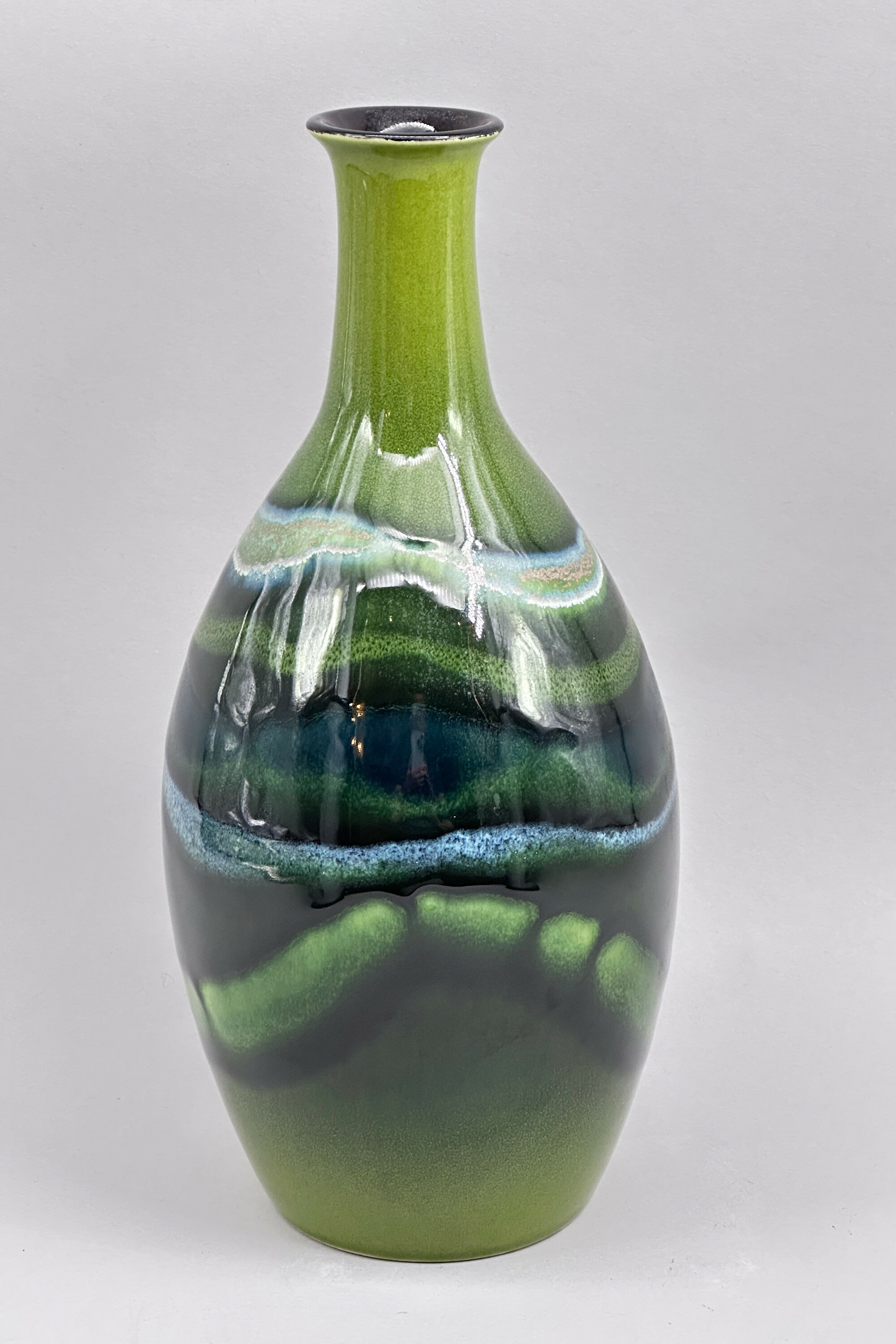
Poole Pottery Maya Pattern Bottle Vase, early C21st
Price: £85This fine quality vase is from the Maya range made by Poole Pottery, some of the pieces still being in production today and described in the maker’s catalogue as follows “Poole Pottery’s Maya collection is inspired by British landscapes and earthy tones. The greens and blues in this stunning range represent the earth meeting the sky in a natural yet bold design. Here at Poole Pottery, all our Maya ceramics are hand-cast and made using our signature reactive glaze in the famous Middleport Pottery in Staffordshire. The distinctive pieces you see here are created via our Living Glaze technique, where layers of colourful glazes react with one another to create a unique, glossy and dynamic finish.” But this particular form does not appear in the current catalogue and does not seem to be otherwise available. The form of the mark appears on other Poole pieces of more recent manufacture and dating is probably to around twenty years ago. The initials are for the artist’s signature and Poole write “Items are personalised with the artist's own individual mark, adding value to the collectability of each piece.” Given its scarcity, this vase would make an interesting addition to a collection of Poole Pottery aside from being a highly decorative item in its own right.
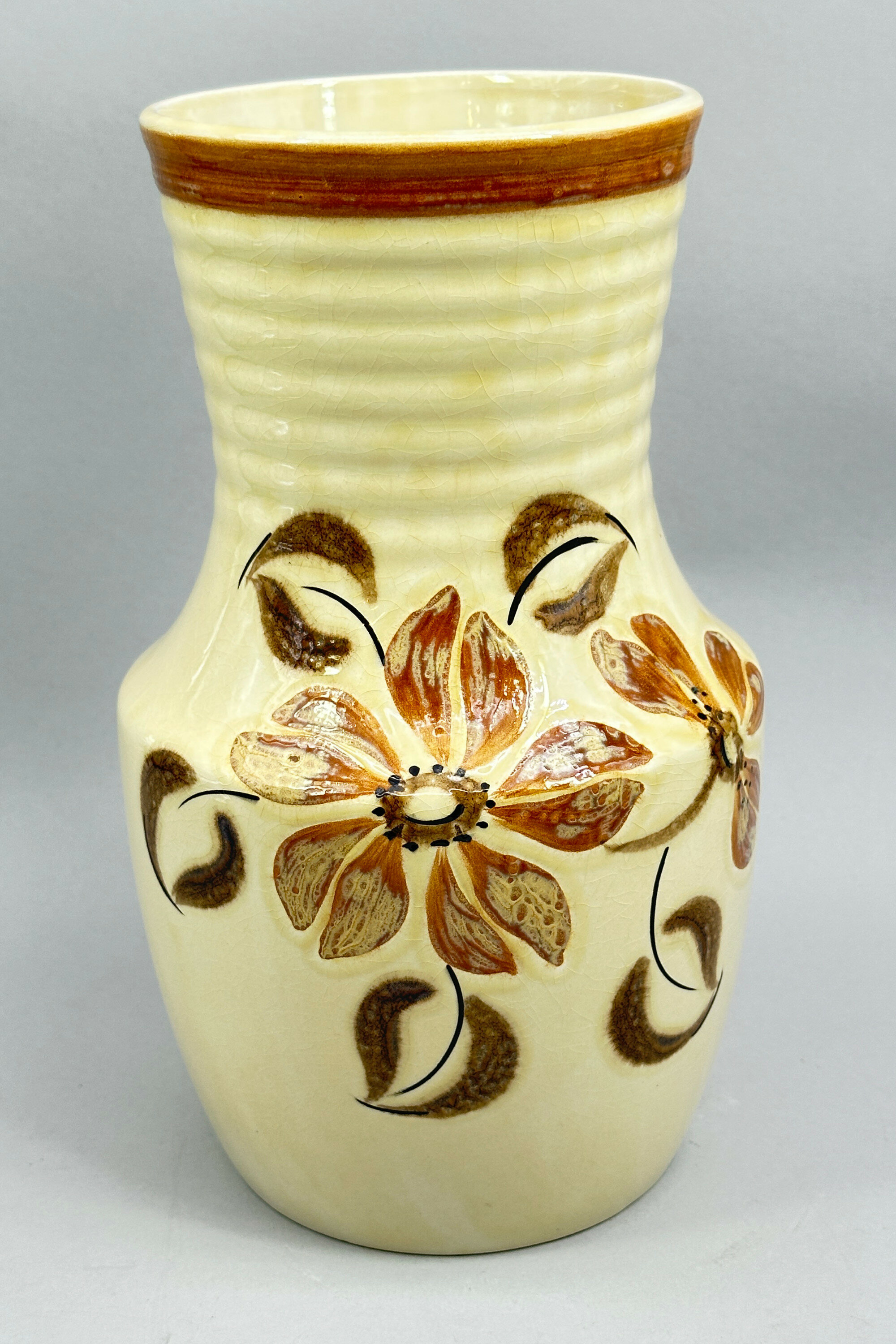
Vase with signature E.Radford and numbered 1267, mid C20th
Price: £45There were, in fact, two craftsmen working in the C20th British pottery industry with the name Edward Radford, father and son. Radford senior worked for Pilkington’s Royal Lancastrian Pottery in Manchester from 1903 until his retirement in 1936, acting as their main thrower. Radford junior joined his Father in 1905, but the First World War intervened, in which he won a Military Cross for his actions at Passchendaele in 1917 and afterwards he settled in Stoke on Trent, the heart of Britain’s pottery industry. An association developed with H.J.Wood’s Alexandra Pottery in Burslem who produced a range of wares bearing his name in the 1930s, although Radford himself may have acted as more a salesman than the designer. Production continued after the war and even after Radford’s retirement in 1948. The form of mark used here implies a later dating and both the shape, indicated by the model number underneath which is found on other vases with different decoration, and the decoration itself suggest the post war era, probably in the 1950s. There is, though, a modest charm here which would blend comfortably with a modern interior.
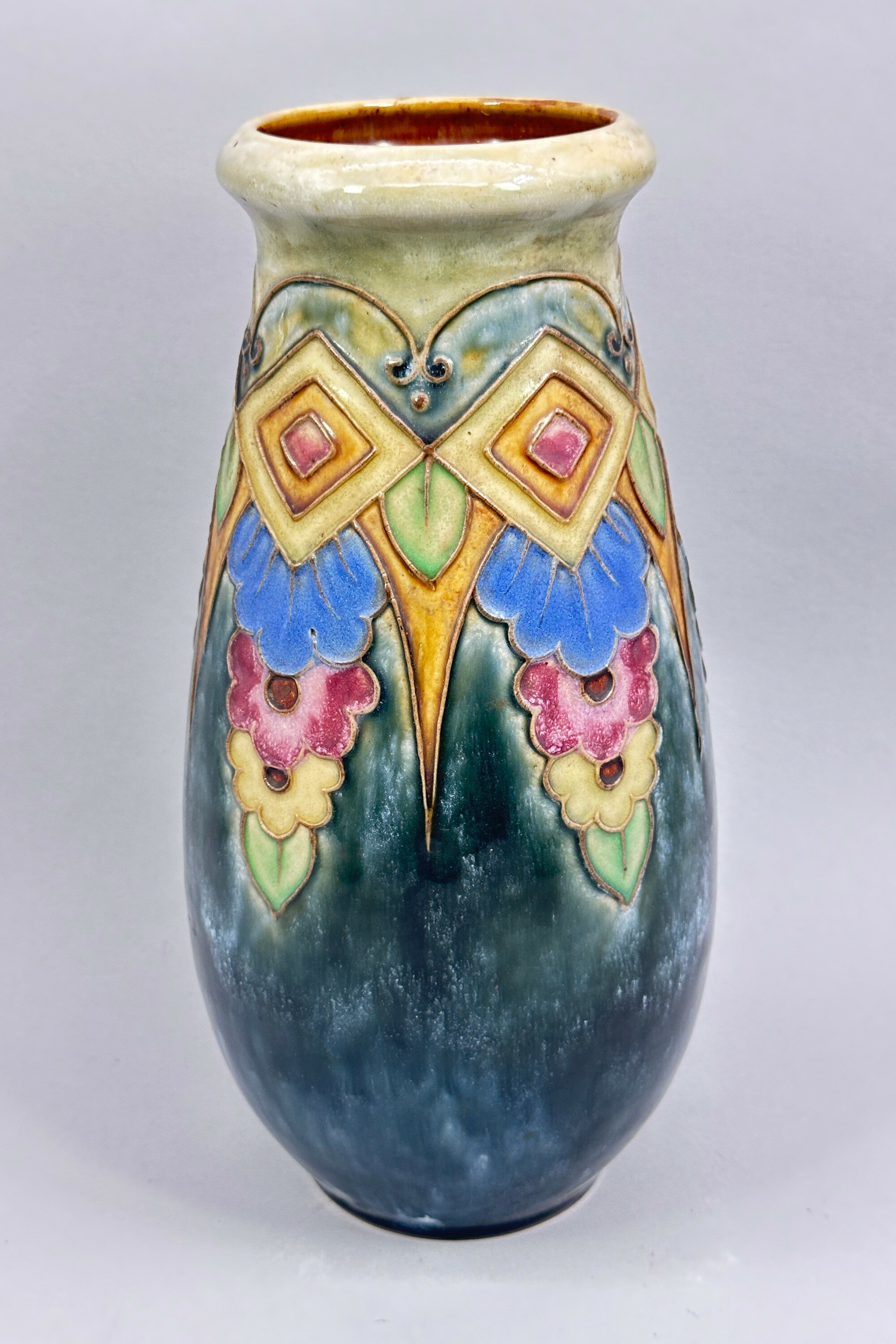
Doulton Vase with geometric and floral designs, late 1920s
Price: £75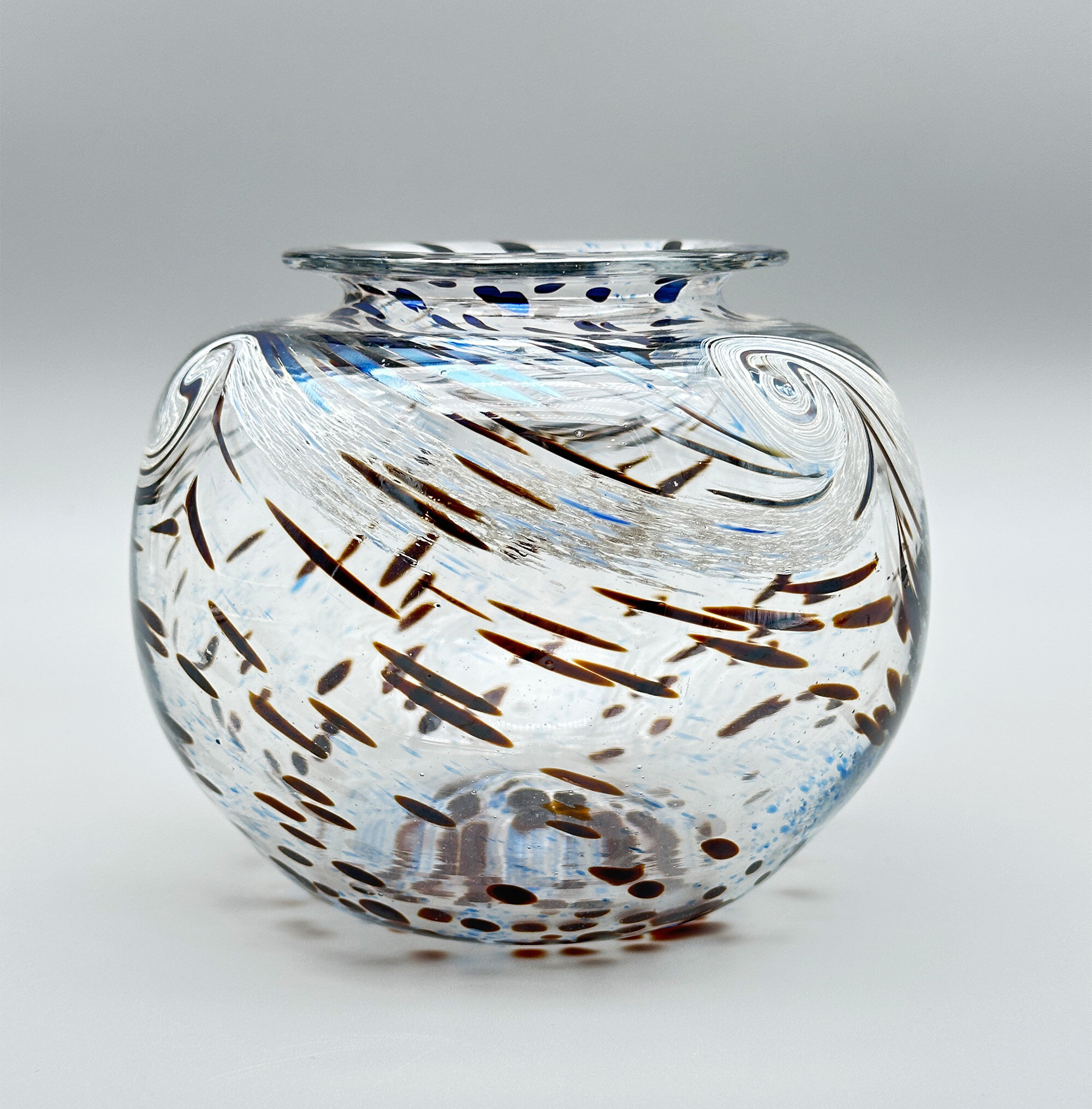
Globular art glass Vase with trailing swirls, signed and dated 1994
Estimate: £30 – 40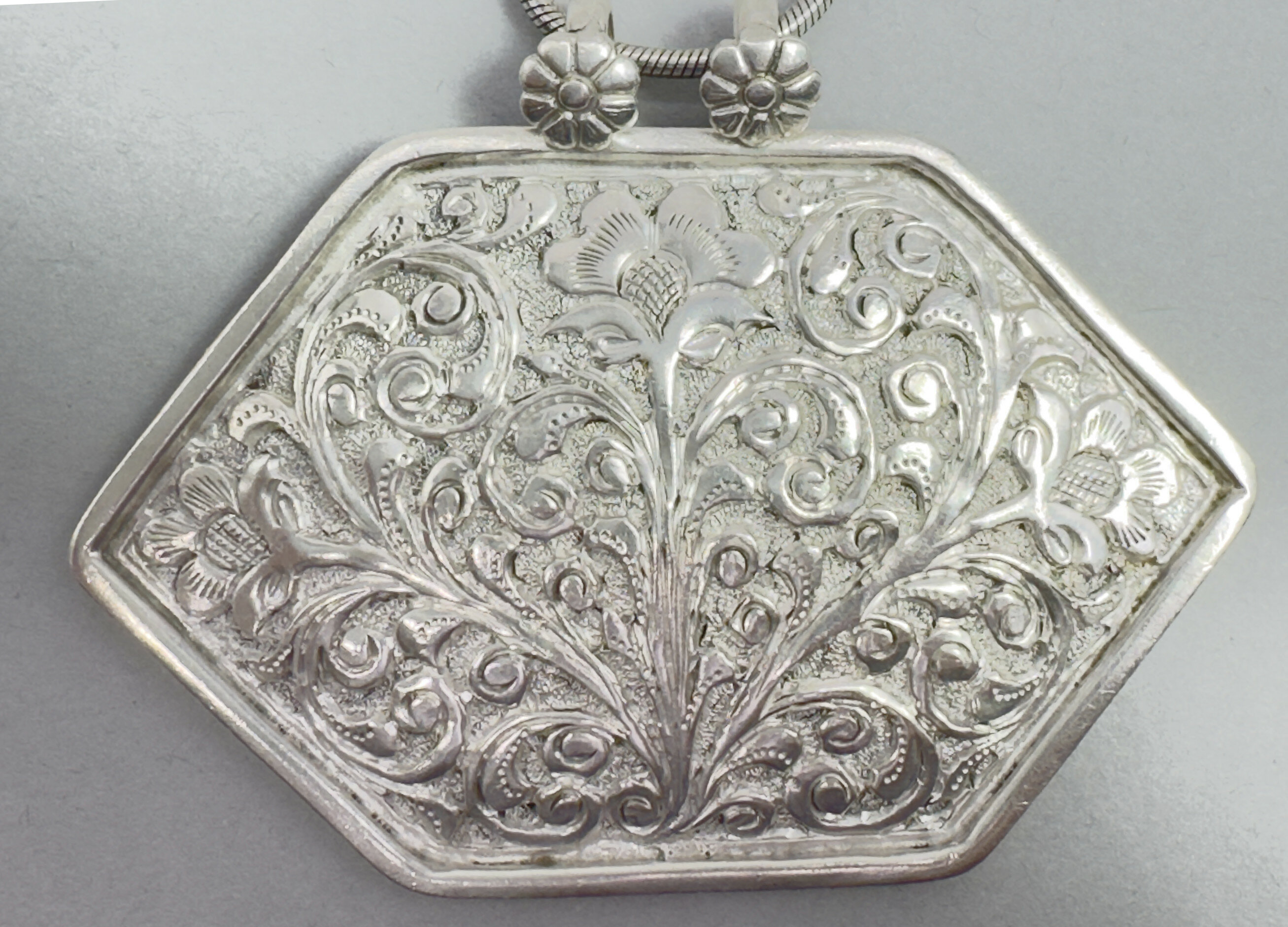
Very fine Indian silver repousse plaque Necklace, c1970
Price: £85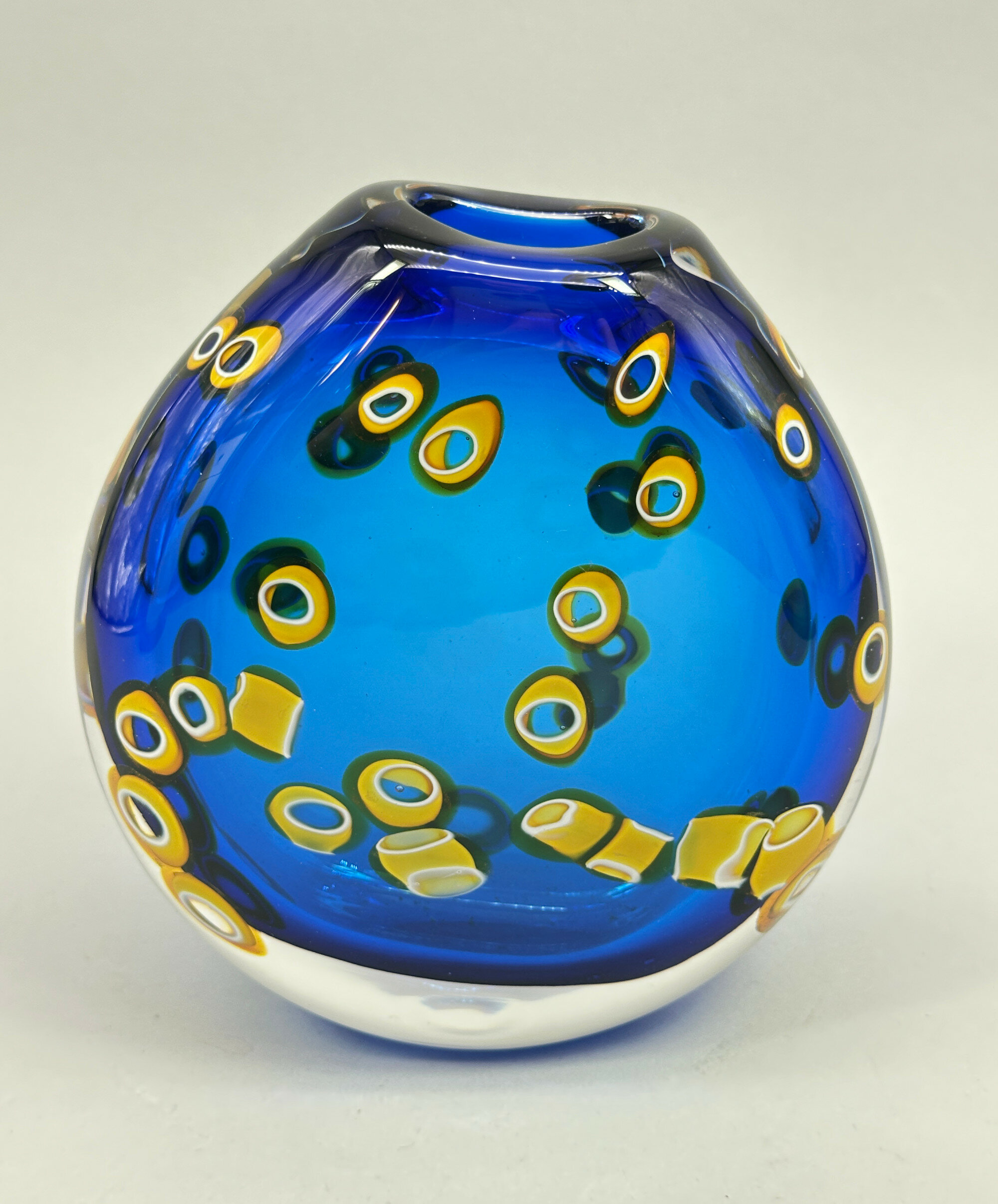
Hula Pattern glass Vase by Bob Crooks, signed by the artist, modern
Price: £110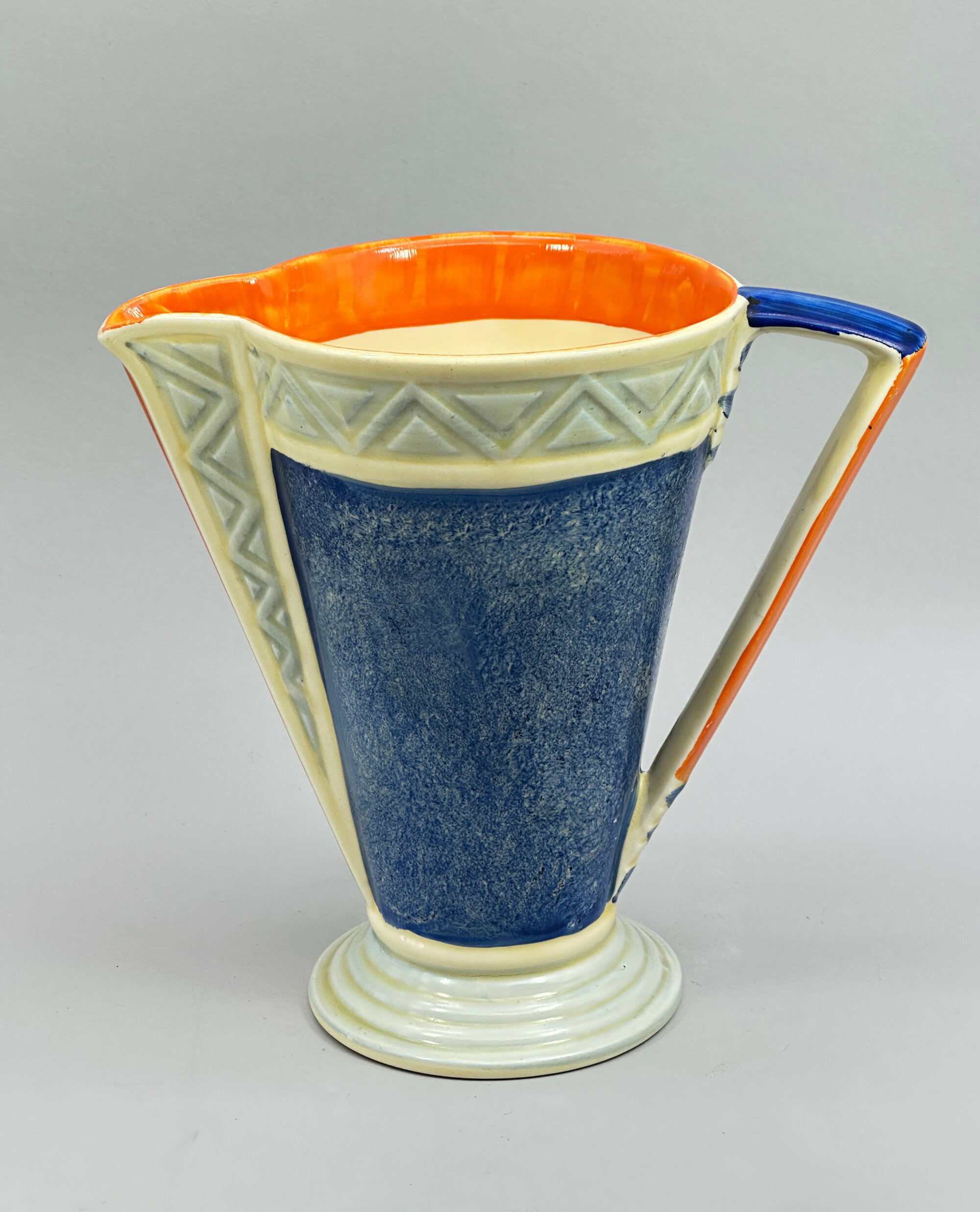
Myott Son & Co Art Deco style Jug, 1930s
Price: £75Myott Son & Co was one of famous the Staffordshire Potteries and traded for over 90 years. Founded in 1898, it began production in Stoke moving to Cobridge four years later. Its output was continuous but in 1949 the firm suffered a disastrous fire which reportedly destroyed the firm's records and pattern books and probably for this reason it relocated to Hanley. In 1969 it was bought by the American firm Interpace, but the Myott name was retained until 1976 when the company merged with Alfred Meakin Ltd, who were based in Tunstall, to form Myott-Meakin Ltd.
Myott now are best known for their Art Deco inspired designs from the 1930s. Following the success of their competitors, most notably the designs of Clarice Cliff, Myott established their own popular following and produced pieces which could rival the output of their celebrated competitors. This jug, with its clean lines and bold colours is an excellent example and like others of the same form bears the pattern umber ‘8498’. Some of their glazes were easily subject to wear and blue was less commonly used so both the condition and the colour range of this jug make it a highly desirable collector’s item.

Chřibská Glass bowl designed by Josef Hospodka, Czech 1970s
Price: £75
Pewter and brass box and cover in the form of a Mallard Duck, Gatco, Hong Kong, 1960s
Price: £25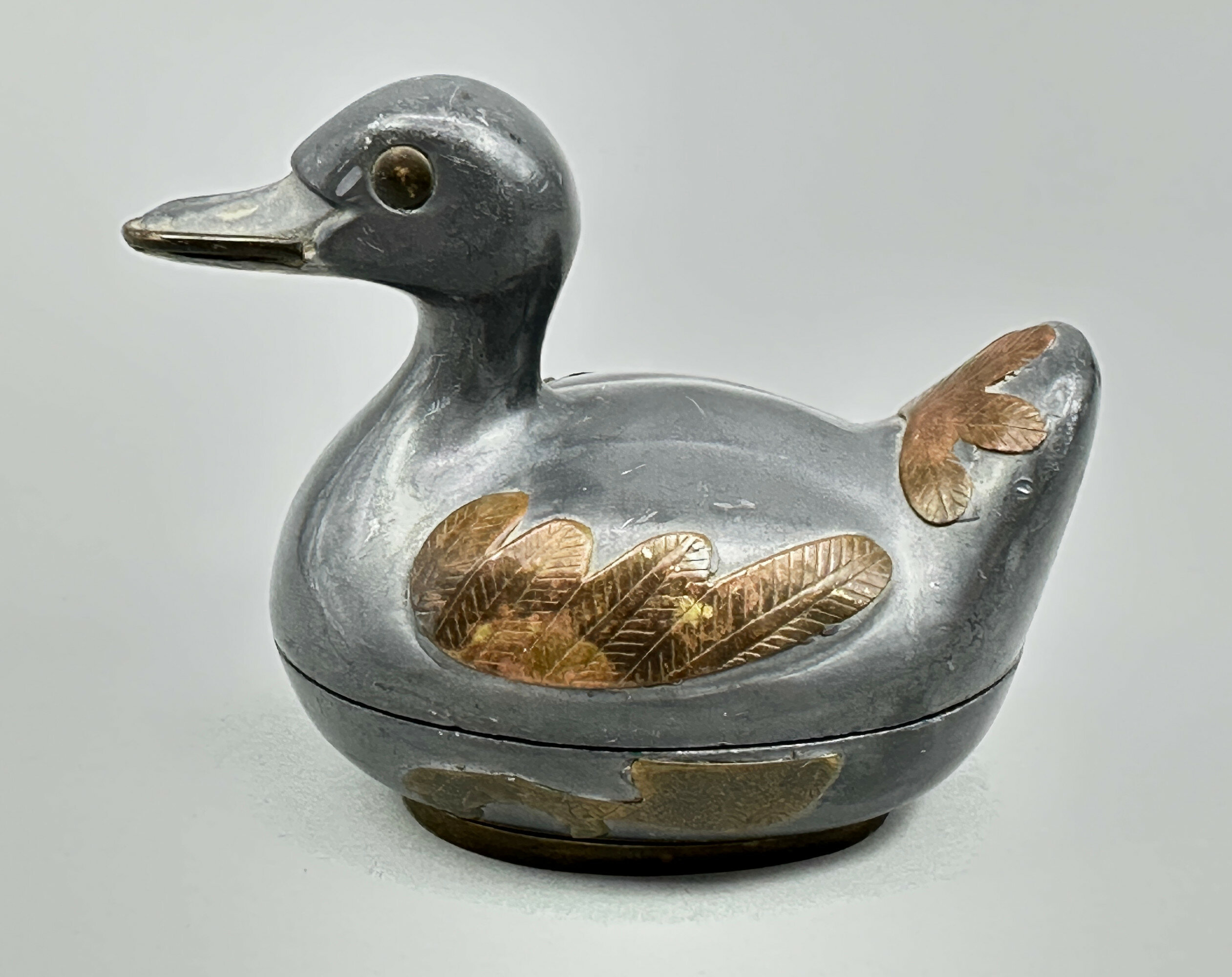
Pewter and brass box and cover in the form of a Mallard Duck, Gatco, Hong Kong, 1960s
Price: £25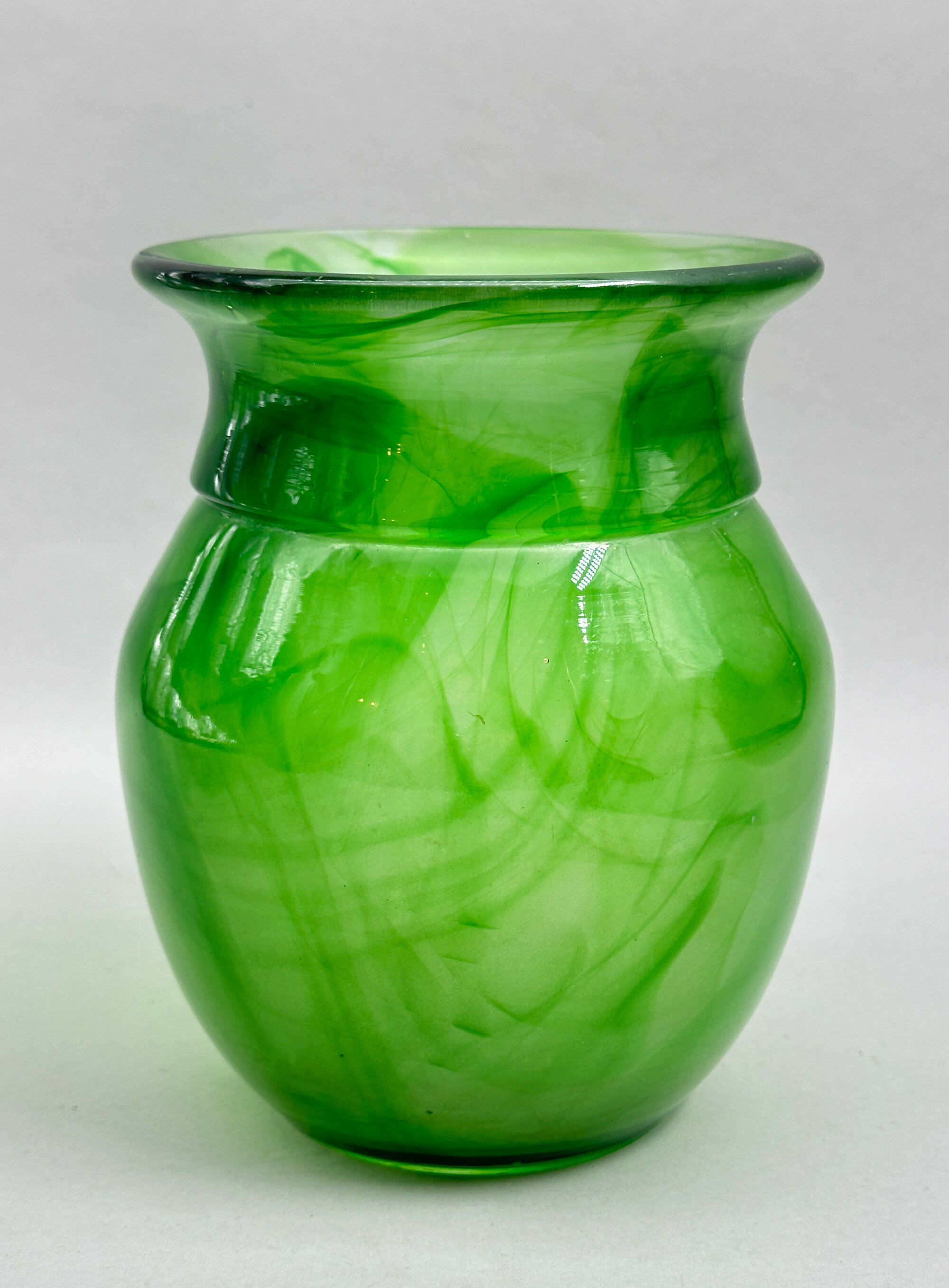
Davidson Green Cloud Glass Vase, 1930s
Price: £55George Davidson founded the Teams Flint Glass Works in 1867, which later became known as George Davidson & Co. In the 1880s the company began producing pressed glass tableware in a variety of shapes and by the 1920s their designs began to reflect the new Art Deco trends. The firm continued production until the 1980s, closing in 1987. This vase is typical of their Art Deco inspired designs although is rather less commonly found today. It has the pattern number '34 'SVF', 'S' standing for 'small', 'V' for 'vase' and 'F' for 'flared rim' and was produced from 1934 to 1942 (see www.cloudglass.com). A slightly larger version was made as well with the pattern number '34' 'VF'. The swirling effect was typical of Davidson's 'cloud glass' designs, one of its most popular ranges. In mint condition, this vase might well fill a gap in a collection of Davidson pieces or pre war British glass generally.
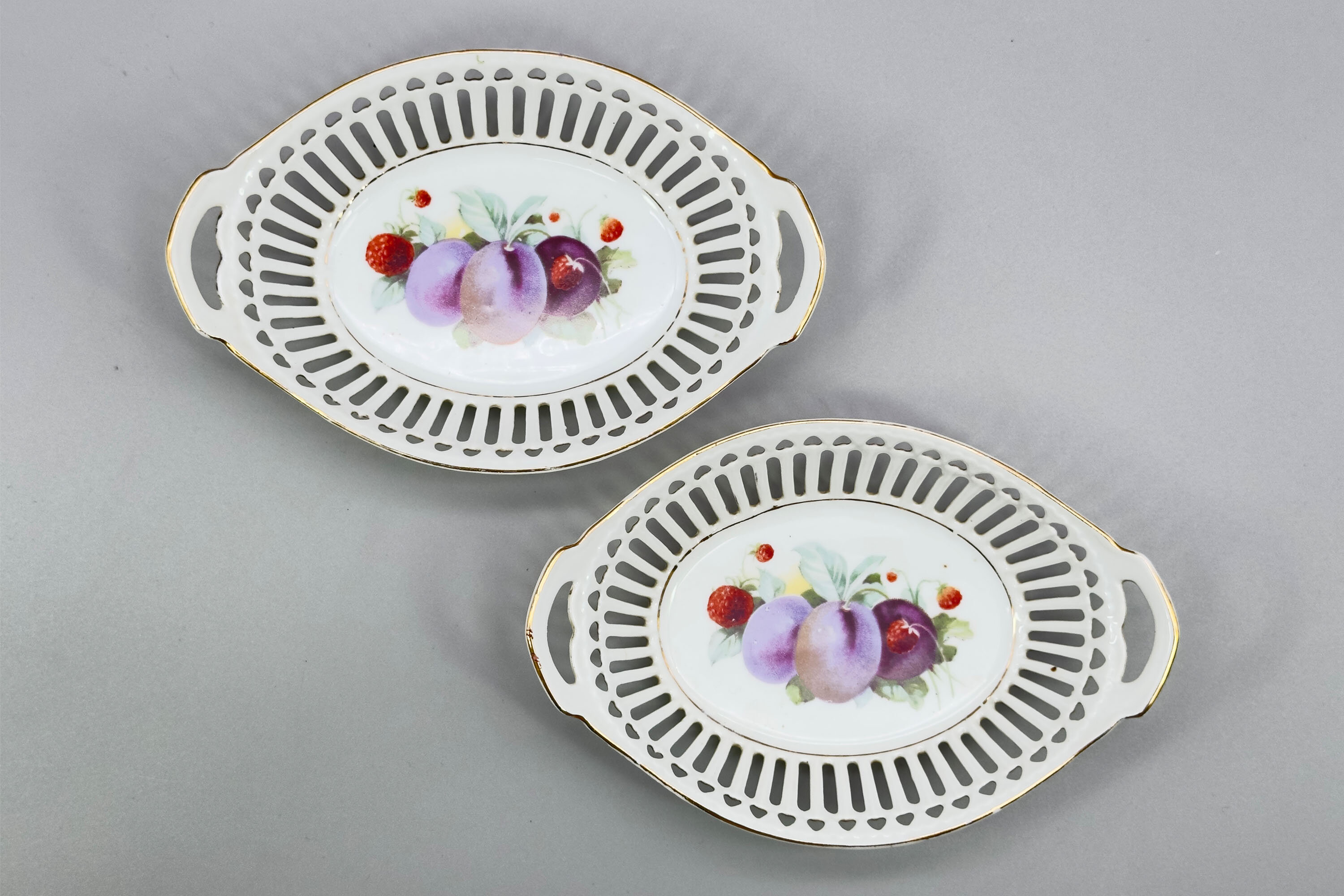
Pair of continental style openwork border Dishes, probably Chinese C20th
Price: £20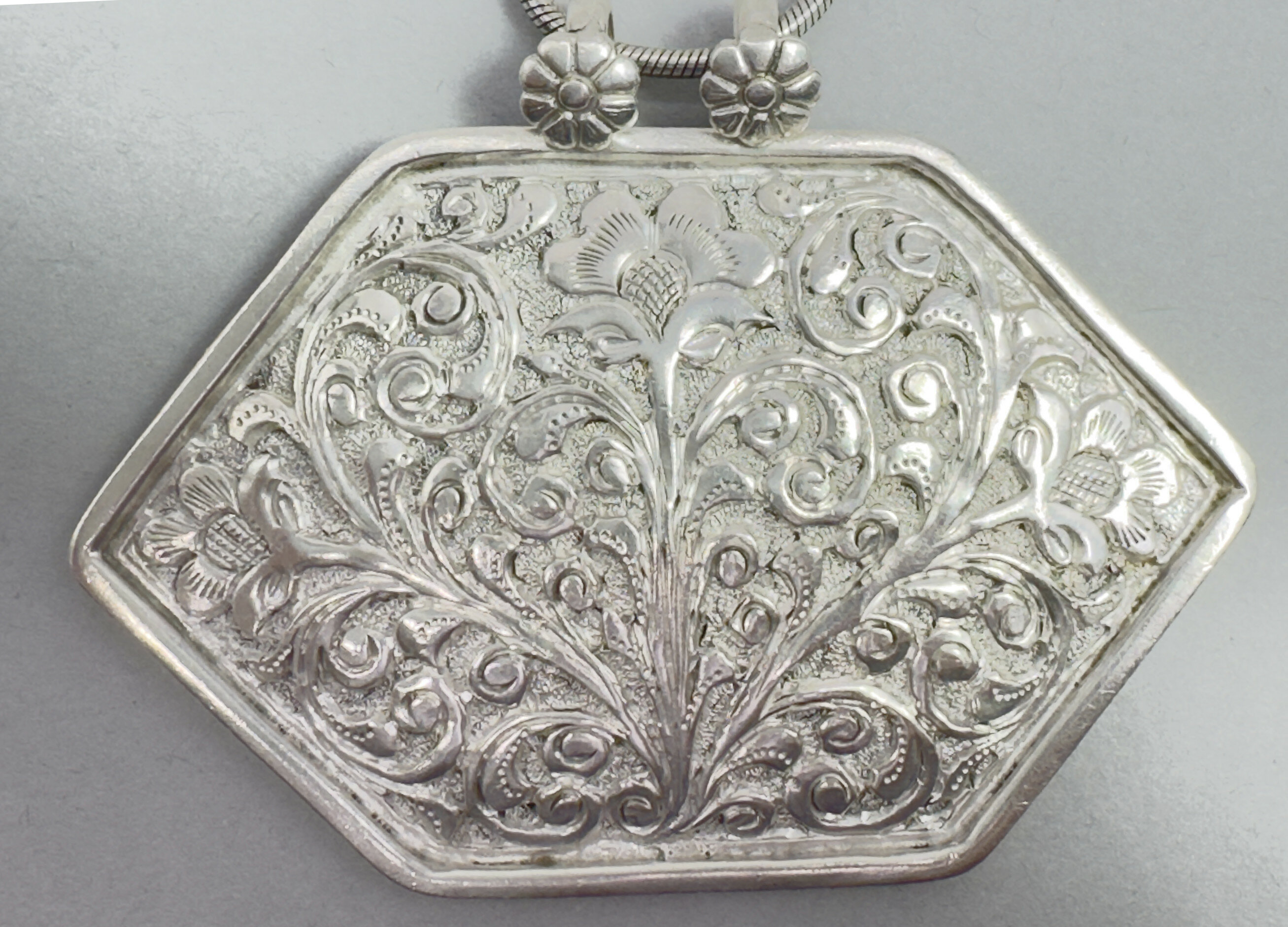
Very fine Indian silver repousse plaque Necklace, c1970
Price: £55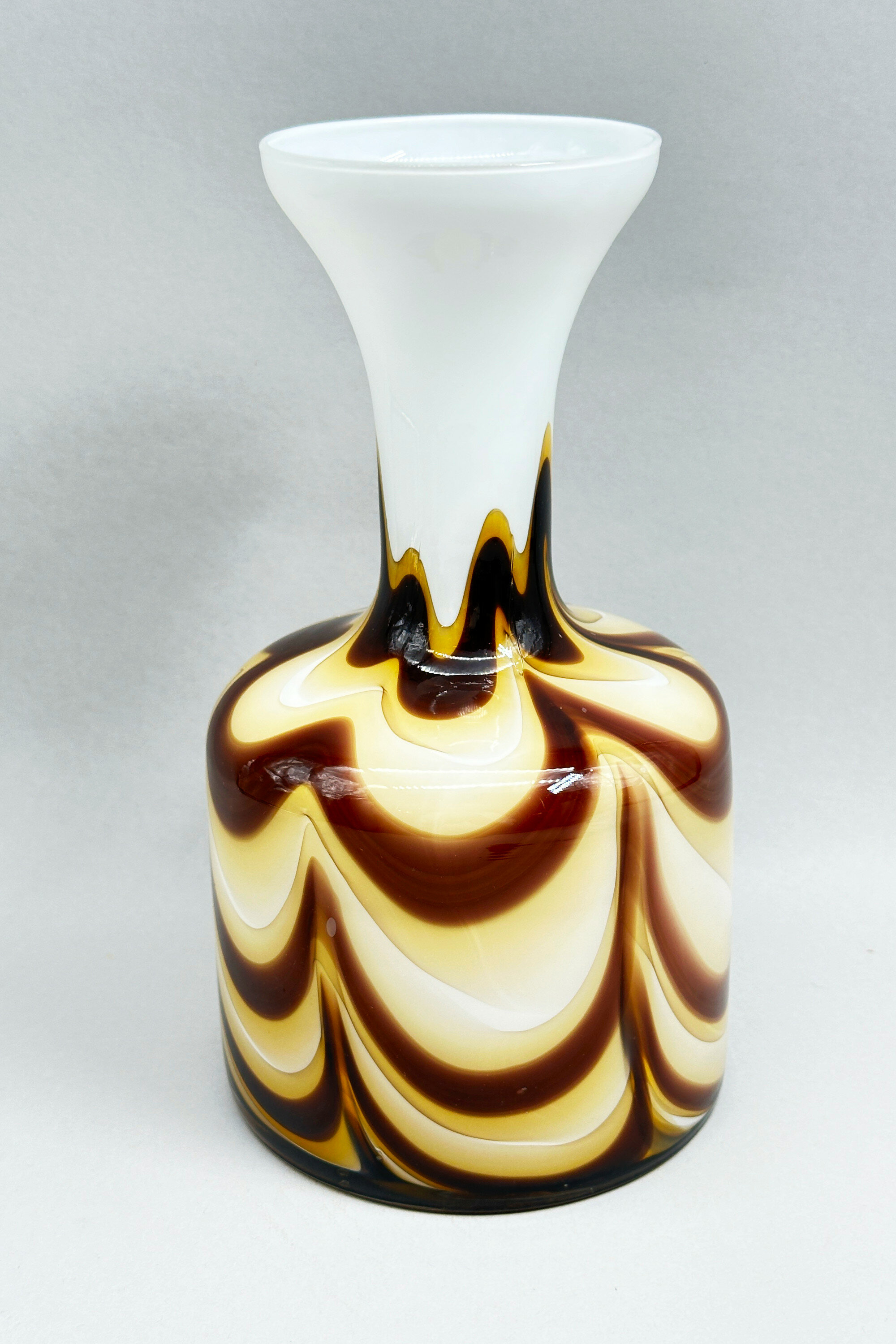
Opaline Art Glass Vase with a marbled design, Vetreria Barbieri, 1970s/1980s
Price: £45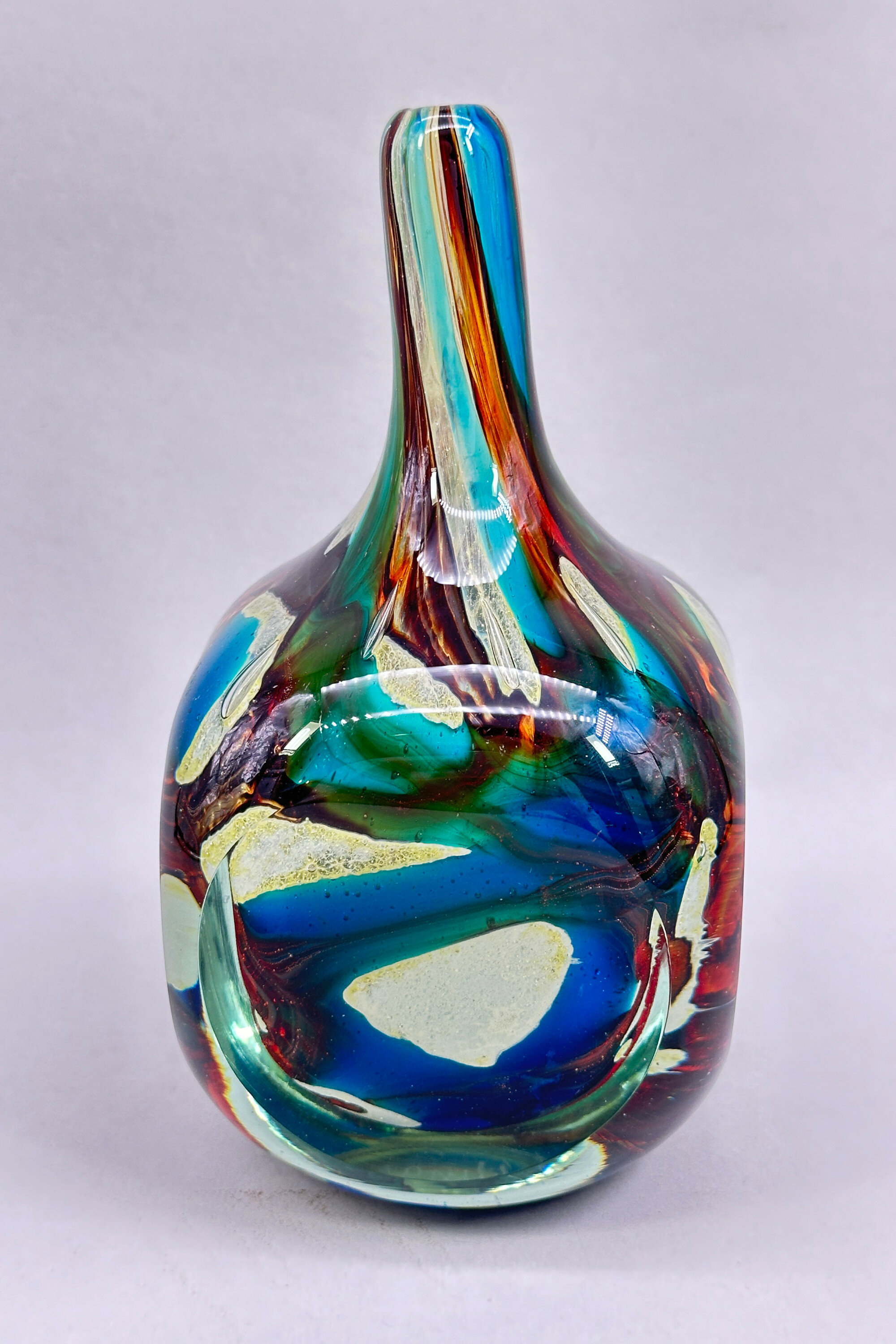
Mdina Art Glass vase, signed and numbered 1979, late C20th
Price: £95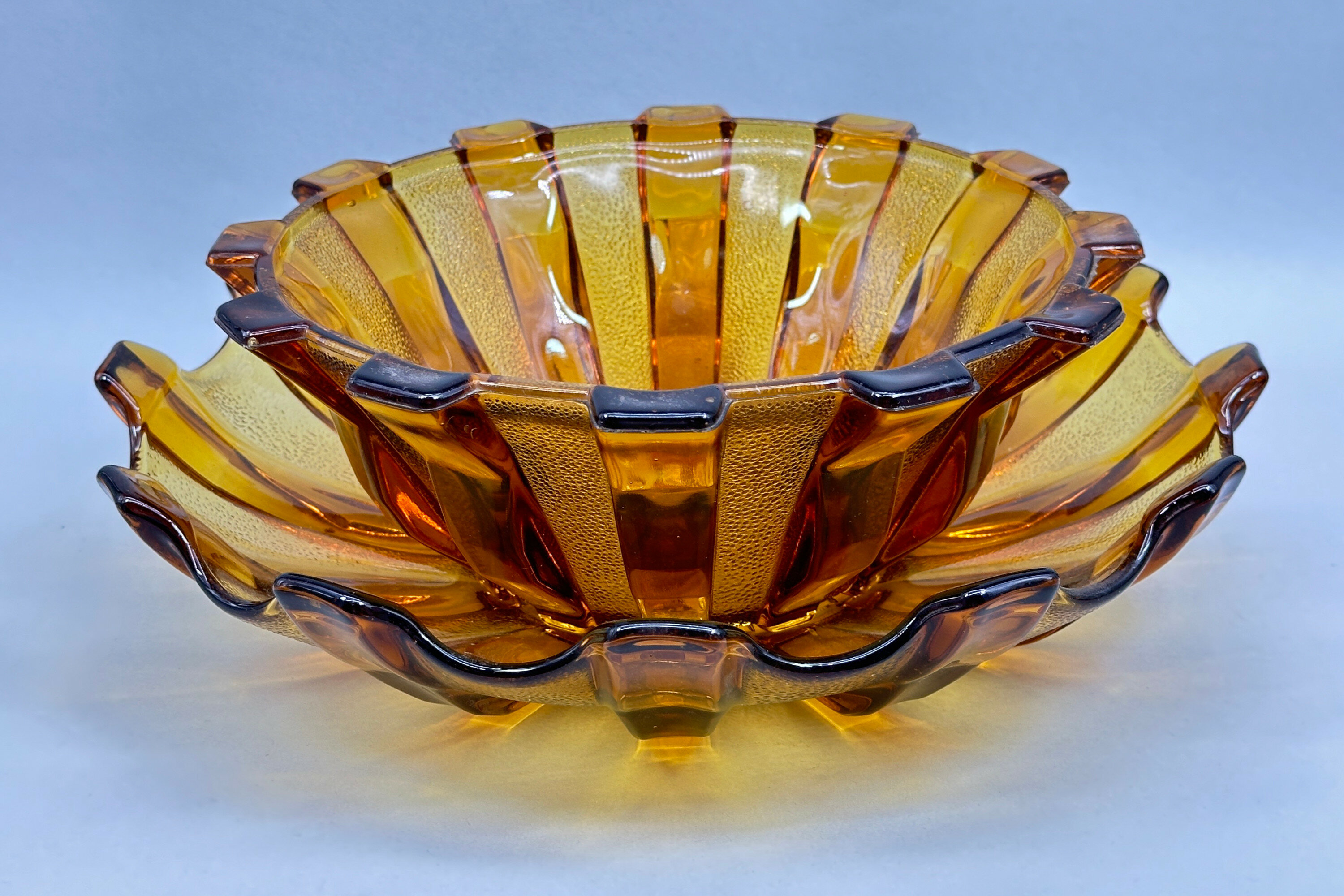
Amber Glass Bowl and stand, Stölzle Hermanova Hut factory, Czech 1930s
Estimate: £40 – 60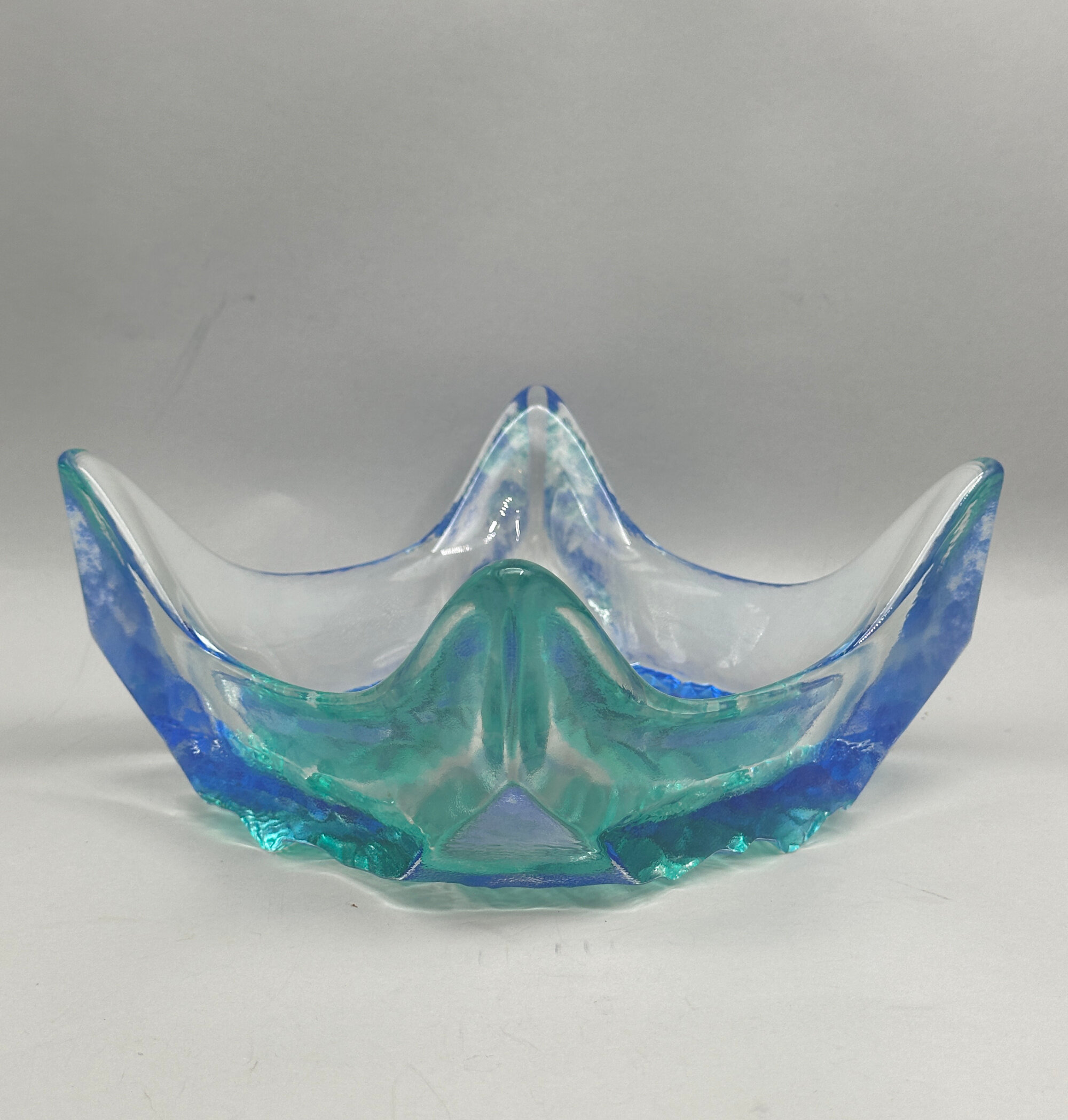
Blue and Green Ice Glass Square Bowl, designed by Tapio Wirkalla for Iitala Finland, late C20th
Price: £55The Finnish designer Tapio Wirkkala (1915–1985) was a major figure of post-war design, working in a wide variety of media including ceramics, wood and glass as well as postage stamps, bank notes and even light bulbs. His first piece for Iitala was produced in 1946 and the commercial ‘Tapio’ collection from 1954. Some of his ‘ice glass’ effects took the Iitala craftsmen many hours to perfect the glass blowing techniques required to produce them but enjoyed immense popularity. These chunky bowls, almost brutalist in style, were produced in the 1970s and 1980s and are an excellent example of his work for the popular market.

Two Wedgwood Glass paperweights designed by Ronald Stennett-Wilson, late C20th
Price: £40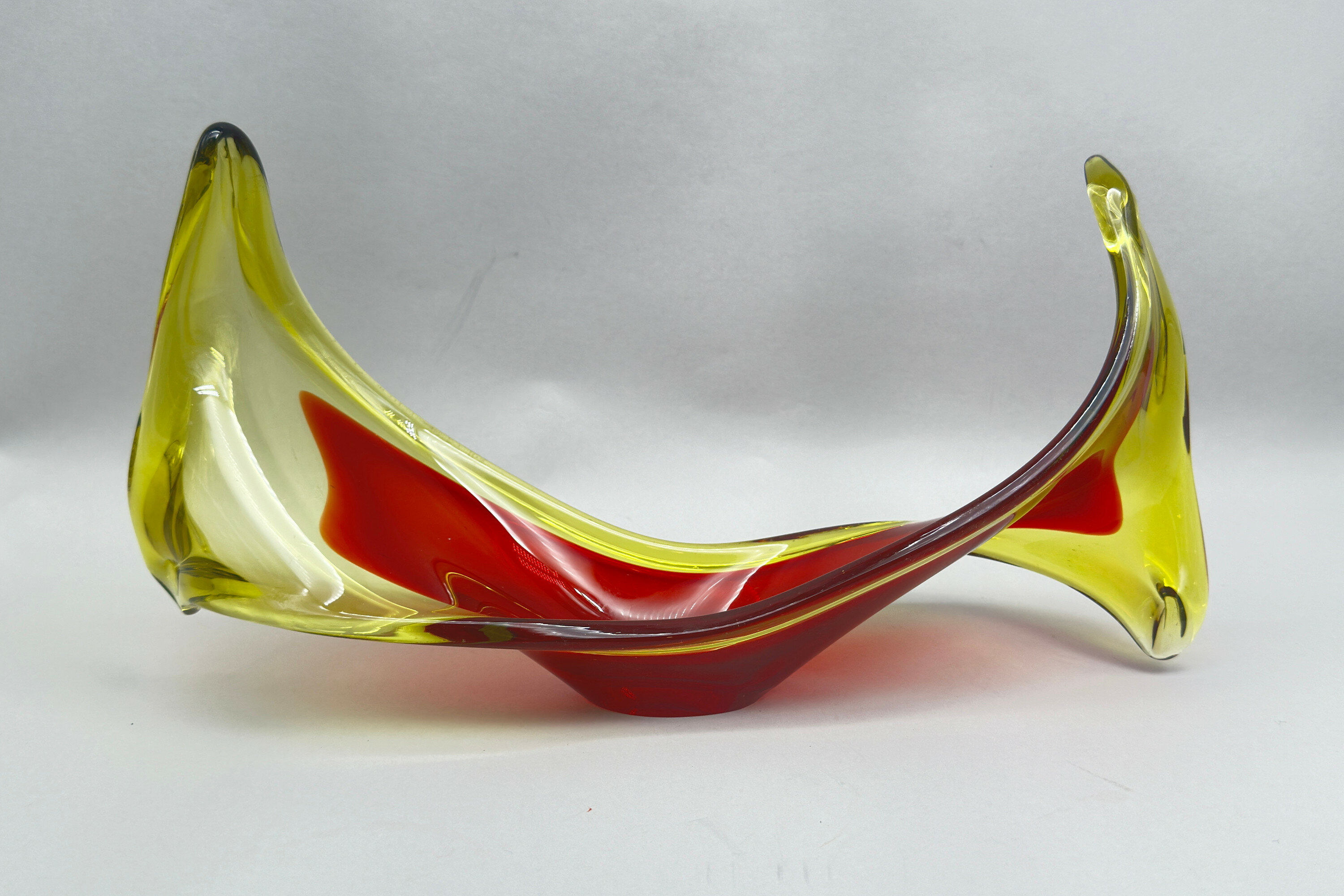
Viartec Murano Style Selenium Red & Orange Glass Sculptural Dish, Spanish 1950s/1960s
Price: £45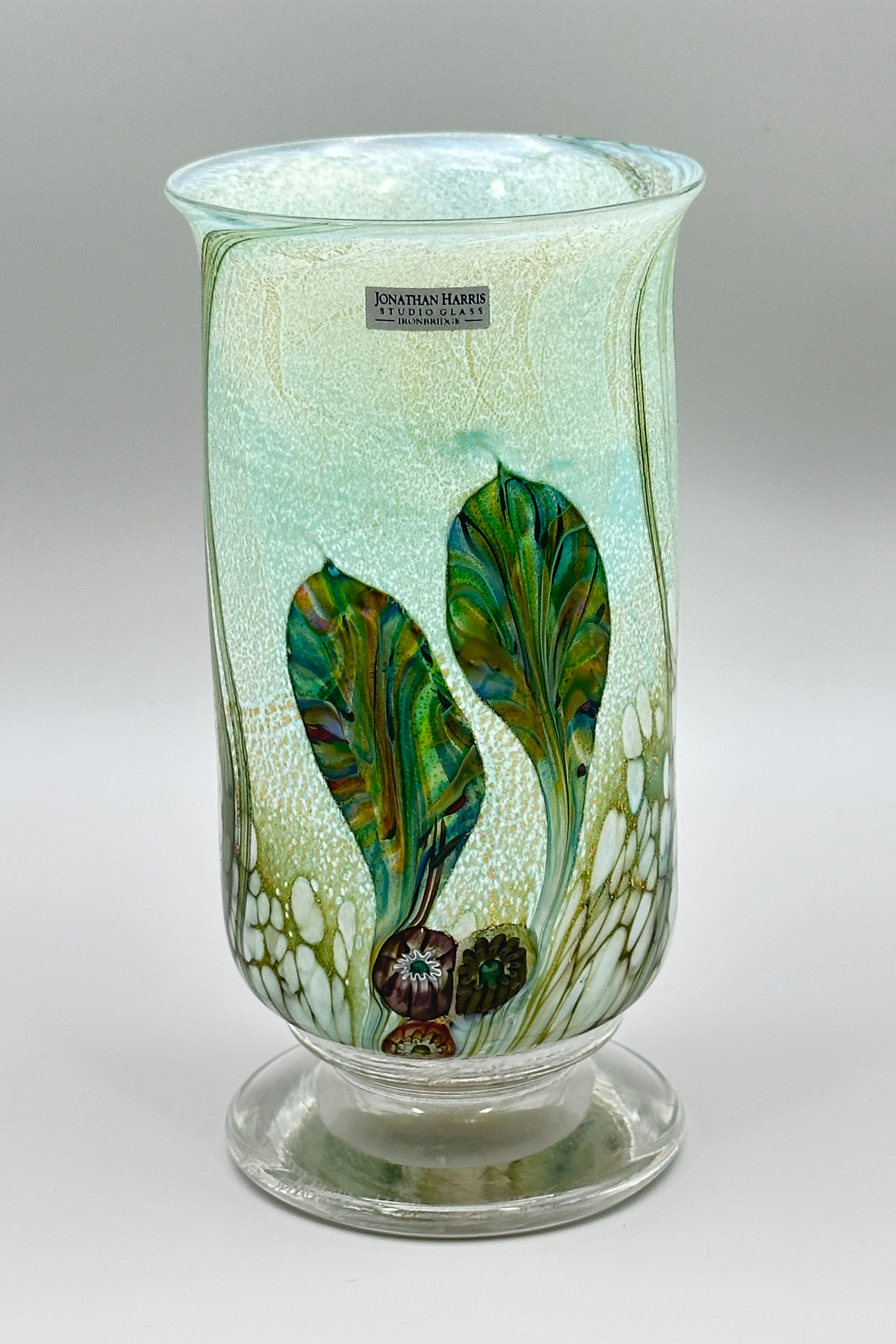
Cameo art glass Vase decorated lilies, Jonathan Harris Glass, signed and dated 2006
Estimate: £60 – 80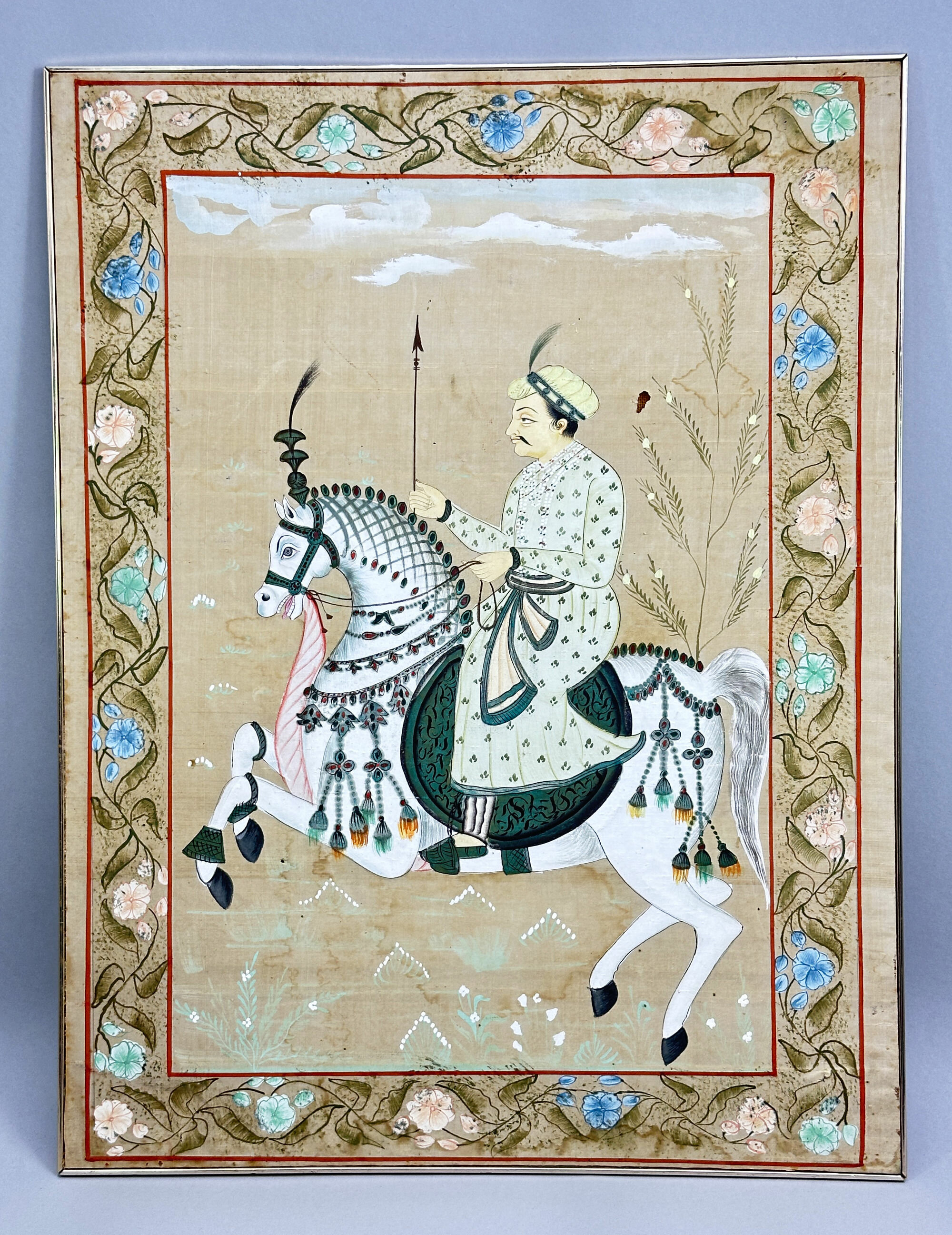
Persian Gouache painting on silk of a horseman, C 19th
Price: £25The style of painting here and the use of silk as the medium are typical of Persian work, and the detail of the brushwork, notably the man’s hair and the horse’s head suggest nineteenth rather than twentieth century workmanship and while a little age worn, this is a striking example of the genre.
Please note that the silk is glued to the hardboard backing at the reverse (see image 10); the simple gilt frame is just fitted to the edge and the piece is not glazed.
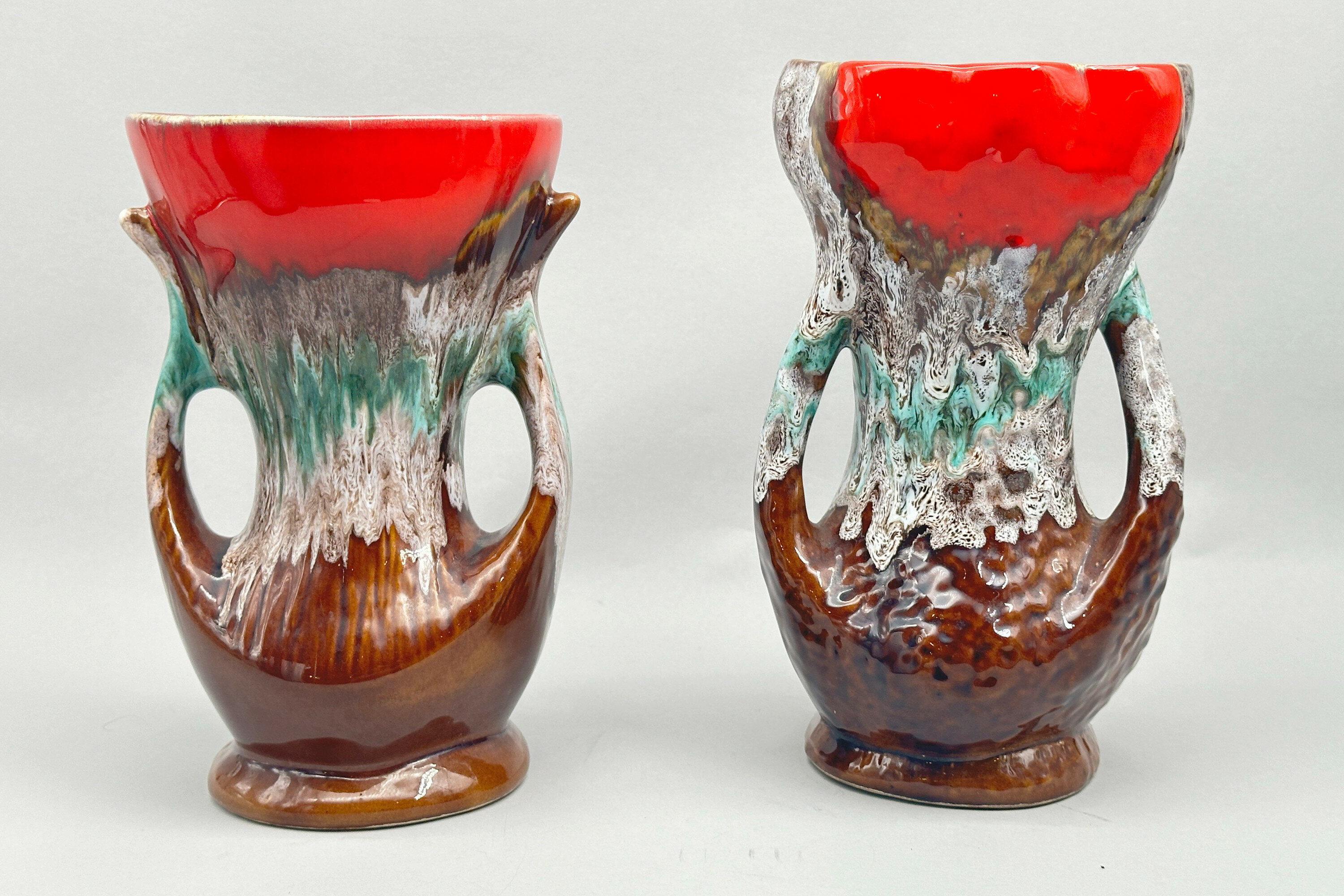
Two Vallauris Lava Vases, French 1950s/1960s
Price: £150………………………………………………………………………………………………….....................................................................
Vallauris is a tourist town of the French Riviera near Antibes taking its name form the Provencal ‘Valauria’ meaning ‘the golden valley’. It is divided into two parts: the upper town which is the old centre and the seaside district which runs from the port along the coast, towards Antibes. Deposits of clay were found there in Roman times giving the impetus for the creation of potteries which tended to concentrate on domestic wares. Production was then continuous with an infux of craftsmen from Genoa, Italy, in the sixteenth century and the development of artistic activity in the seventeenth. The advent of the railways in the late nineteenth century led to an even further expansion of production and companies were established there which achieved widespread fame and recognition notably those of Massier and Foucard-Jourdan.
After the war, Picasso, along with a group of fellow artists, settled in Vallauris and it proved to be a congenial stimulus. He began to experiment with producing ceramics in 1947 and was to continue working extensively in this field until his death in 1973 (see image 12). There were collaborations, one with the ceramicist Robert Picault and another with Suzanne and Georges Ramié, the owners of the Madoura workshop, where Picasso worked on his productions. Indeed it was at the Madoura workshop that Picasso met Jacqueline Roque, a saleswoman working there and 44 years his junior. They married in 1961 and remained together until his death in 1973, Jacqueline being the inspiration for many of the designs which Picasso created.
It would be fanciful, though, to see the influence of the famous artist on these vases although they were very much created in the tradition of Vallauris pottery with which he was so in sympathy. The town seems to have become particularly fashionable in the 1950s and 1960s and it was around that time that these vases were made. Many pieces were created in lead glazed earthenware, the overall decoration resembling the ‘lava’ glazes used in West German pottery of the same period. These two vases are similar and complementary. The bodies are concave with a short foot and a widely flaring mouth; there are loop handles at each side. The brown glaze at the base is succeeded by a blend of mottled greens and greys and topped with a vibrant red at the mouth. The interiors are glazed brown as is the base with the unglazed foot rim showing the fairly coarse clay used. Some but not all Vallauris pieces are marked and there are many unmarked examples as here. Considerable skill must have been required to produce the variety of glaze effects and the results are striking. As two matching items, these vases have considerable decorative appeal and are worthy examples of a long established tradition of ceramic production.
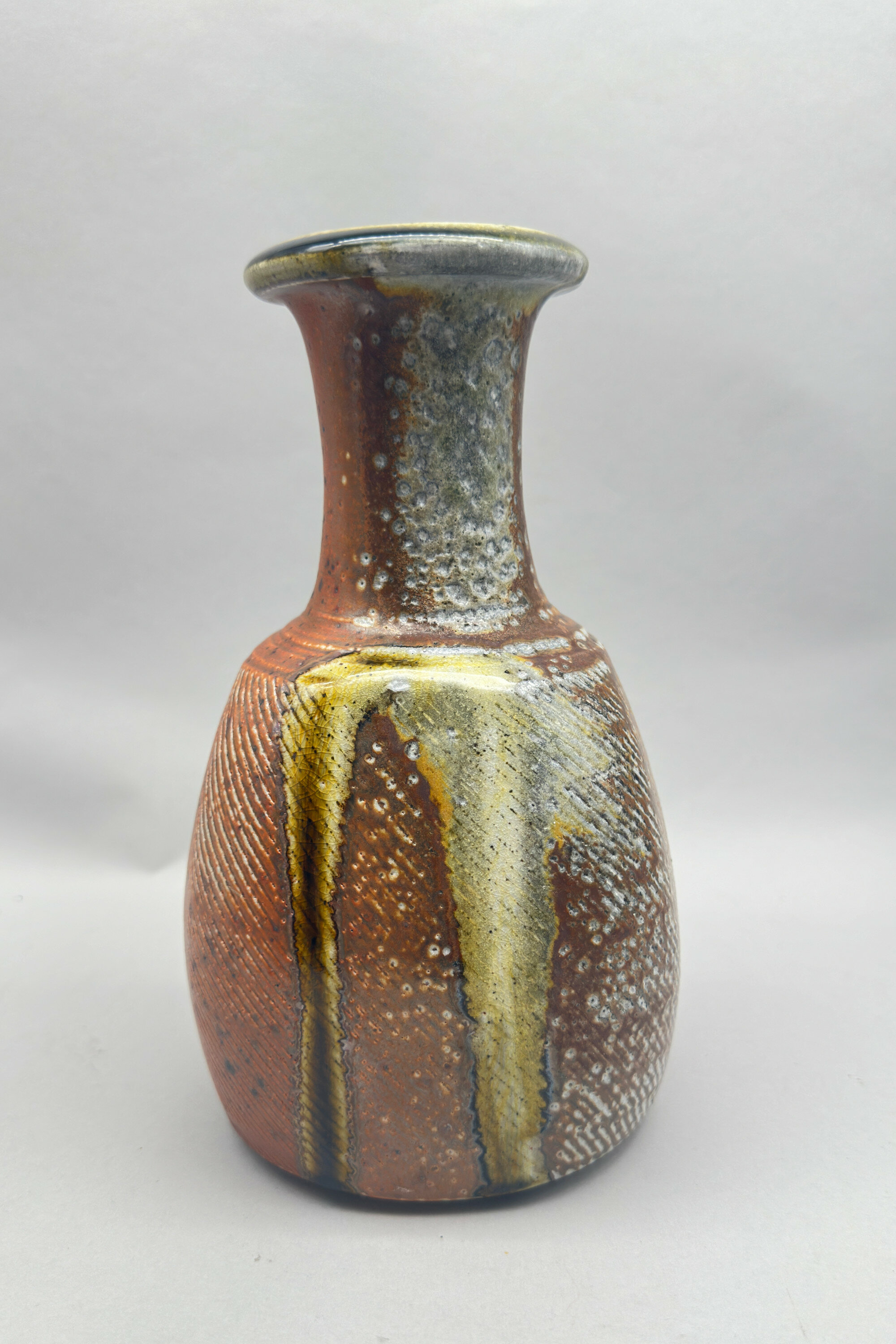
Studio Pottery Vase by John Jelfs, signed, late C20th
Price: £220……………………………………………………………………………………………..................................................................................................................….
John Jelfs was born in Exeter, Devon in 1946 and studied ceramics at the Cheltenham College of Art. In 1973, alongside his wife Jude, also a skilled potter in her own right, he set up his own studio, The Cotswold Pottery Company, in the Cotswolds at Bourton on the Water, from where he has been producing ceramics in a wide variety of forms for over fifty years and still continues to work today. Every piece of his pottery is unique, being made entirely by hand and with the decoration kept to a minimum. Wherever possible locally sourced ingredients of clays, limestone and woodash are used for his glazes of celadon, ochre and shino (a white colour glaze developed in Japan sometimes with red,orange or black spotting).
Jelfs writes himself “From my first exposure to studio pottery I was immediately excited by the work of the late Bernard Leach and his lifelong friend the Japanese potter Shoji Hamada. It was the strength and quietness of their pots which most excited me about their work. For the past few years, I have been concentrating on a range of forms, to which I have applied olive/celadon, ochre and shino glazes made up from wood ash and clay, ingredients both local to my studio. The pots are all hand-thrown from a blend of West-country clays, and are often altered while still soft on the wheel. They are fired twice, the first to biscuit (1000 degrees centigrade) and the second firing to stoneware (1300 degrees Centigrade) in a gas kiln. I use a long firing cycle as this brings out the subtlety and depth in my glazes.”
In more recent years, the construction of a new kiln allowed Jelfs to develop the use of ‘soda glazes’, a complex firing process in which a vapour glaze made of sodium oxide (soda) glazes the clay body of the pottery during the firing process. Sodium materials are introduced into the kiln, usually with a nozzle, at a high temperature of over approximately 1280°C (2350°F). The soda then evaporates and the flame carries the vapour within the kiln, landing on the hot pottery pieces where it fuses with the materials in the clay and any slip decoration applied to it. The soda vapours are colourless and it is the reaction on contact that produces a wide range of colours and textures.
“Since the soda fuses to the surfaces of the work in this way, it blurs the line between pot and glaze/surface; they become one.” — Harrison Levenstein
This elegantly potted vase is a prime example of the technique and the wide variety of glaze effects and textures can be seen and admired. As often, the base is unglazed and in this case marked with the artist's stamp ‘JJ’. The earliest pieces were given an impressed ‘swan’ mark soon to be followed with the wording ‘Bourton on the Water’ in addition. The simple mark of the artist’s initials seems to be later which fits with the use of the ‘soda glaze’ technique developed some years after the pottery studio was set up. Jelfs' work has been widely exhibited in leading galleries including Galerie Besson and the Victoria & Albert Museum in London, Alpha House in Sherborne, Beaux Arts, Bath, and the Rufford Ceramics Centre in Nottingham. It is also included in many collections around the world and our vase would make a fine addition to any of them.
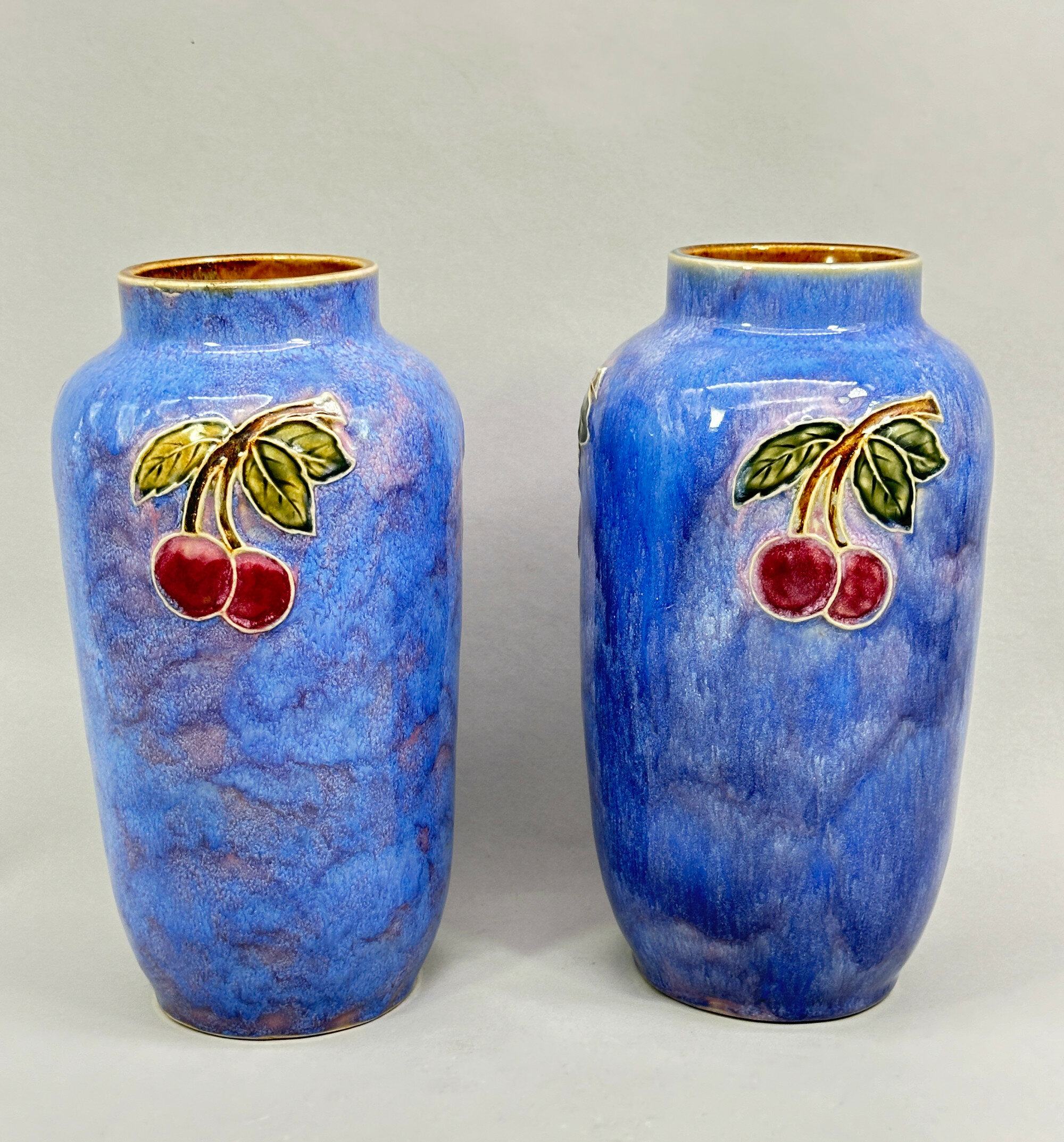
Pair of Royal Doulton Vases decorated Cherries, early C20th
Price: £95The mark for Doulton is one of the standard impressed 'Royal Doulton England' marks where the lettering forms part of a circle combined with three thick lines and the centre is filled with four interlocking 'D's. The addition of a lion but not with the usual accompanying crown allows a fairly precise dating to between 1923 and 1927 which matches with the pattern number ‘8546’, one of the range of numbers used between 1924 and 1927. The artist’s signature cannot be identified but he/she produced a pair of vases of great skill and charm which follow the Art Deco trends fashionable at the time.
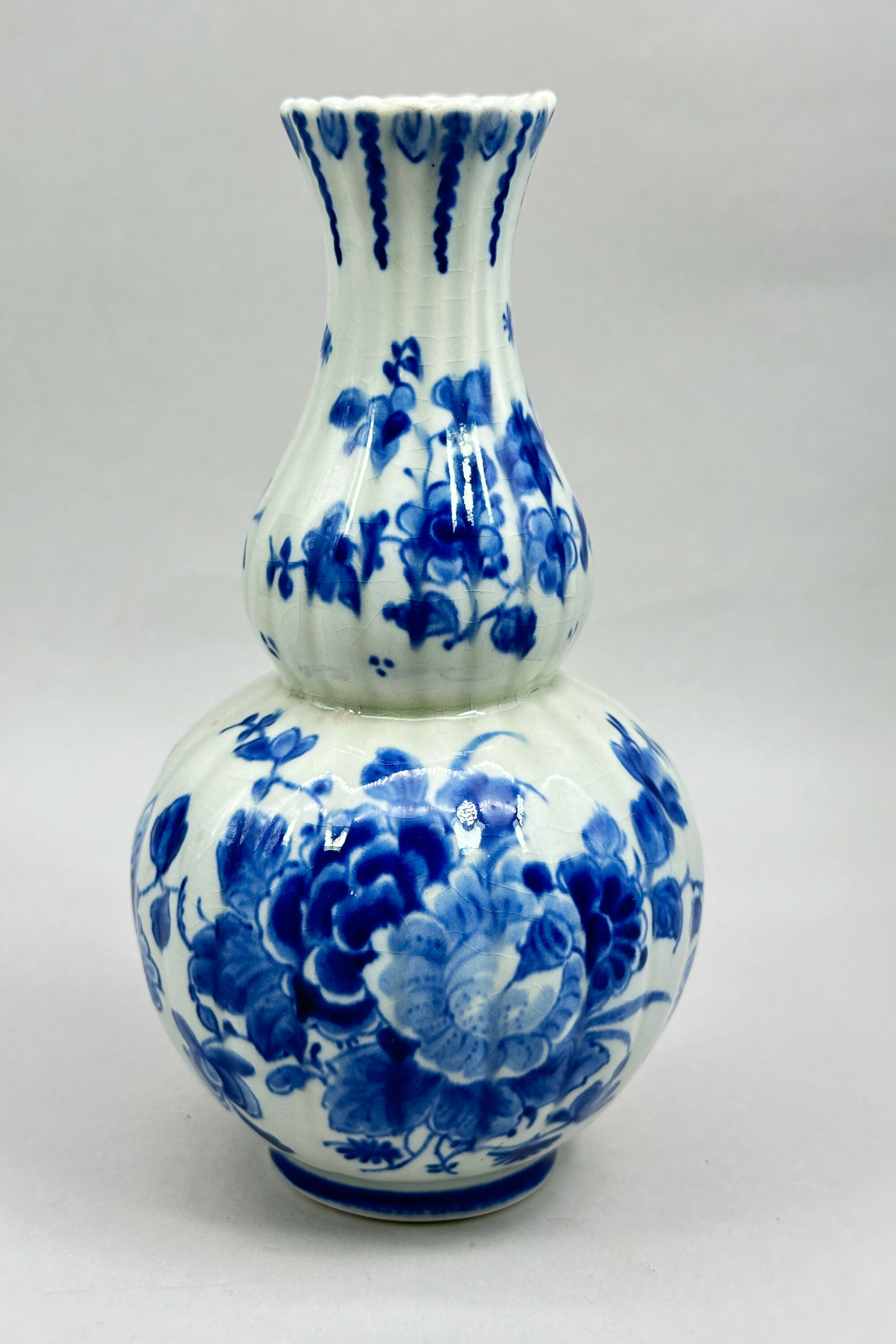
Dutch Delft Blue and White Gourd Vase in C18th Style, late C20th
Price: £25This vase is typical of one of these later creations and copies an eighteenth century original which itself was based on Chinese pieces. The marks underneath, although some of them are blurred, offer a clue to the dating. Below an ‘A’ at the top can be seen a vase which stands for ‘De Porcelyne Fles (The Porcelain Bottle) a factory which was established in 1653 and continues production today. There follow the initials ‘JT’ as a monogram standing for Joost Thooft who bought the factory in 1876 and below this ‘Delft’. At the bottom are usually found the painter’s initials to the left and letters to the right which are the date mark. On this vase these are unclear but the painter’s initials read ‘MA’ which appears to stand for M.H.van Aalst who worked for the firm from 1941to 1983. This would fit with a likely dating here to the second half of the twentieth century, but the artist has successfully recreated the work of his predecessors and produced a piece of great charm.
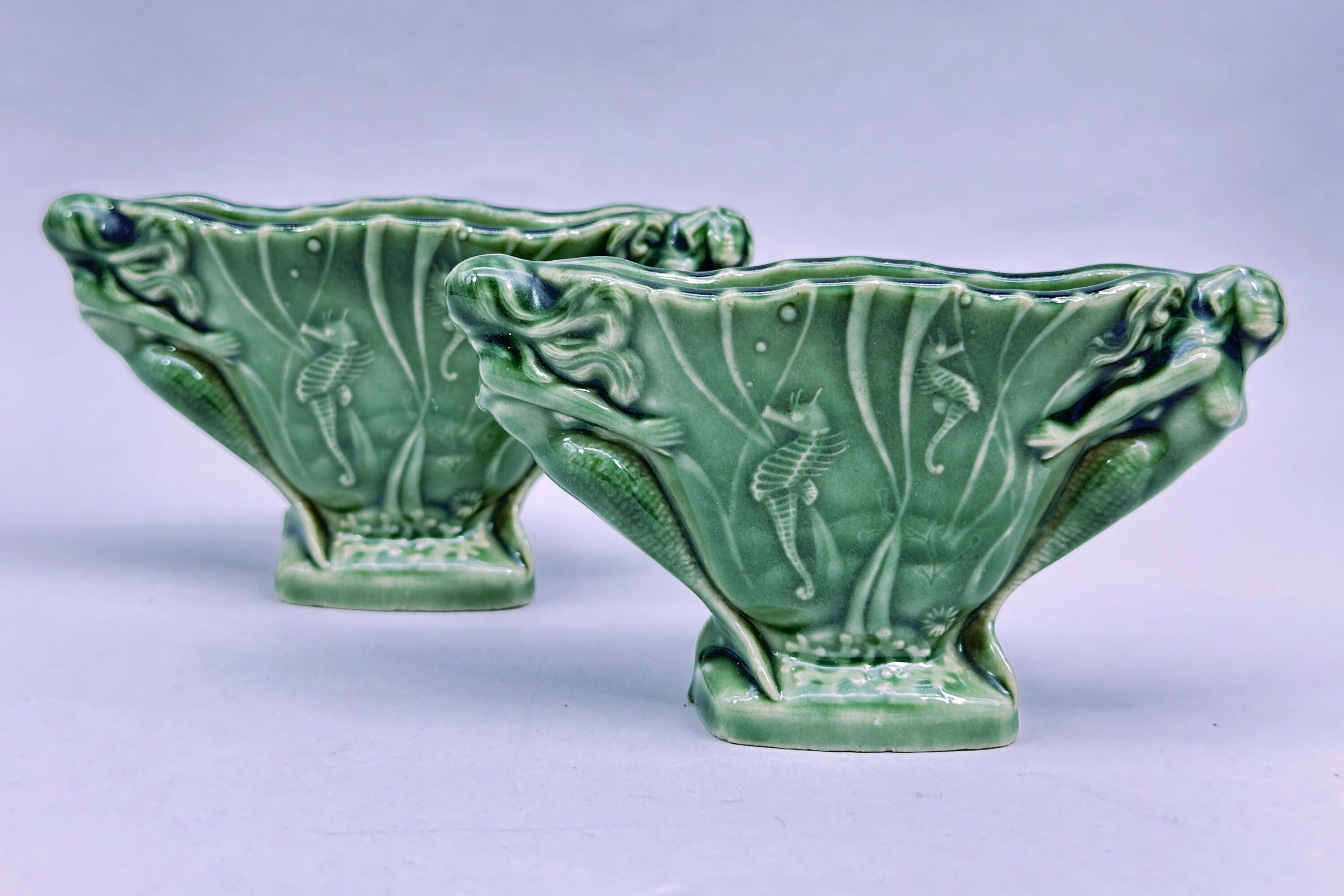
Pair of Wade green glazed Mermaid salts, 1950s
Price: £55Wade Ceramics Ltd was a manufacturer of porcelain and earthenware, headquartered in Stoke-on-Trent, England. Founded in 1867, it was run by various members of the Wade family until the death of George Anthony Wade in 1987 after which there was a succession of management buyouts. Despite substantial investment in 2009, the firm eventually went into administration in 2022. Wade produced a wide variety of ceramics, including the well known Wade Whimsies animal figurines.
This pair of salts is rather different to many of their productions and have a distinctly ‘Art Nouveau’ feel but, in fact, date to the 1950s when this particular format of the factory mark was used. It seems to be one of the rarer forms and pairs are even rarer still, so definitely one for Wade collectors!
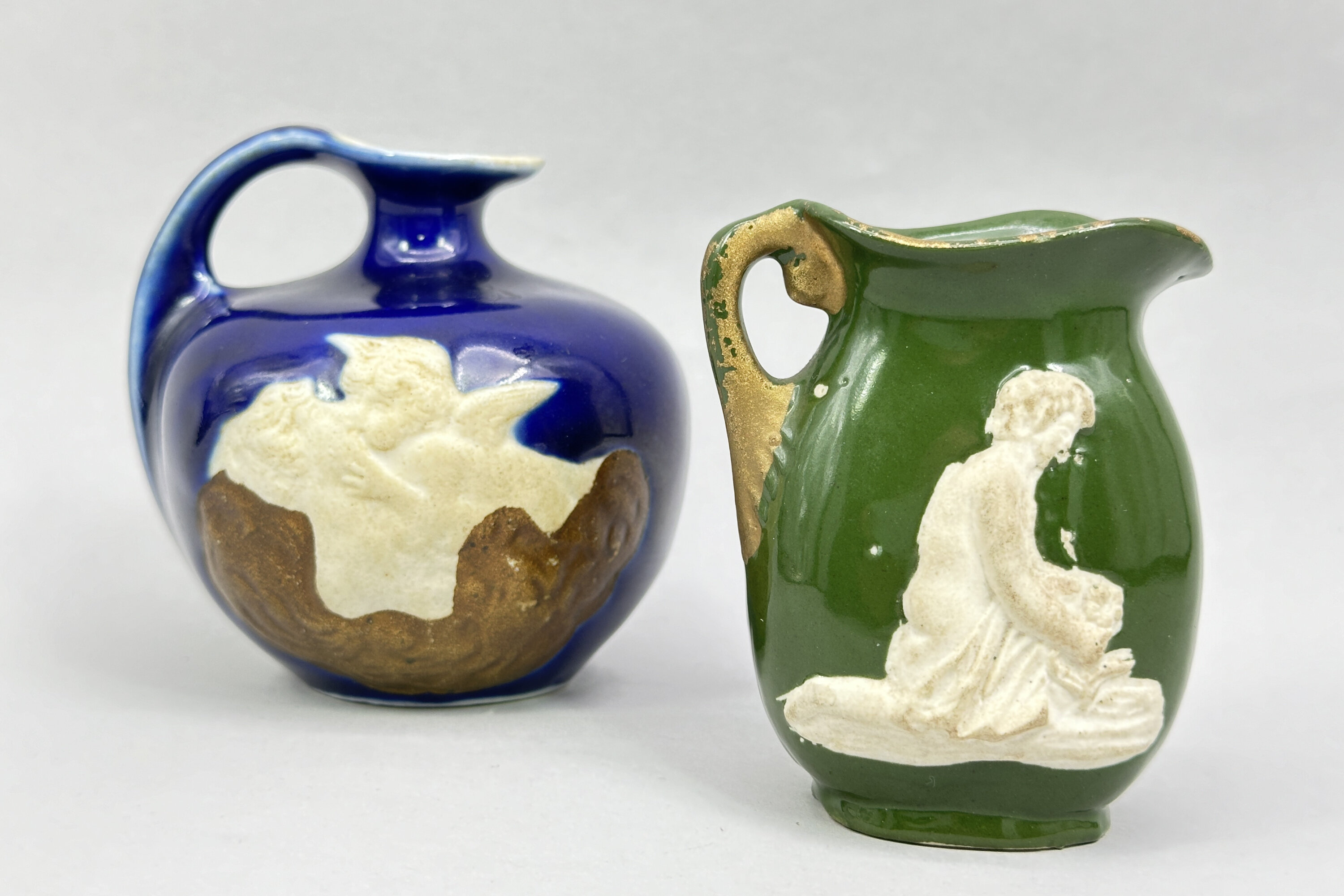
Two Ceramic Jugs with Erotic Decoration, continental perhaps German, circa 1900
Price: £25These pieces represent something of a puzzle. Seen the right way round (with the handle on the right) they are plain and the decoration only reveals itself on the reverse. This suggests a playful intent to conceal which, when combined with the subject matter, suggests something a bit ‘naughty’ which could confirm the second interpretation of what the seated man is holding! The paste, and general style of the pieces, looks continental and a German origin might be a good guess, but no more than that. The blue glazed jug has an impressed mark to the base ‘186 [plus an unidentifiable number]’ which might be the date but is more likely the pattern number; a dating of around 1900 for both seems reasonable - certainly there is an ‘old’ look to the pieces. There are one or two similar examples but little in the way of firm information. One for a collector to puzzle out!

Trade+Aid Teapot, Van Gogh Café Scene, UK 1990s
Price: £25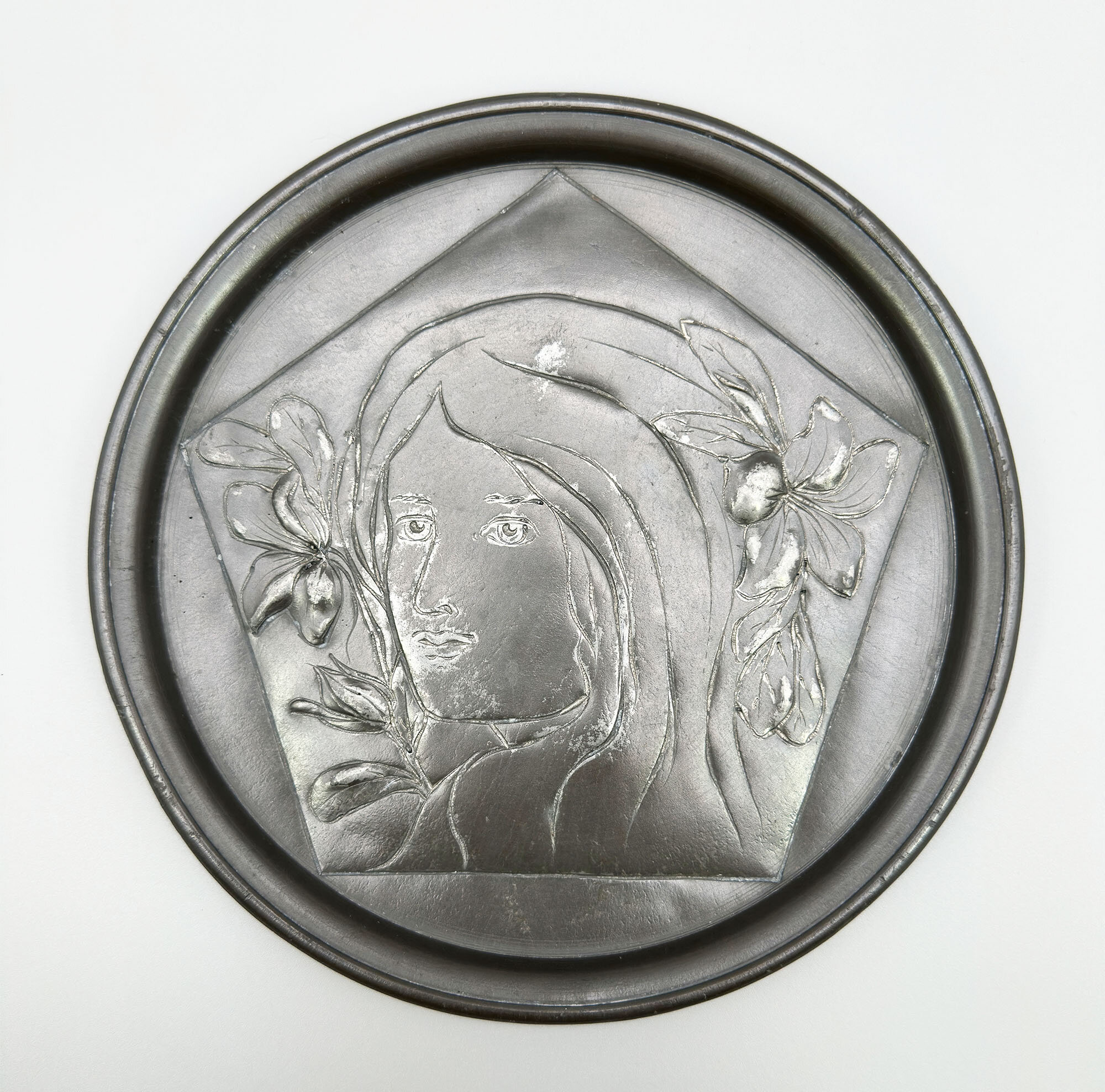
Pewter Plate in the Art Nouveau style, marked Joh. Heidl, C20th
Price: £20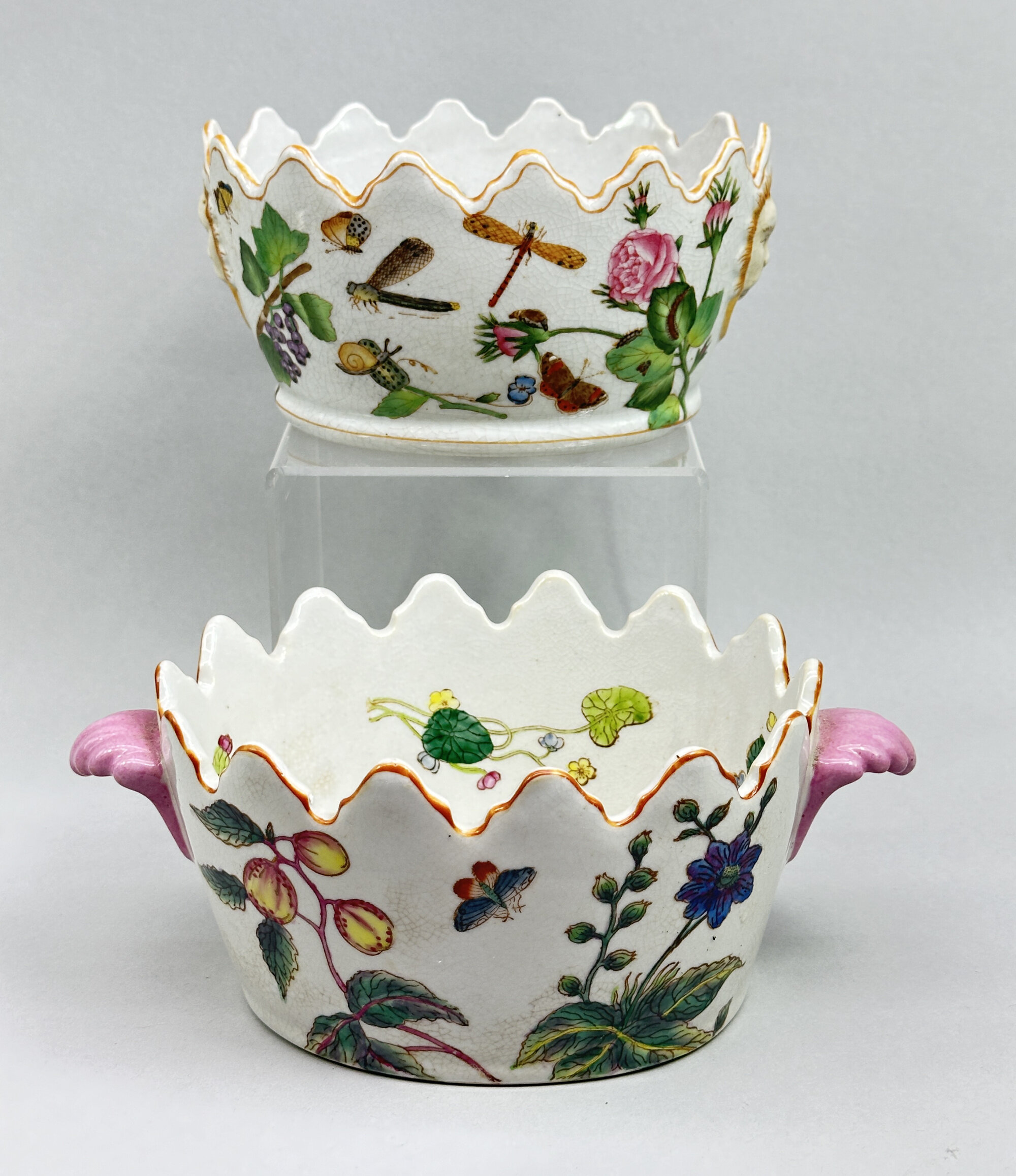
Two similar Chinese Export Style Monteith Form Jardinieres, C20th
Price: £75The form here is a miniature version of the Chinese ‘Monteith’ first produced in the early to mid eighteenth century. The wavy rim was designed to hold the stems of glasses which were stood to cool in iced water placed in the interior. The style of the decoration is in Chinese Export taste as well, but dating here is to the C20th probably around the 1960s. Some similar examples have Chinese seal marks and one the name of a Chinese manufacturer implying that these pieces were most likely made in China but this does not assist with establishing their age. Purely decorative objects then with no intent to deceive but amusing creations in themselves and pleasing to a contemporary eye.
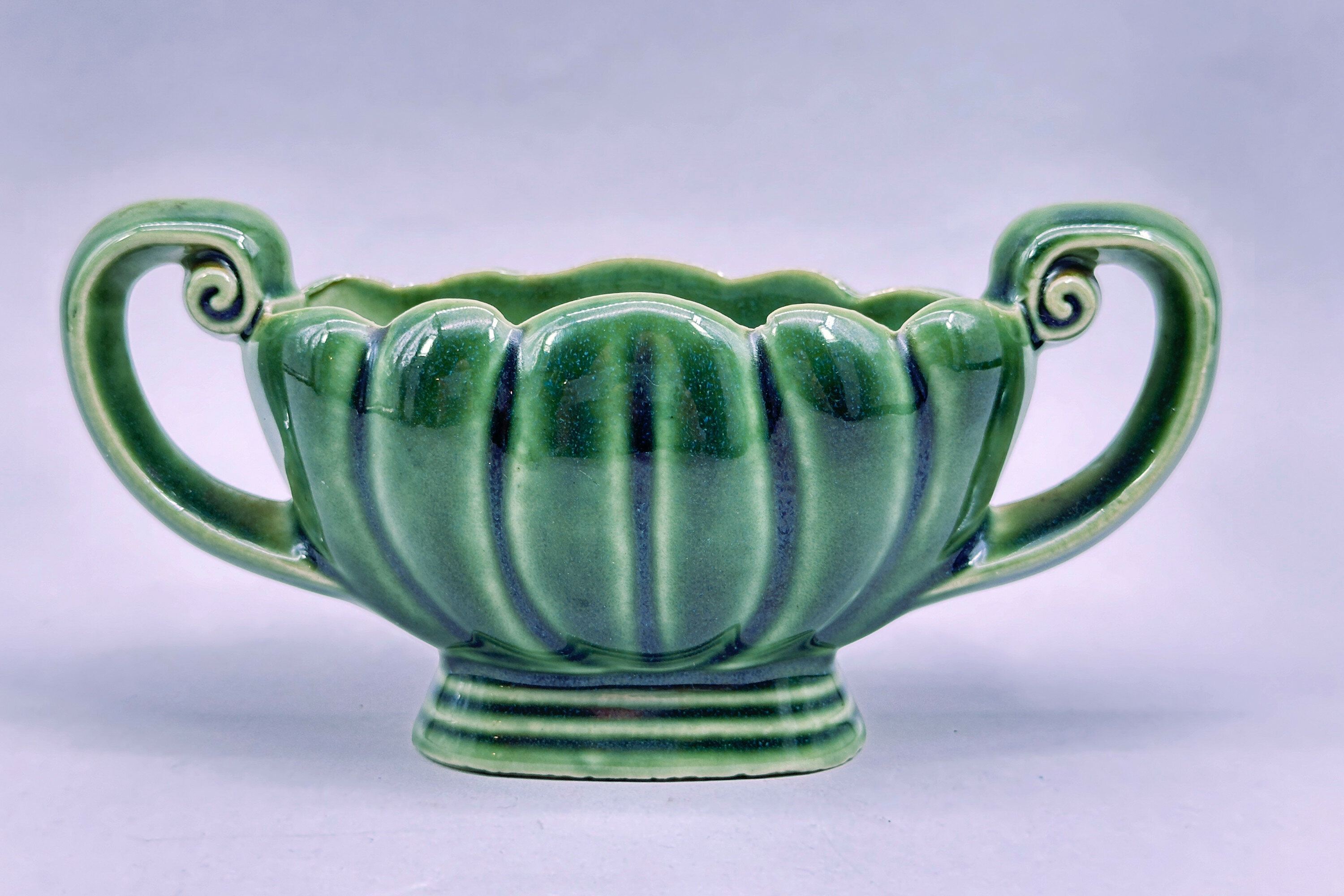
Wade green glazed Posy Vase, 1950s
Price: £20Wade Ceramics Ltd was a manufacturer of porcelain and earthenware, headquartered in Stoke-on-Trent, England. Founded in 1867, it was run by various members of the Wade family until the death of George Anthony Wade in 1987 after which there was a succession of management buyouts. Despite substantial investment in 2009, the firm eventually went into administration in 2022. Wade produced a wide variety of ceramics, including the well known Wade Whimsies animal figurines.
This vase was designed to hold a small bunch of flowers and was produced in a variety of sizes and colours, green being the most common. The form has an almost ‘neo classical’ feel but the piece dates to the 1950s when this particular format of the factory mark was used.
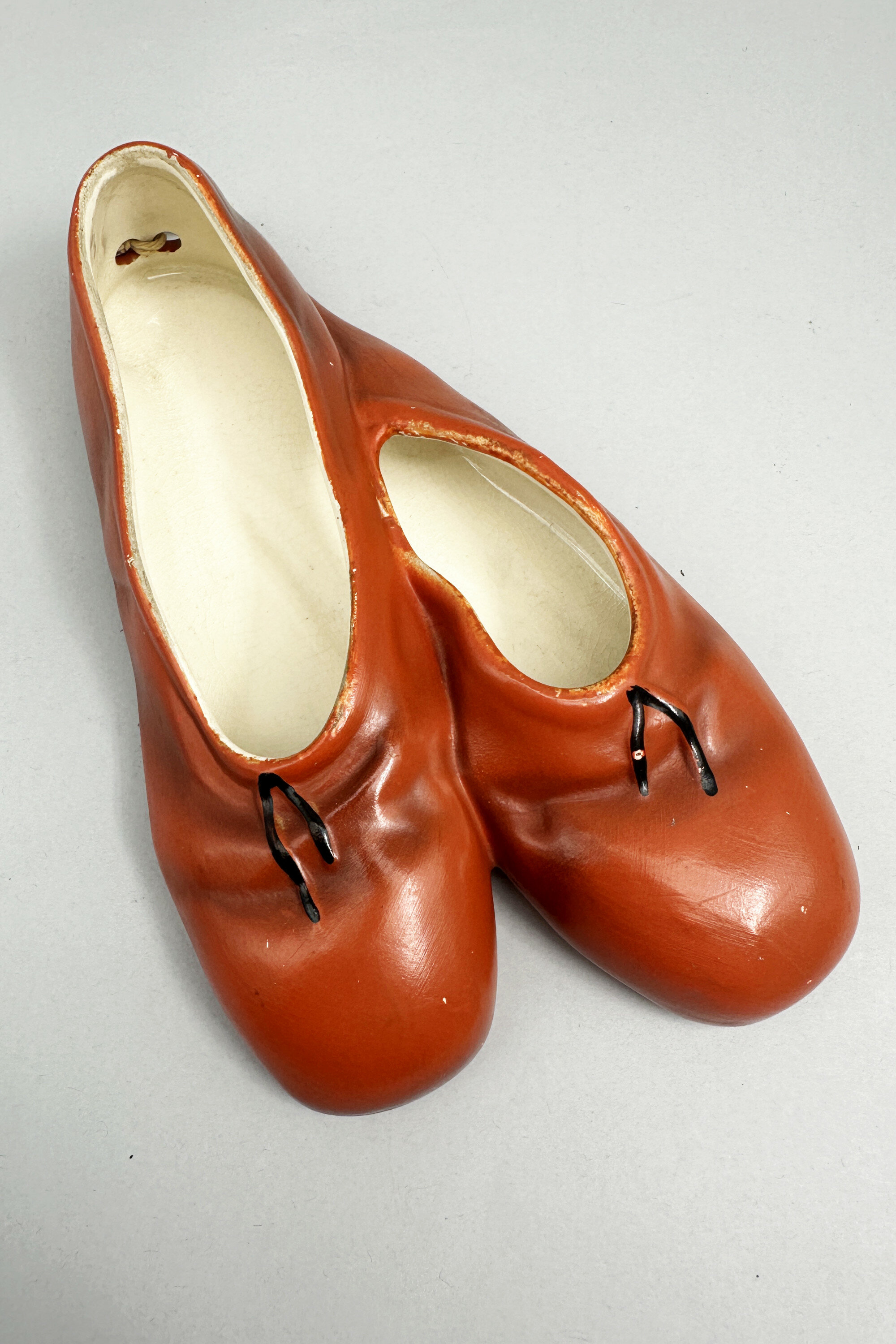
Pair of Brentleigh Ware Wall Hanging Ballet Shoes, 1930s
Price: £35
Oriental style ceramic plate, signed Alice Smith, possibly American mid C20th
Price: £10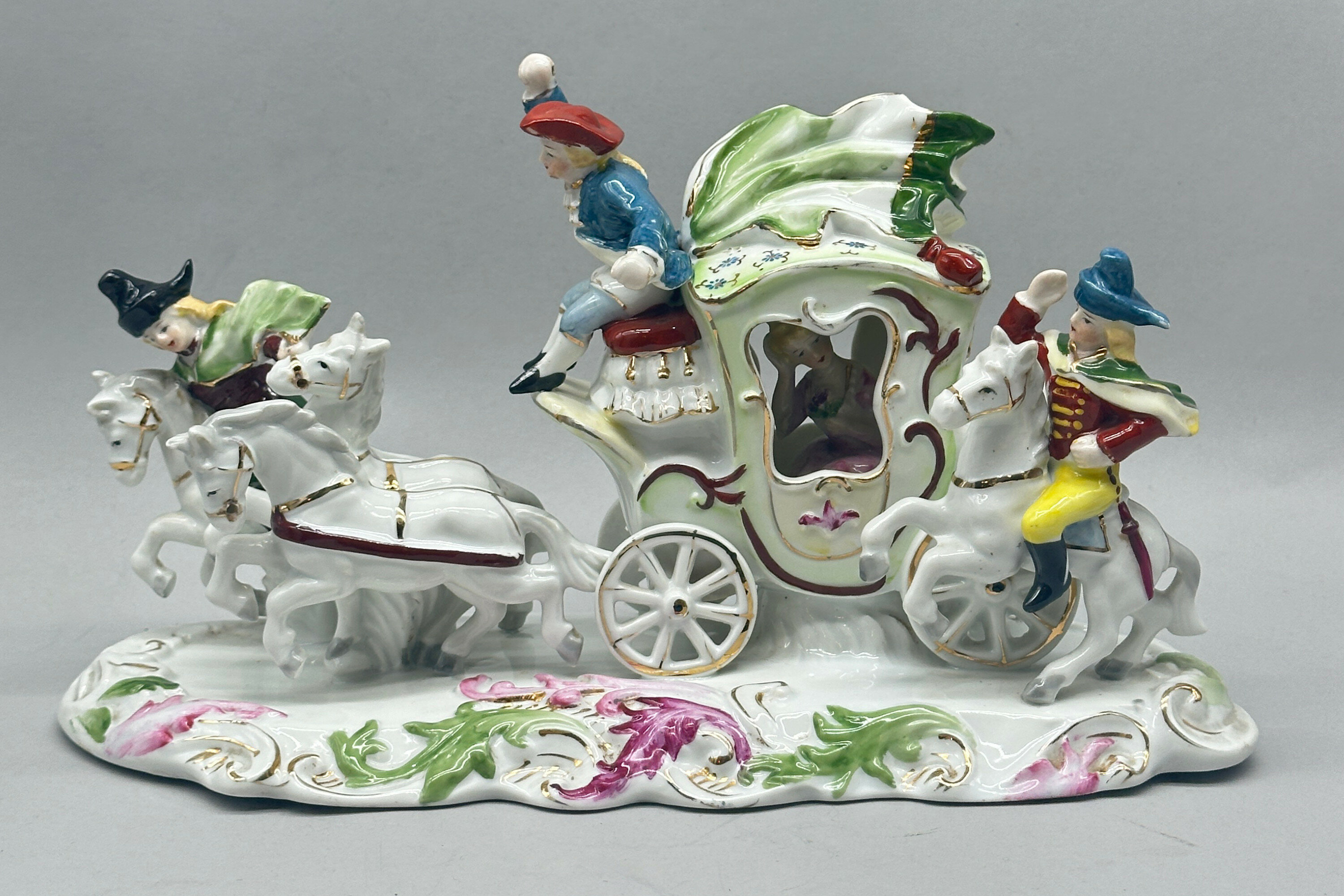
Dresden style model of a Coach and Horses, probably German early C20th
Price: £75
Majolica Style Jardiniere, French, circa 1900
Price: £55This is a French interpretation of the ‘Majolica’ style which became so popular, particularly in England in the second half of the nineteenth century. A very distant relation of the tin glazed Italian and Spanish wares which share the name, nineteenth century majolica employed a wide variety of brightly coloured glazes applied to elaborate forms some of which had a slightly ‘classical’ feel and some a reflection of ‘rococo’ designs. The paste and glazes here suggest France, which produced various pieces in the ‘majolica’ style and dating is probably to the end of the nineteenth century.
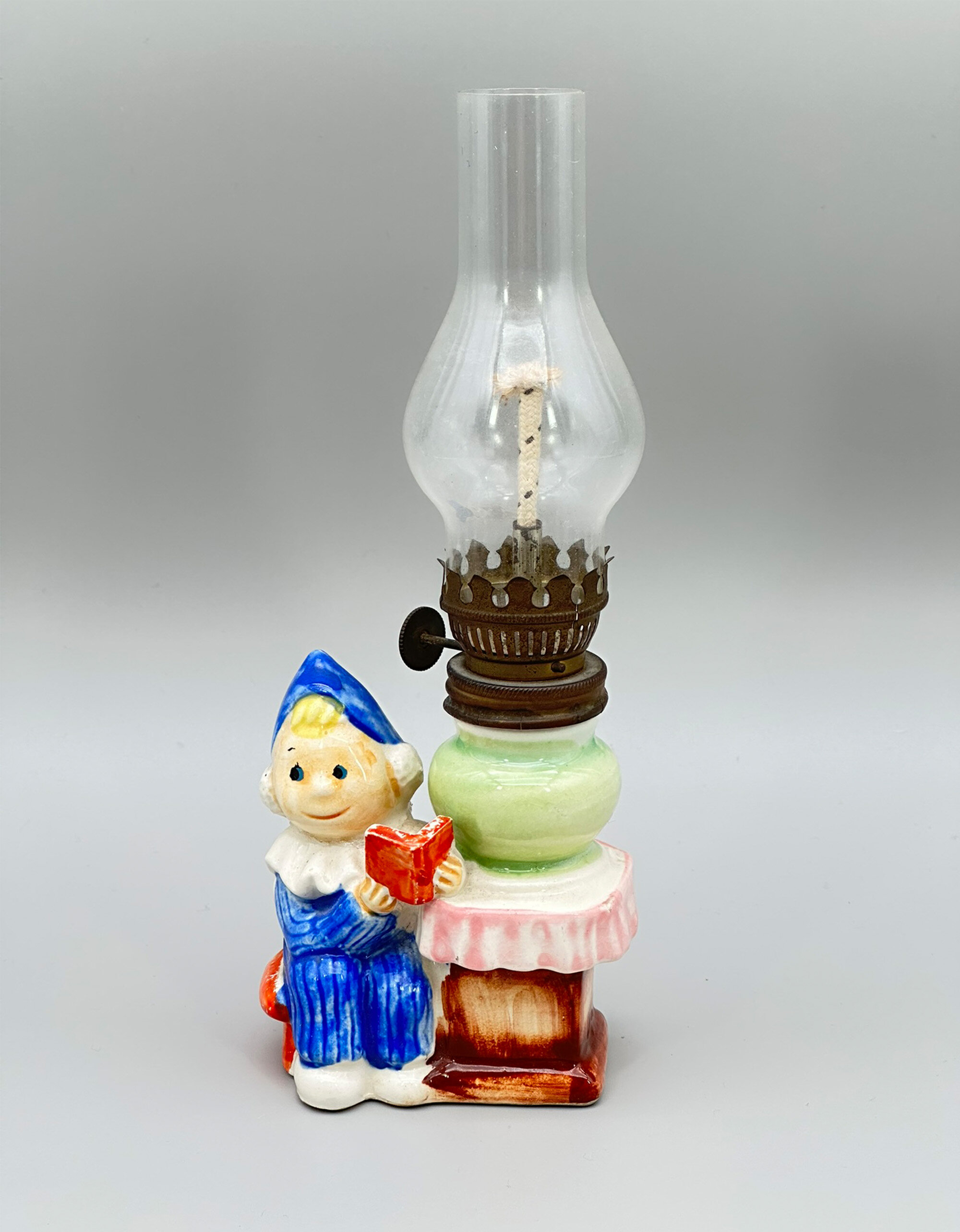
Andy Pandy Oil Lamp, German, Karl Meyer, 1950s
Price: £35TV linked merchandise was created even in the earliest days of the medium and this charming small ceramic oil lamp, hardly the safest accessory for the nursery, is an amusing example. Andy sits next to a table with an urn on the top which forms the base of the lamp. Oil or paraffin would have been contained inside and once lit the wick could be adjusted by turning the round flat knob on the side. This has the trademark symbol for the German toy manufacturers Karl Meyer (see image 7). The base is marked ‘FOREIGN’ which was a common requirement for items imported into the UK after the second World War and allowed the makers to conceal their country of origin, which might have been useful to some of them at the time. A true piece of nostagia whether the figure represented is familiar or not.

Three Indian gouache paintings depicting Krishna and Radha, framed, first half C20th
Price: £150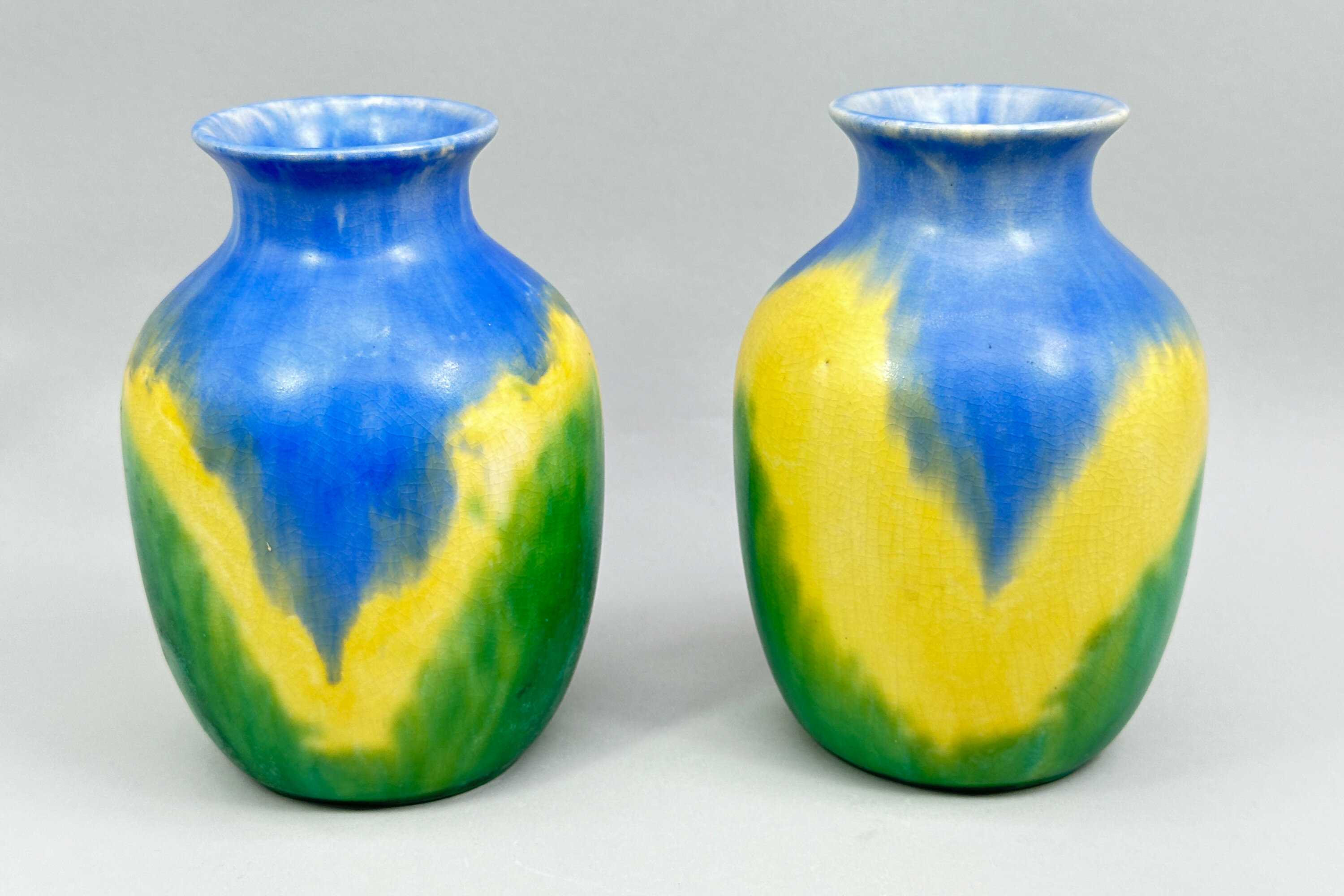
Pair of Art Deco style Avon Ware Vases, 1930s
Price: £45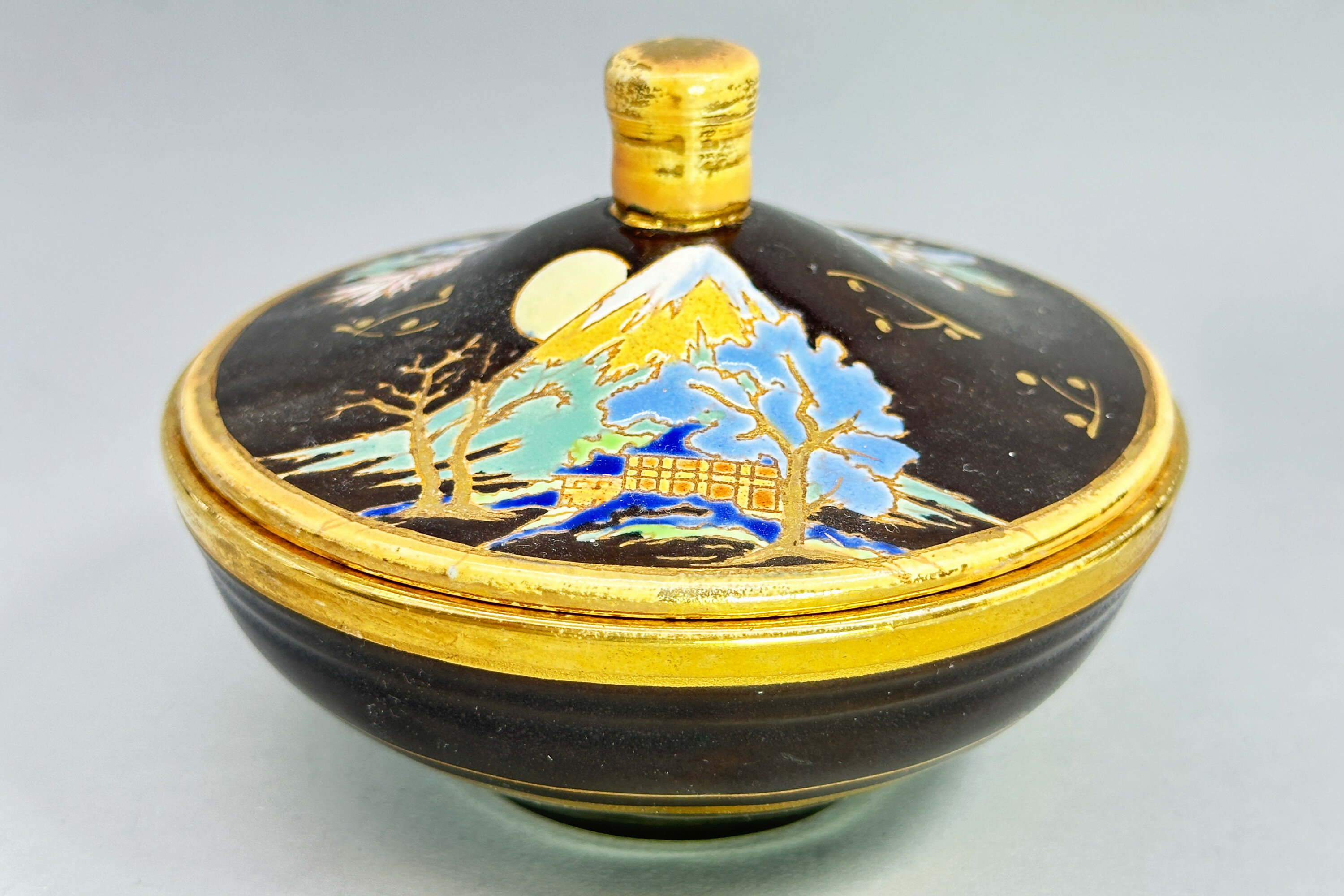
Cosmetic Box with Japonaiserie Decoration, Boch Freres, early C20th
Price: £45The firm Boch Freres Keramis was founded by Eugene and Victor Boch and their brother-in-law, Jean Baptiste Nothomb, in 1841 and was located in La Louviere in eastern Belgium. In 1906 Charles Catteau joined the company as artistic director and was responsible for a new and wide ranging series of designs, some under the influence of Japonisme, transitioning the company from producing utilitarian objects to highly decorative ceramics. His work can clearly be seen here in a piece which appears to be quite unusual. Both the form and the decoration reflect early twentieth century fashion in the clean lines and the images inspired by Japan. There is a hint of the aesthetic movement here producing an object of great attraction and interest.

Cosmetic Box with Japonaiserie Decoration, Boch Freres, early C20th
Price: £45The firm Boch Freres Keramis was founded by Eugene and Victor Boch and their brother-in-law, Jean Baptiste Nothomb, in 1841 and was located in La Louviere in eastern Belgium. In 1906 Charles Catteau joined the company as artistic director and was responsible for a new and wide ranging series of designs, some under the influence of Japonisme, transitioning the company from producing utilitarian objects to highly decorative ceramics. His work can clearly be seen here in a piece which appears to be quite unusual. Both the form and the decoration reflect early twentieth century fashion in the clean lines and the images inspired by Japan. There is a hint of the aesthetic movement here producing an object of great attraction and interest.
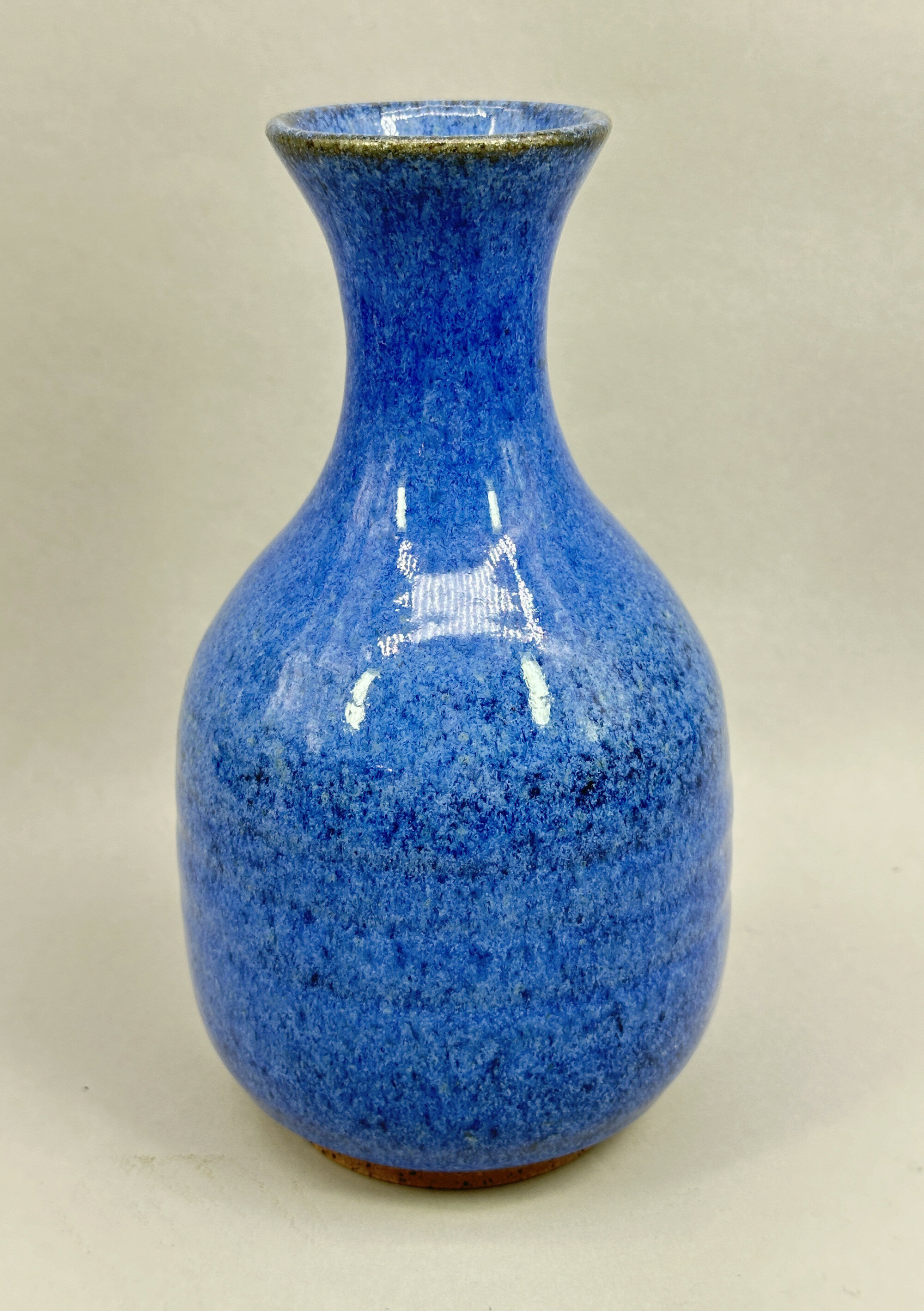
Studio Pottery Vase with Robin’s Egg Glaze marked Zambia, Modern
Price: £30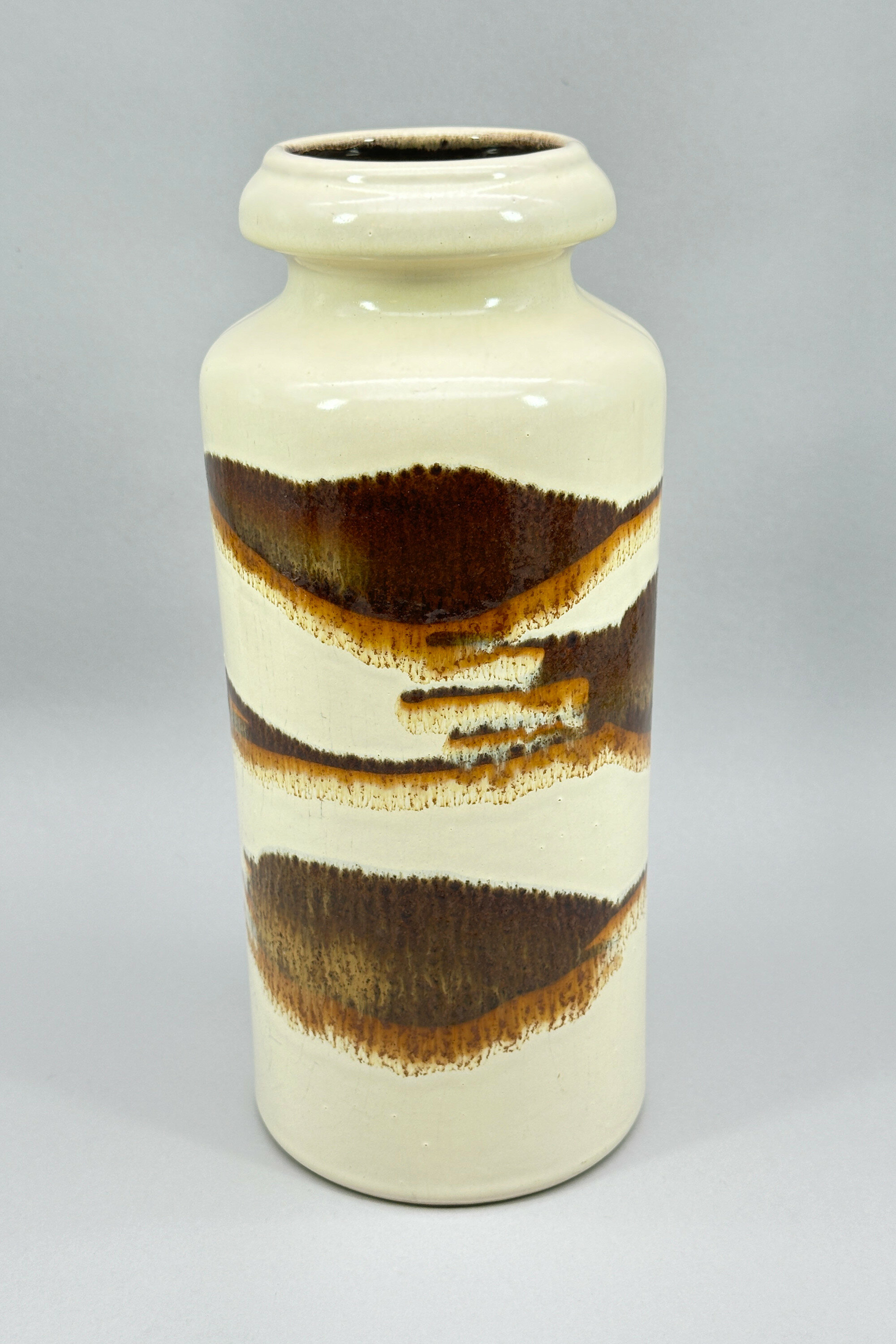
West German Vase with drip glaze decoration, Scheurich, 1960s
Price: £45Although not marked as such, this vase has all the hallmarks of the firm Scheurich Keramik which started production in 1954, rather later than most of its competitors, but soon became the largest producer of commercial art pottery in Germany. Their pieces rarely carried the factory name but usually the model number followed by the height in centimetres with ‘W-Germany’ below, as here. Model ‘517’ can be found in a variety of different glazes but the colourings here with the contrast between browns and cream are particularly successful. Dating is to the 1960s.
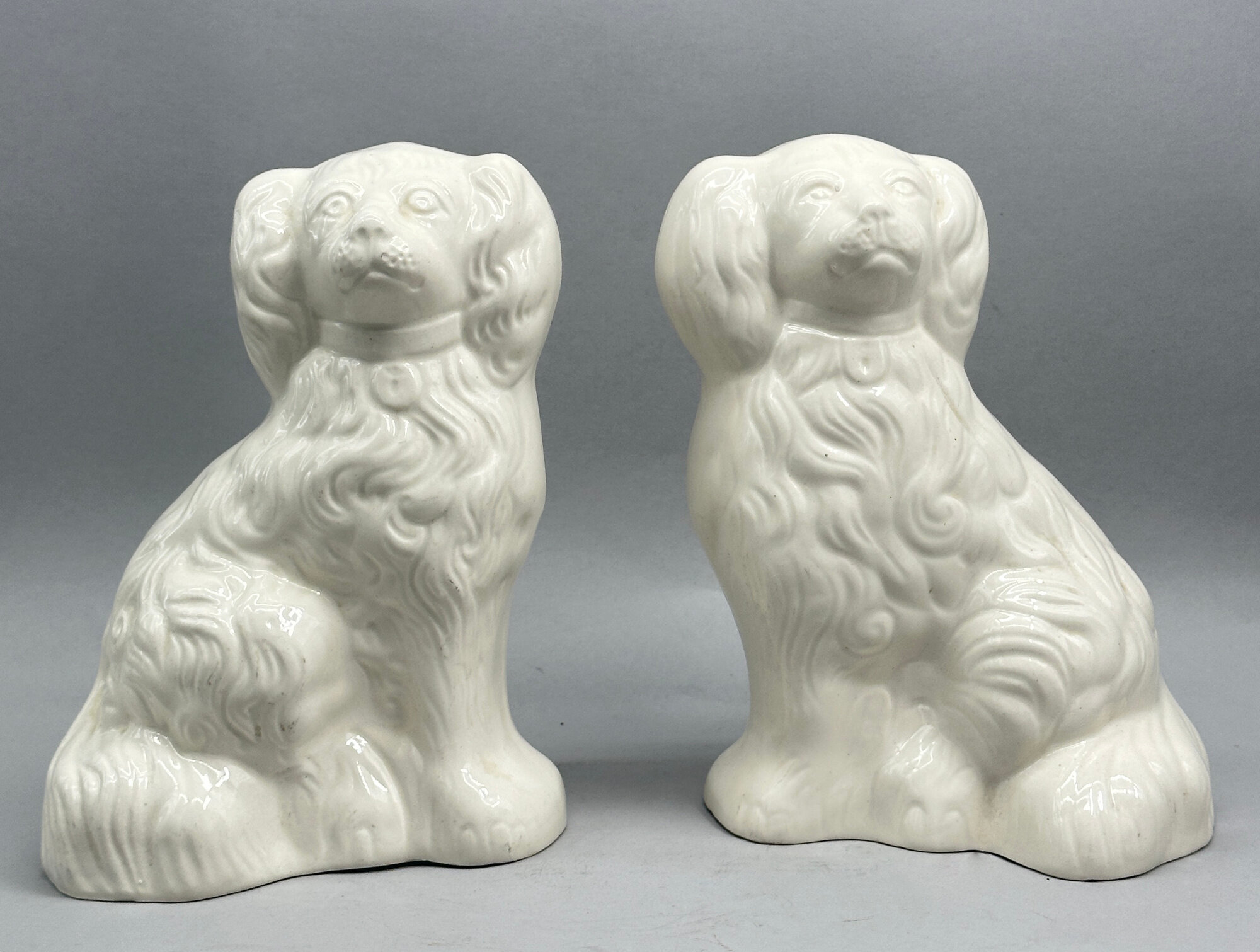
An unusual pair of white glaze models of Spaniels, Beswick, 1960s
Price: £75While a close relation to the traditional Victorian ‘Staffordshire Dog’, these figures were actually made by the English firm Beswick in the twentieth century. Founded in 1894 by James Beswick and his sons, the company became known for its output of figurines, eventually securing the rights to producing characters from the novels of Beatrix Potter and the films of Walt Disney. It was sold to Royal Doulton in 1969 who continued production until 2002, selling the pottery premises in 2003 and the rights to the name in 2004 when they were bought by Dartington Crystal who still manufacture pieces carrying the Beswick name. These spaniel figures appear to date from the 1960s and were made in at least two sizes. Most have painted decoration but the plain white finish here is really the most pleasing of all producing a pair of decorative items with timeless appeal.
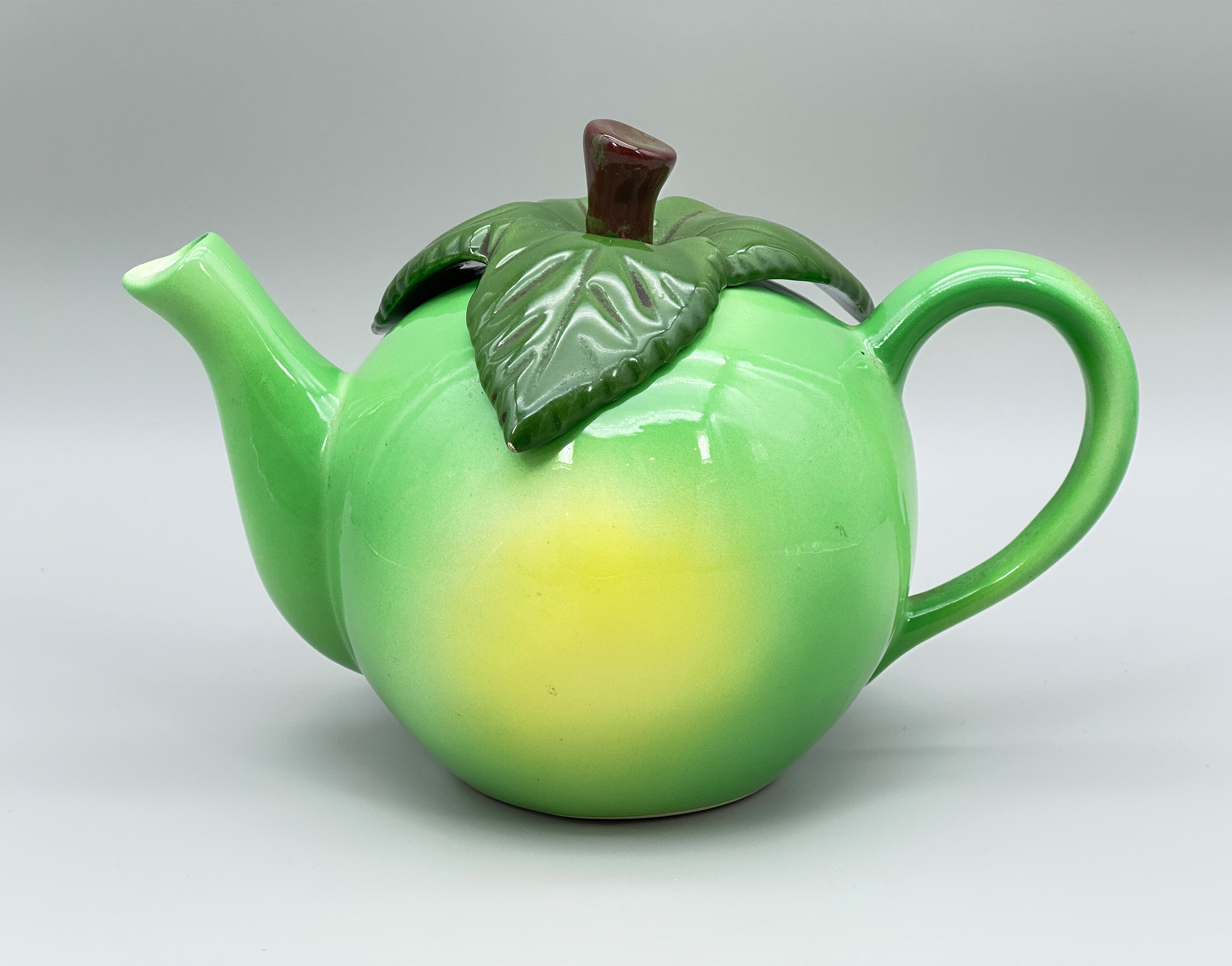
Novelty Teapot in the form of an apple, probably English, late C20th, early C21st
Price: £35
Pedestal footed Onyx Vase, mid to late C20th
Price: £25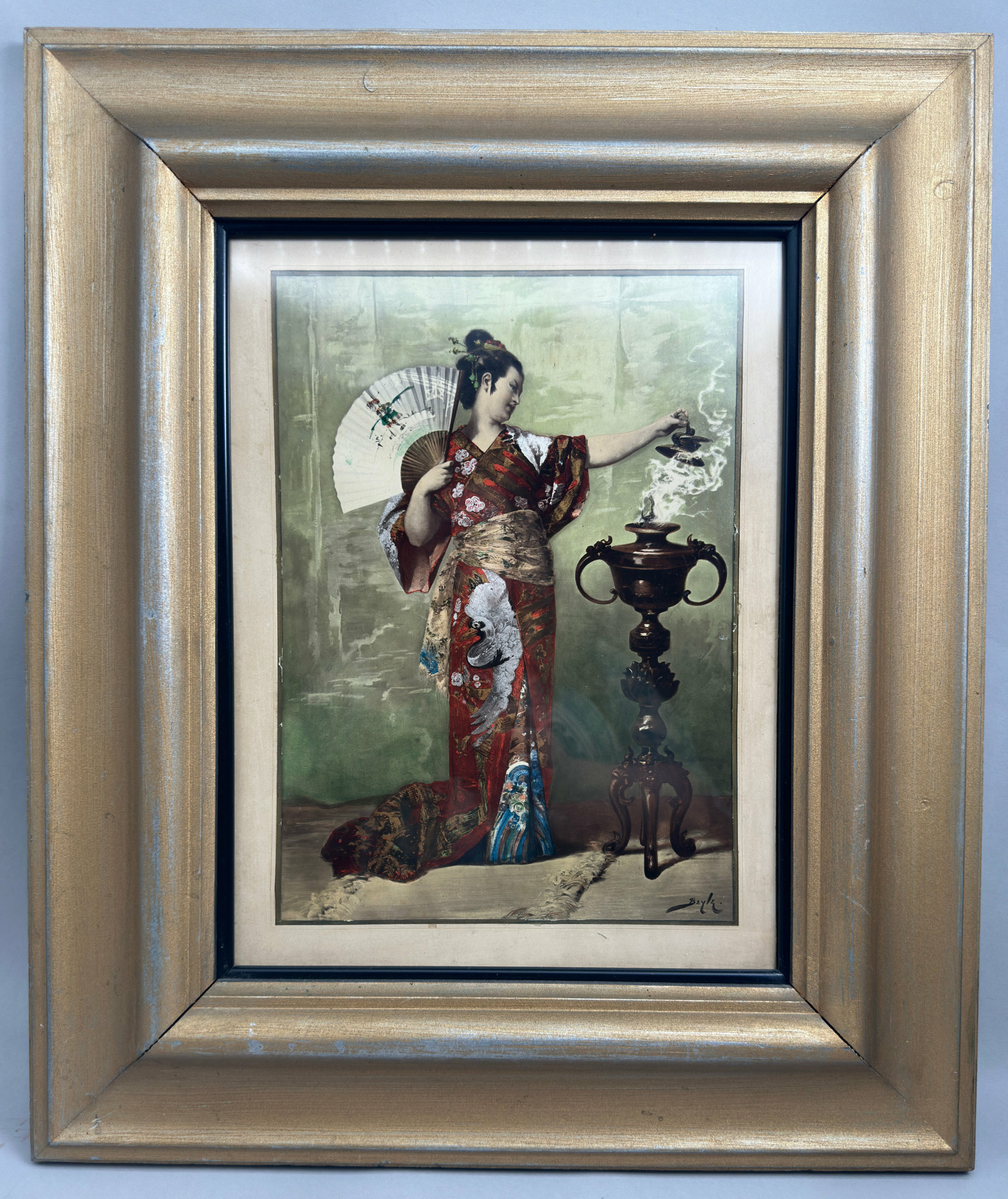
Léon Vidal Photochromie : A Japanese Woman with a Parasol, late C19th
Price: £550...............................................................................................................................................................
Art and artistry combine in this striking photographic reproduction of a painting by the French artist Pierre Marie Beyle (1838-1902) produced by the ‘Photochromie’ printing process invented and perfected by the French photographer Leon Vidal (1834-1906).
Leon Vidal (see image 11) developed the photochrome printing process in the 1870s as a method of accurately colouring photographs for quantity reproduction. From the original negative a number of copy negatives were made, on glass or thin paper. On each negative, those areas which were not to be coloured were blocked out with an opaque medium. For example, on the negative prepared for the colour blue, only those areas to be coloured blue in the final print remained uncovered. Negatives were prepared for as many colours as required, up to twelve, and then used to make lithographic tint plates which were employed to transfer colours in succession to the monochrome photograph from the original negative.
‘Photochromie’, as the photochrome printing process was called, was patented in 1872 and 1874 and refined by Vidal in the studios of the Société Anonymes des Publications Périodiques, whose director he became in 1875. This Société was founded in 1869, initially for a period of 60 years, and its first major publication, published in 1878, was a lavishly illustrated book entitled ‘Le Trésor artistique de la France’ in which the French heritage in the arts was represented by thirty nine specially selected items of particular cultural and artistic merit, each described by an expert in the field and all illustrated, a few in monochrome and the bulk, thirty in all, in colour employing the newly discovered photochromie process. The results were unfortunately uneven and the cost of the volume, three hundred francs, prohibitively high which resulted in the first volume of a proposed series being its last. Individual plates from this publication appear on the market today and are sought by collectors.
Less commonly seen are individual representations of contemporary paintings which Vidal also produced in the studios of the Société at its premises, 13 Quai Voltaire, Paris. Vidal’s printing process was not the only one available to the French public in the late nineteenth century but it was probably the most accomplished and Vidal sought to exploit this by issuing a series of reproductions suitable for interior decoration. Most popular amongst the artists whose work he chose to reproduce seems to have been Pierre Marie Beyle (1838-1902).
Beyle was born in Lyon in 1838 and studied in Paris where he later exhibited regularly at the Salon, from 1867 to 1900. Around 1870, he went to Algiers and the themes of the city are reflected in his paintings of those years (see image 12 for an example). Later he became known for landscape and genre scenes many of which depict the surroundings of Normandy where he used to spend his summers and in addition he followed the contemporary fascination with the Orient producing paintings with themes from the Far East such as we have here. Beyle also worked as a caricaturist in satirical newspapers such as the Petit Journal, the Fun Journal and Bouffon in the 1860s and 1870s. He exhibited at the Grafton Gallery in London in 1881, then went to Scotland where he exhibited at the Institute of Fine Arts in Glasgow. In 1900, he exhibited at the Universal Exhibition. After settling in Chennevieres-sur-Marne towards the end of his life he died in Paris in 1902 and was buried at Montparnasse.
The rich palette of colours employed in Beyle’s paintings were well suited to reproduction by Vidal’s newly invented printing process and he doubtless chose those works which he felt would have a particular popular appeal. The rage for ‘Japonisme’ in the second half of the nineteenth century is well documented and its influence was widely spread, perhaps most famously in David Belasco’s play ‘Madame Butterfly’ which inspired Puccini’s opera of the same name. The Geisha figure here fortunately holds a fan rather than a sword and is seen gazing at an elaborate bronze incense burner. The elaborate colours of her robe are well reproduced by the ‘Photochromie’ technique and the whole composition has a richness of presentation which doubtless reflects the original painting which appears still to be in the private domain. Beyle’s signature is accurately reproduced at the bottom right and Vidal’s invention is proudly announced on the reverse with the sun inspired emblem at the top and the wording below ‘Photochromie’ ‘Photographie en Couleurs’ ‘sans le secours du pinceau’. No hand colouring here! The modern frame acts acts as complement to the image and both combine to present a highly decorative picture of considerable cultural interest.
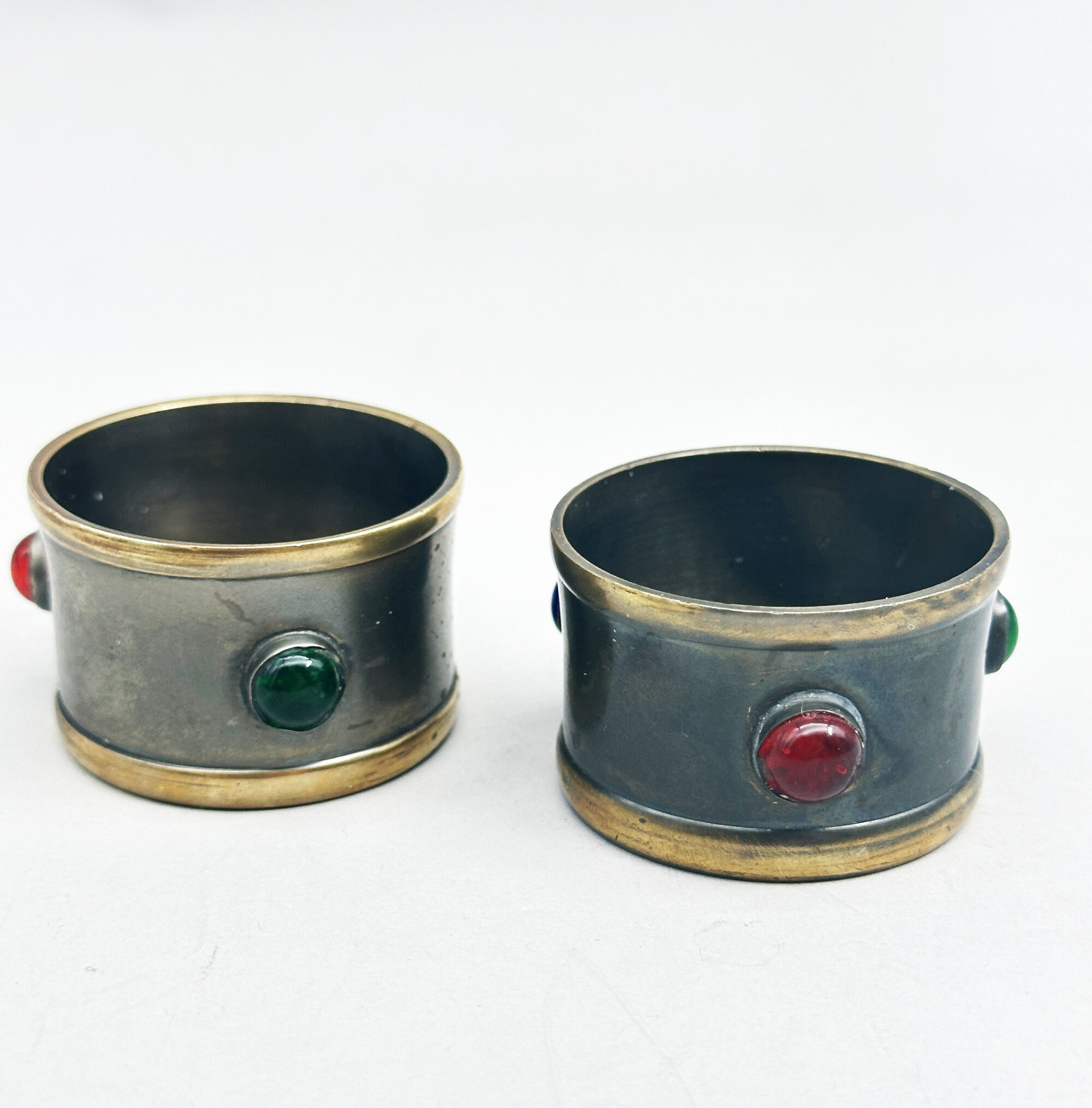
Pair of Arts and Crafts Pewter Salts, early C20th
Price: £45
Rennie Mackintosh Arts and Crafts silver brooch
Price: £25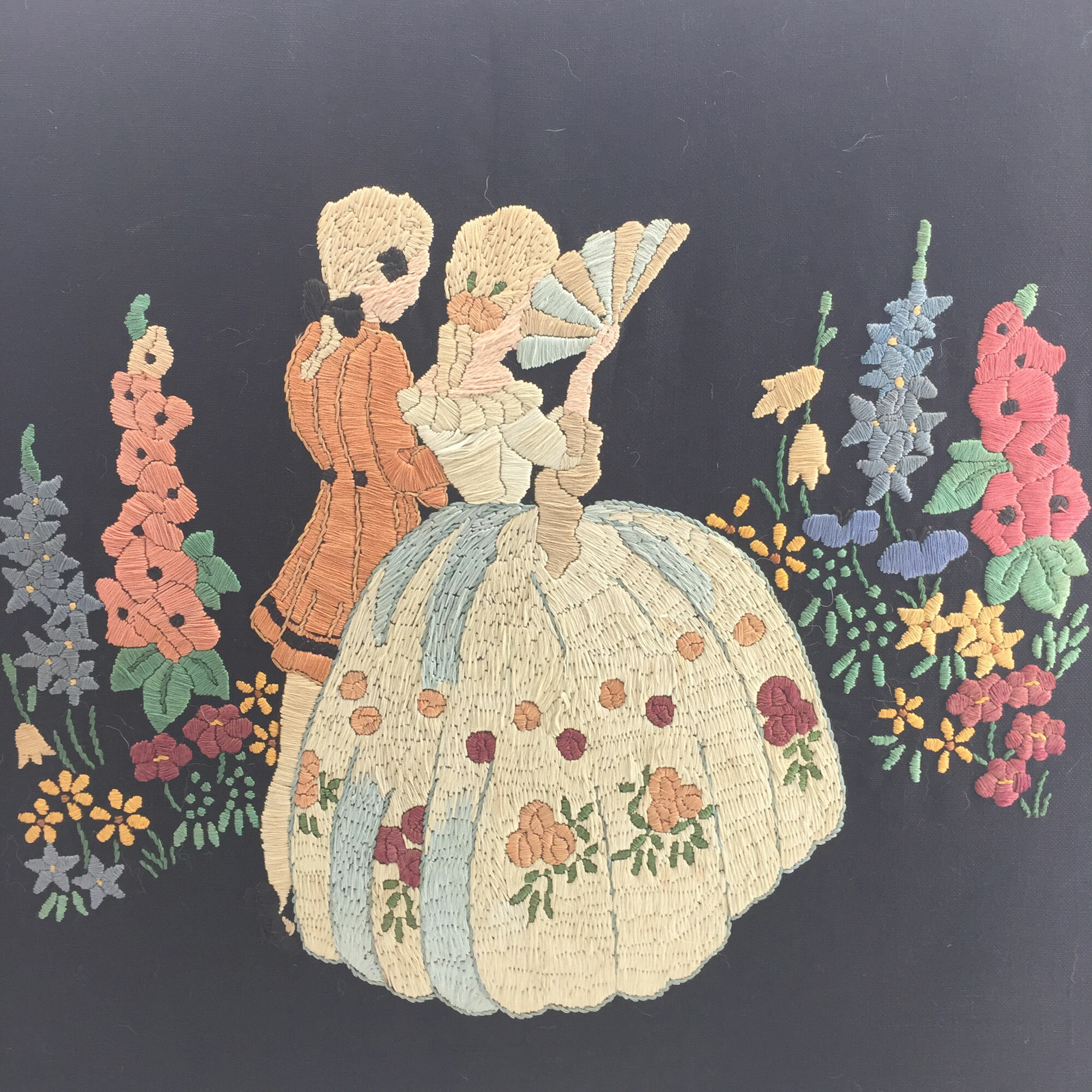
Arts and Crafts Stumpwork Firescreen 1900
Price: £25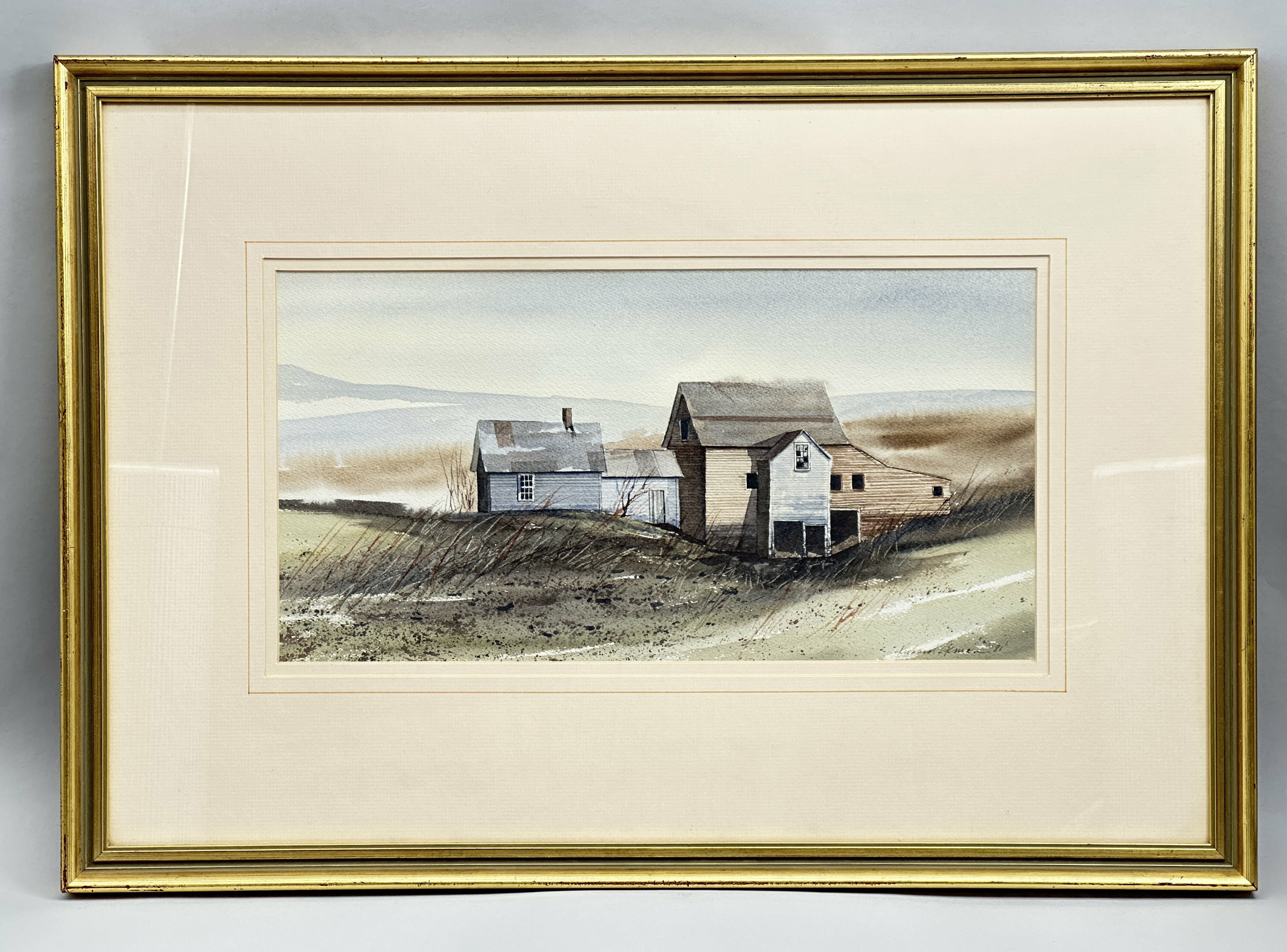
Signed Watercolour of Farm Buildings, Richard Akerman (1942-2005), dated 1981
Price: £110..............................................................................…………………………………………………………………………………………..............................…
Richard Akerman was born in London in 1942. He attended the Hornsey College of Arts and Crafts in the early 1960s, studying a general fine art course which incorporated printmaking and sculpture. His first exhibition was at the Obelisk Gallery in Crawford Street, London, where his work was displayed alongside works by famous surrealists such as Man Ray and Salvador Dali, implying that the style of his early work matched that of his more famous contemporaries. Years of travel followed in both Europe and the Far East and this seems to have turned him to painting in a more coventional style. A succession of watercolours was to follow with subjects ranging from still life and flowers to garden and architectural subjects. His work became immensely popular through the prints made from his original paintings, indeed such was the demand for them that he rivalled Monet as a subject for reproduction in this medium becoming, in a sense, quite a household name with exhibitions of his work internationally.
The path to success, however, was not straightforward and one account of him, written by his son Marcus, mentions running a hot dog stand alongside joining the artists with their weekend displays of works for sale on the railings at Kensington Gardens. Convivial and outgoing (a self portrait captures him well : see image 9), Akerman was married with three children and spent the latter years of his life in Spain where he sadly died after an accident in 2005.
But his work survives him and the prints produced in his lifetime can still be obtained today, giving an accesible overview of his output. The style is approachable with an attractive use of colour and often slightly impressionistic brushwork. But there are works executed in a more precise style, for example a signed watercolour ‘Hot House Flowers’, exhibited by the Edinburgh Gallery in 1994 (see image 10) and this is seen in the work we have on offer. The location of this group of farm buildings is uncertain but Akerman painted similar scenes which appear to be located in Kent and this may well be the case here. Original watercolours by Akerman are not so easily found but what increases the rarity and interest of our picture is that the artist’s signature, done in a slightly more precise hand than the signatures found in the reproduction prints, has the date in addition (’81). We have been unable to find any other example of this and it leads to the possibility that this is a work which the artist painted for himself. Certainly there are no reproductions of it. If so, then it is of particular interest and more than worthy of inclusion in a collection C20th British watercolourists with the addition of being an original creation by an artist who enjoyed such great popularity with the general public.
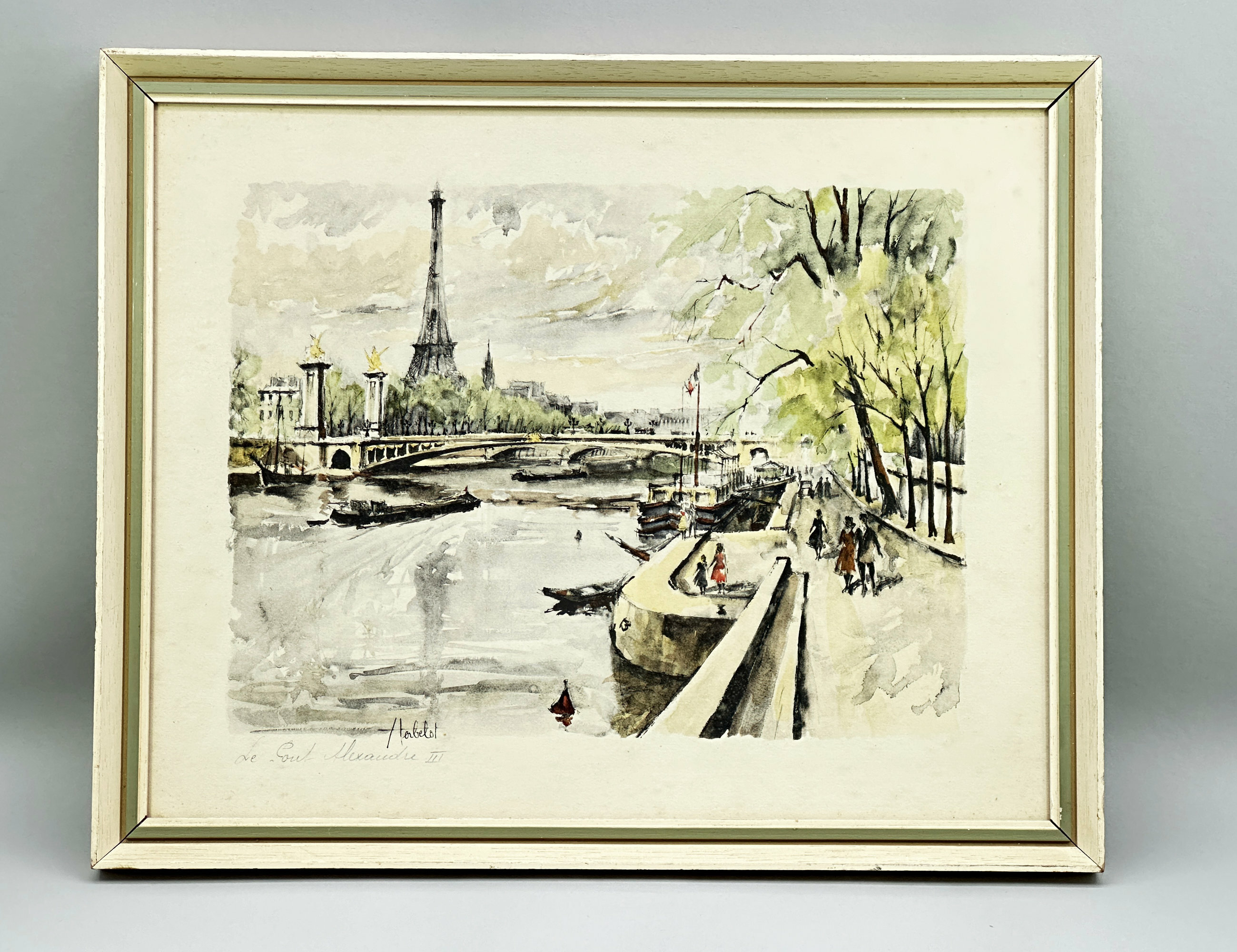
Lithograph Print, Le Pont Alexandre III in Paris, signed Herbelot, 1950s/1960s
Price: £45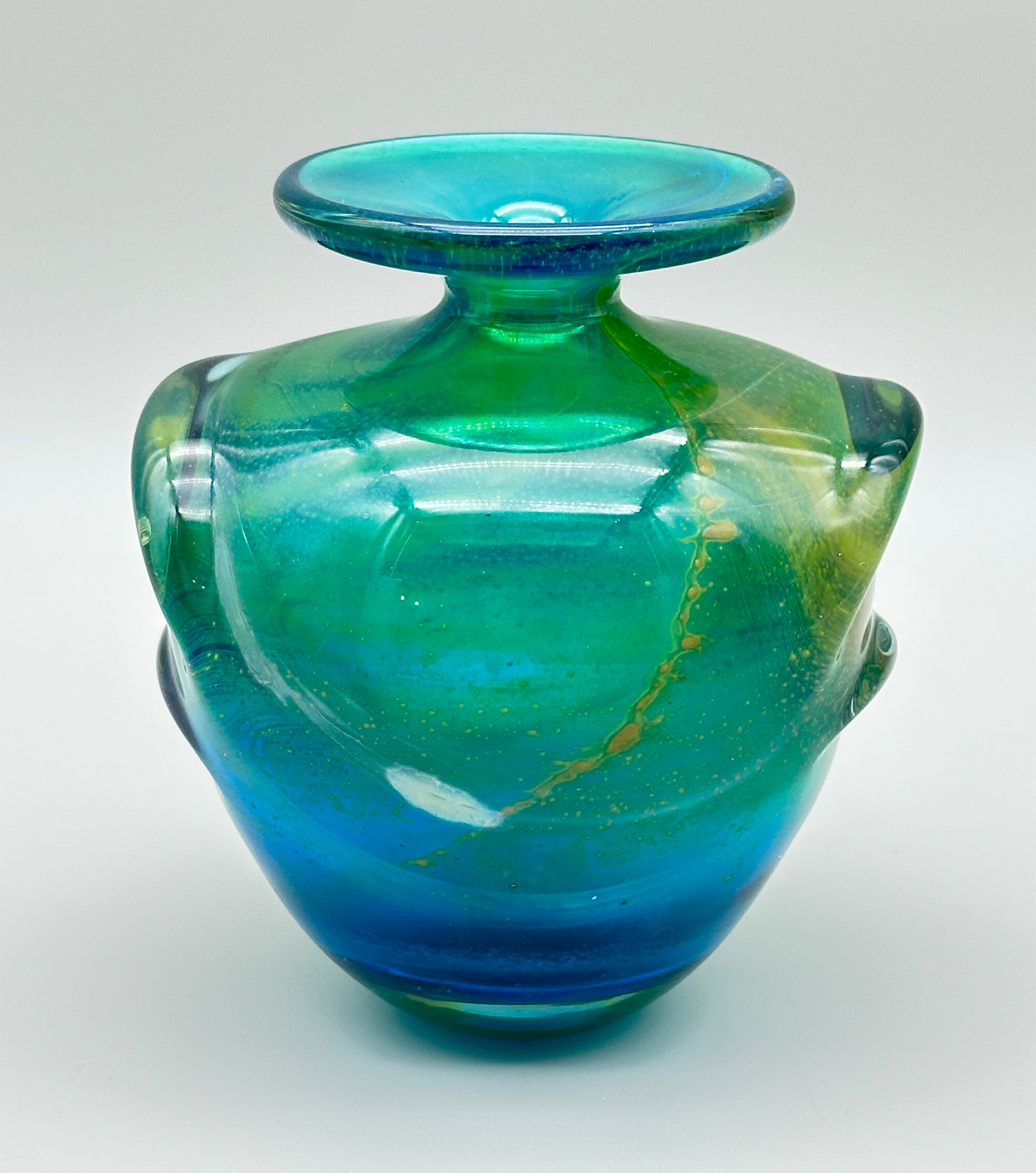
Mdina pulled ear glass Vase, Blue Summer pattern, signed, second half C20th
Estimate: £40 – 60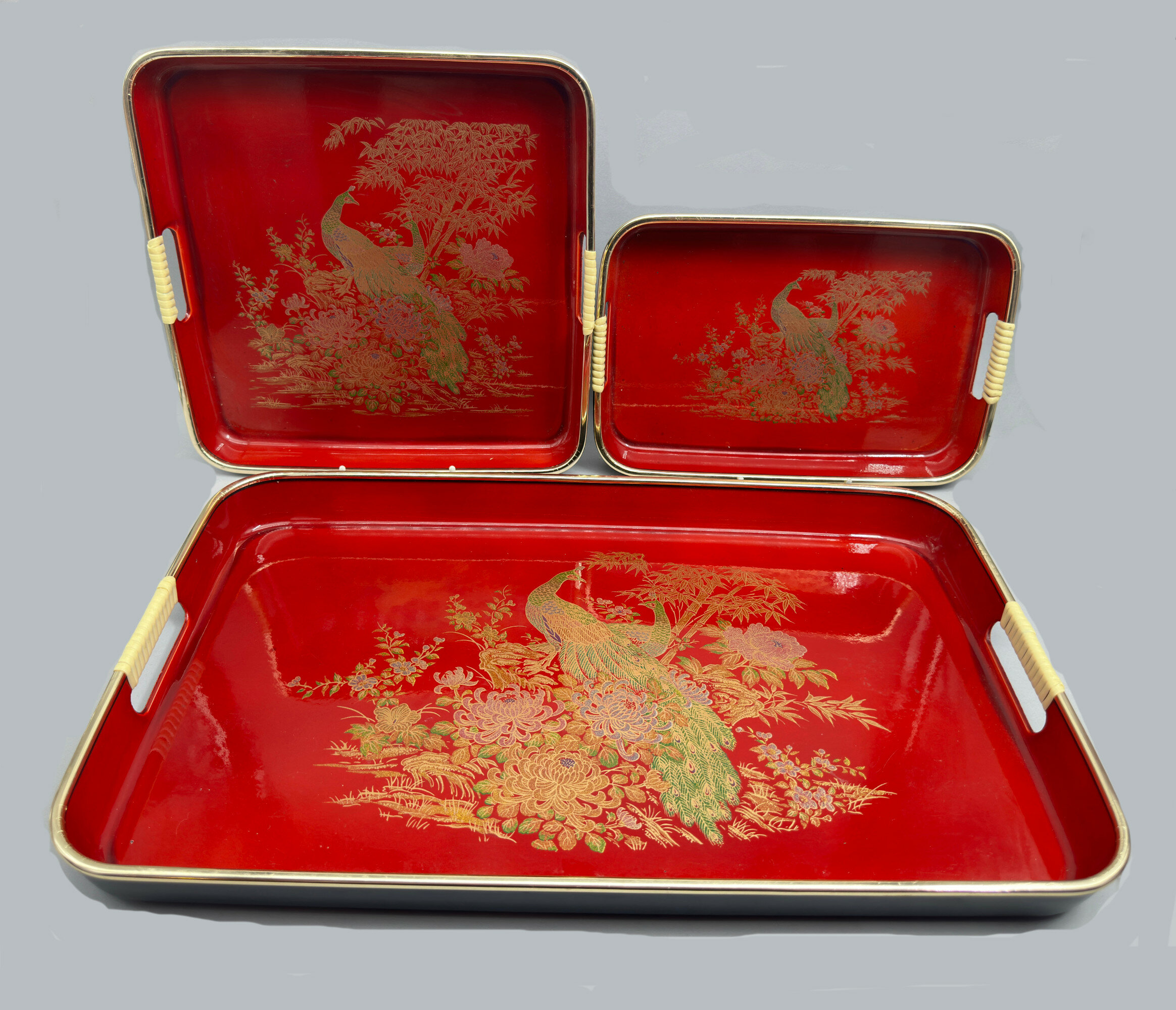
Set of Three Japanese Lacquer Nesting Trays, mid to late C20th
Price: £45
African Carved Wood Figure of a Lady, probably mid C20th
Price: £25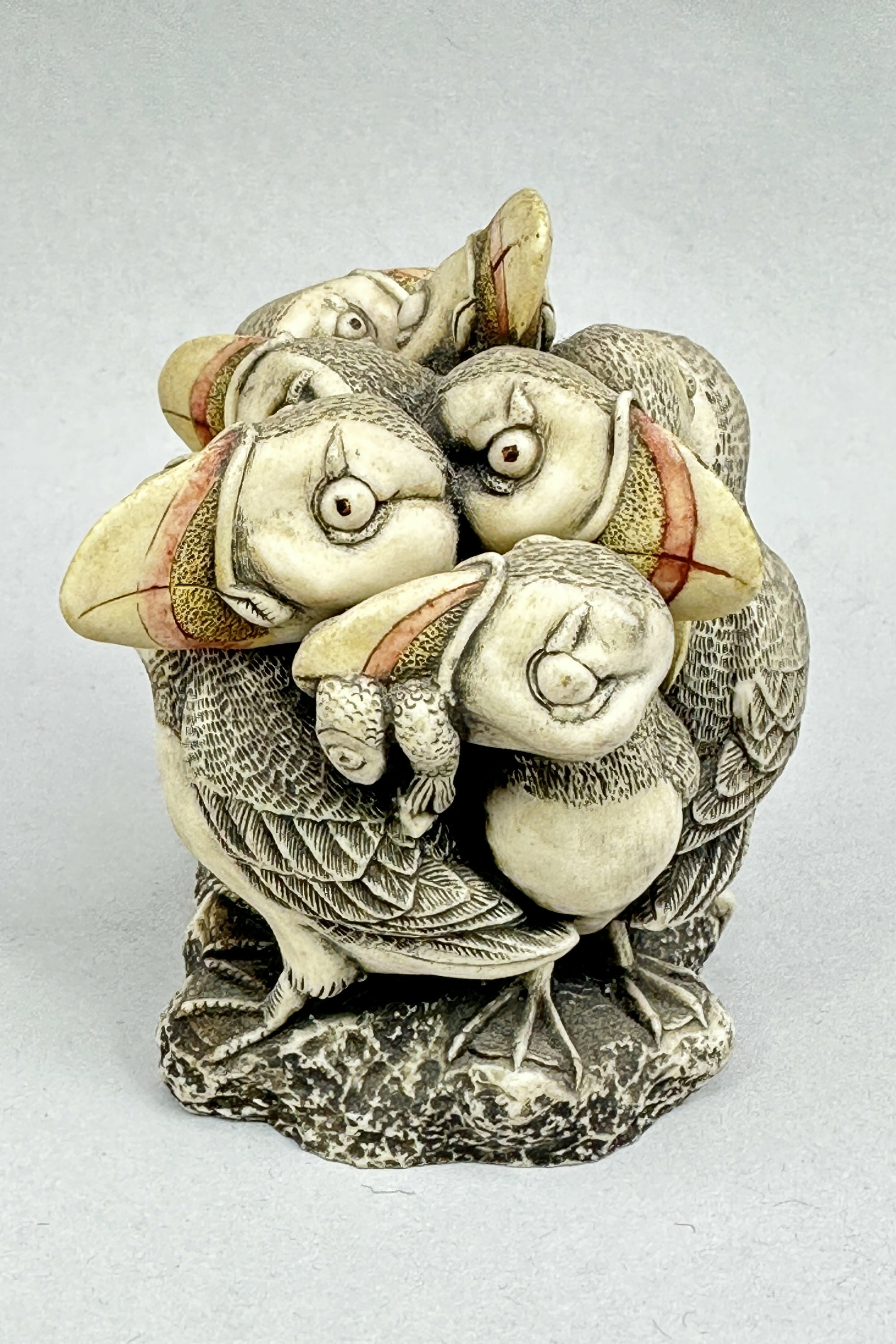
Harmony Kingdom Trinket Box with Puffins, dated 2001
Price: £20Harmony Kingdom is a business set up by Peter Calvesbert in 1992. Their studio is situated in the Malvern Hills and they have been producing whimsical figurine sculptures for over 25 years which have an enthusiastic following, particularly in the USA. ‘In Fine Feather’ is a discontinued item so now has a very modest rarity value in addition to its intrinsic charm.

Two Scottish Tartan Plaques, C20th
Price: £35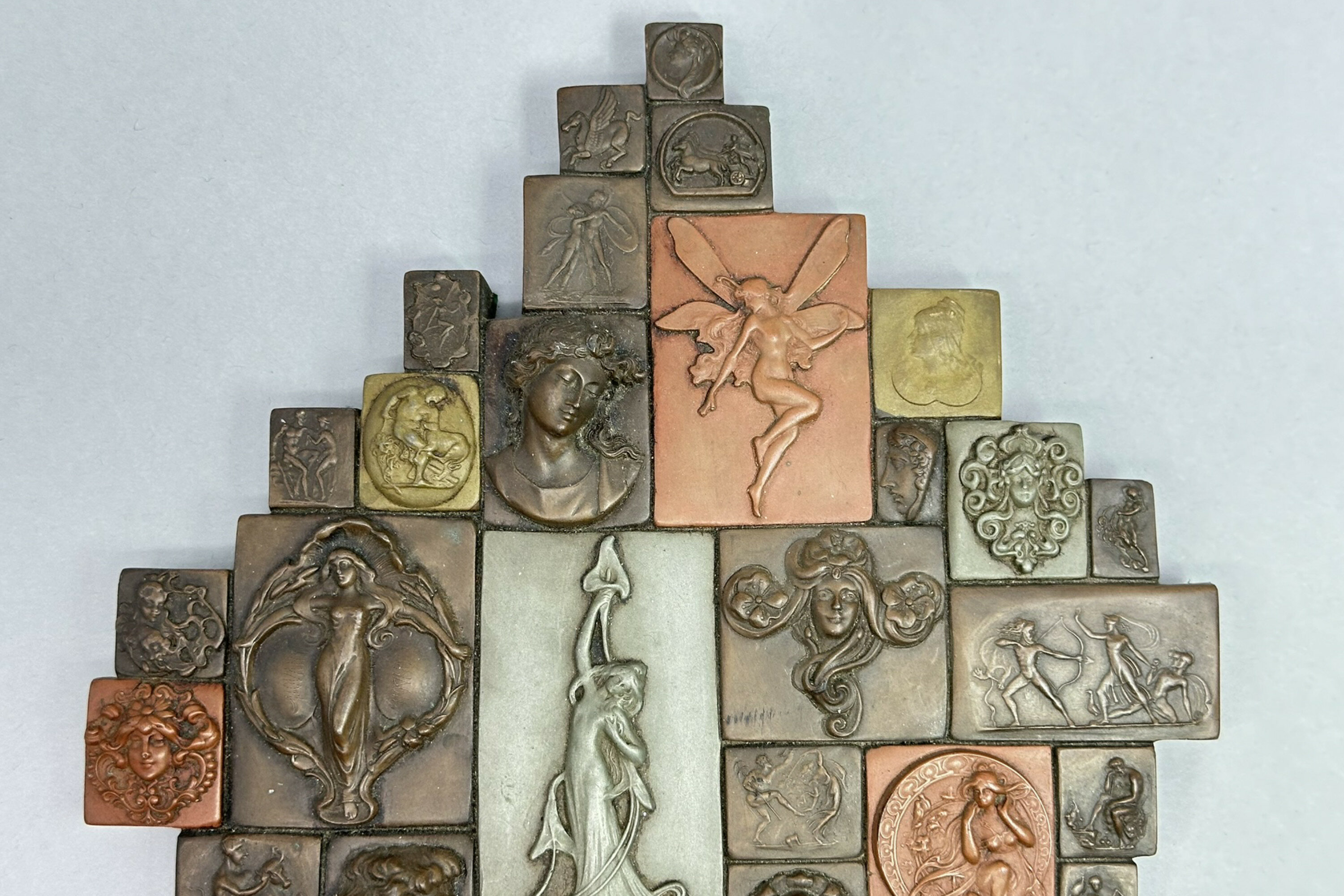
Wall plaque by Giovanni Schoeman depicting classical style figures, 1970s
Price: £75While Art Nouveau in style, Schoeman only perfected these techniques in the late 1960s, producing pieces in the style from a studio in Kentish Town which sold well in the London outdoor art markets. In the late 1970s, Schoeman moved to America with the intention of producing large scale art but the venture foundered and he died in 1981. This plaque, of which other examples are known, must have been one of his most popular designs in those London years and is a striking example of the techniques he developed and mastered.
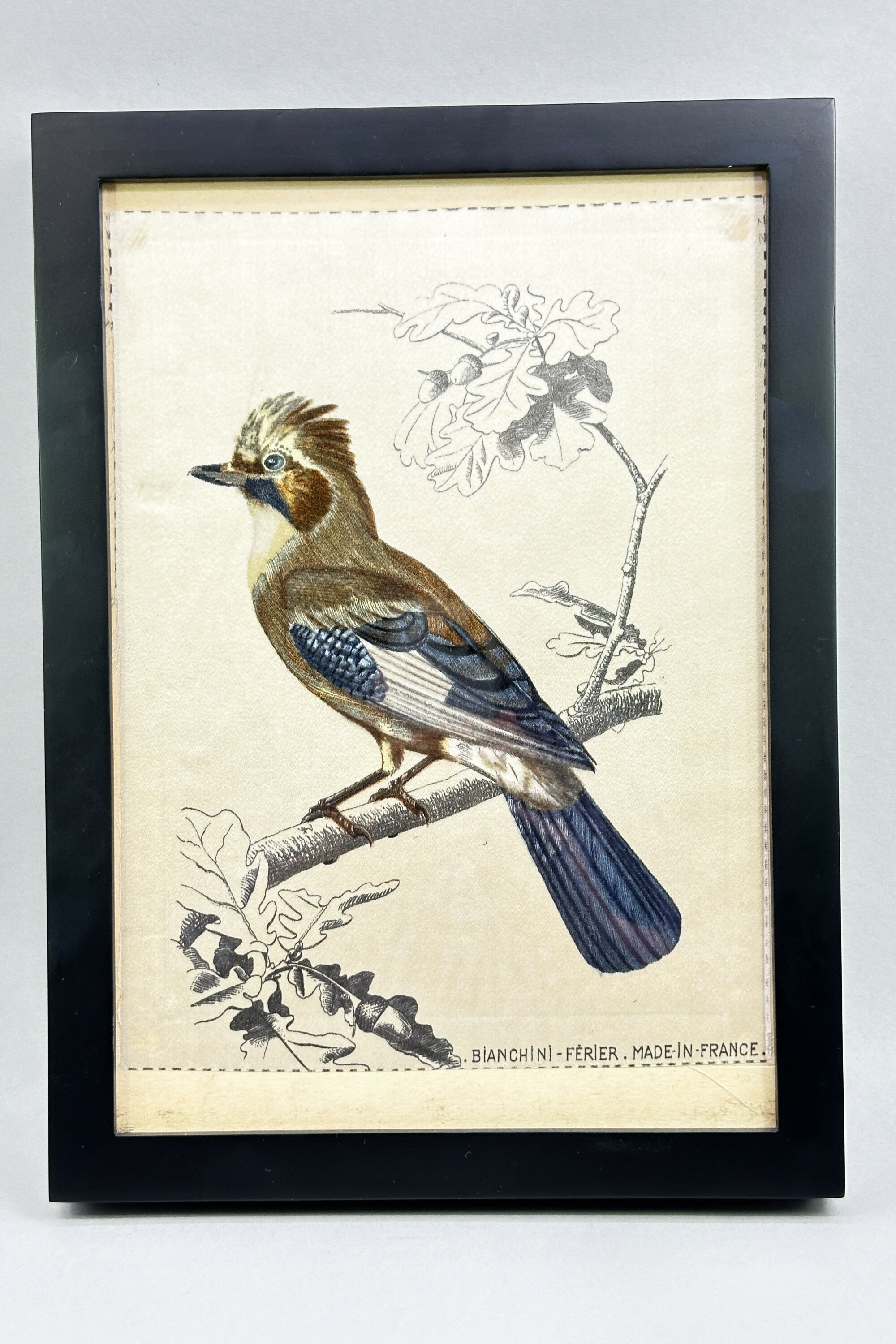
Silk Print of a Bird, Bianchini-Ferier, France, early C20th
Price: £25Bianchini Ferier was a silk weaving manufacturer based in Lyons. Founded in 1888 by Francois Atuyer, Charles Bianchini and Francois Ferier, it first produced fine silk damasks mainly for the clothing industry. After gaining a silver medal at the Paris Exposition Universelle of 1889 it went on to enjoy great success and many well known artists created designs for it in the early C20th, most notably Raoul Dufy. Production continued until the early 1990s when the firm was acquired by Tissages Bauman.
This print resembles designs in the firm’s archives from the late C19th and was probably created in the early C20th. It was designed for framing and the dotted line definition of the composition can be seen at the edges. Presented now in a modern surround it provides an excellent example of the firm’s work and a reflection of the Art Nouveau style so popular when it was produced.

Pair of Georgian Style Square Gilt Bronze Table Salts, English C19th
Price: £45
Art Deco green glass Orion Bowl by Lausitzer Glaswerke, Germany 1930s
Estimate: £30 – 40
Gilt decorated English porcelain powder box and cover, probably mid C20th
Price: £15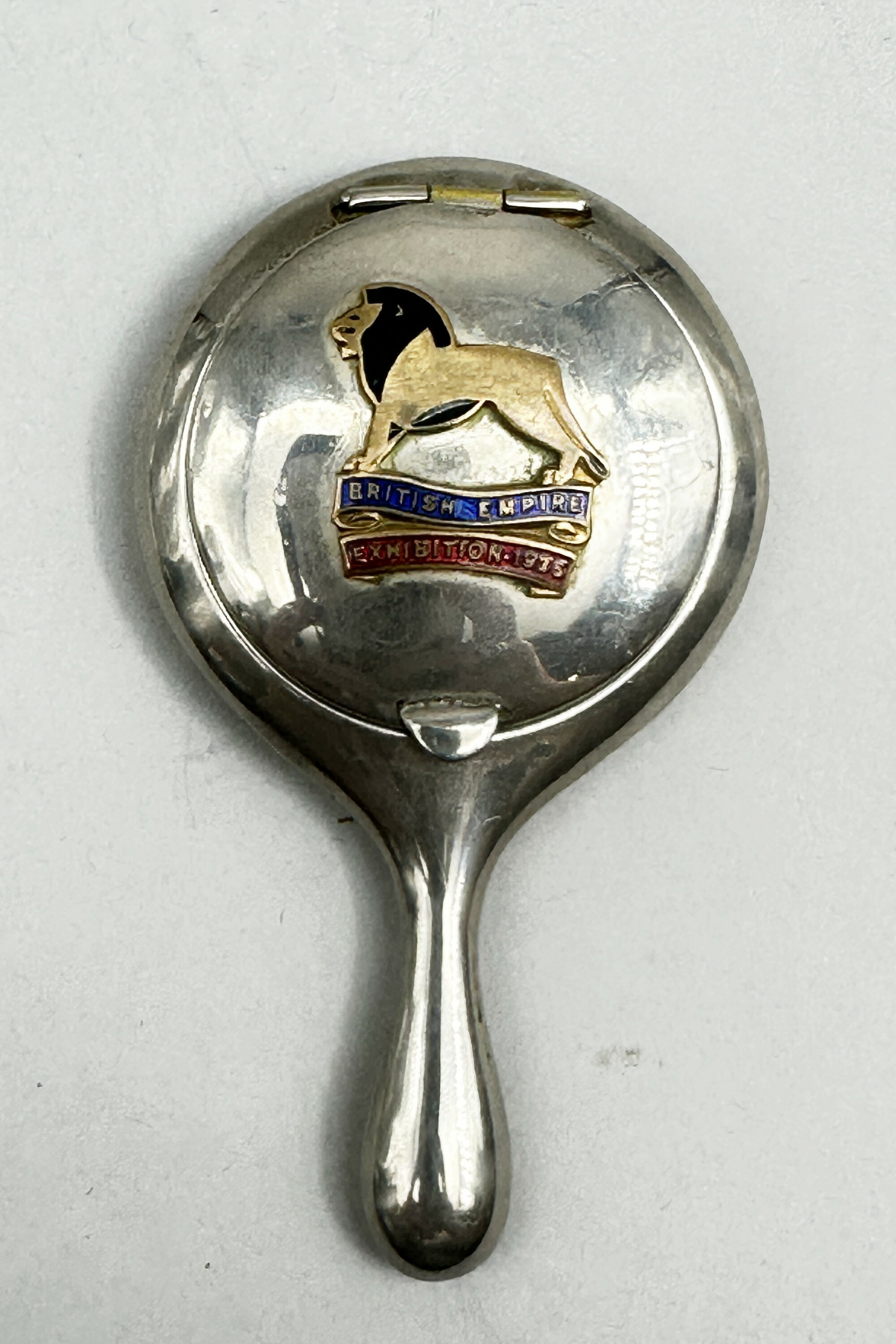
Powder Compact, British Empire Exhibition (1924-1925), dated 1925
Price: £45Souvenirs and medals were produced, amongst which were silver plated powder compacts as here. The round container for the powder has a hinged lid revealing the powder well below, originally fitted with a mauve ribbon tasseled powder puff, and a mirror above. On the surface of the lid, which has a tab for lifting, is a stylised brass lion, a symbol of the British Empire, vitreous enameled in black, red and blue with the wording ‘British Empire Exhibition 1925 ’ There is a short rounded handle and the back has an engraved mark ‘Rd [registered] 689177’ for the patent number. While many were doubtless made (and there is another version with a more slender handle, with a ring at the end, and the background colourings of the lettering reversed) few of these compacts seem to have survived making this a desirable addition to a collection of British memorabilia.

Czech rhinestone jewelled glass metal filigree Perfume Bottle and Stopper, C20th
Price: £45
Papier Mâché Tray with Millefiori Decoration, Kashmir, C20th
Price: £55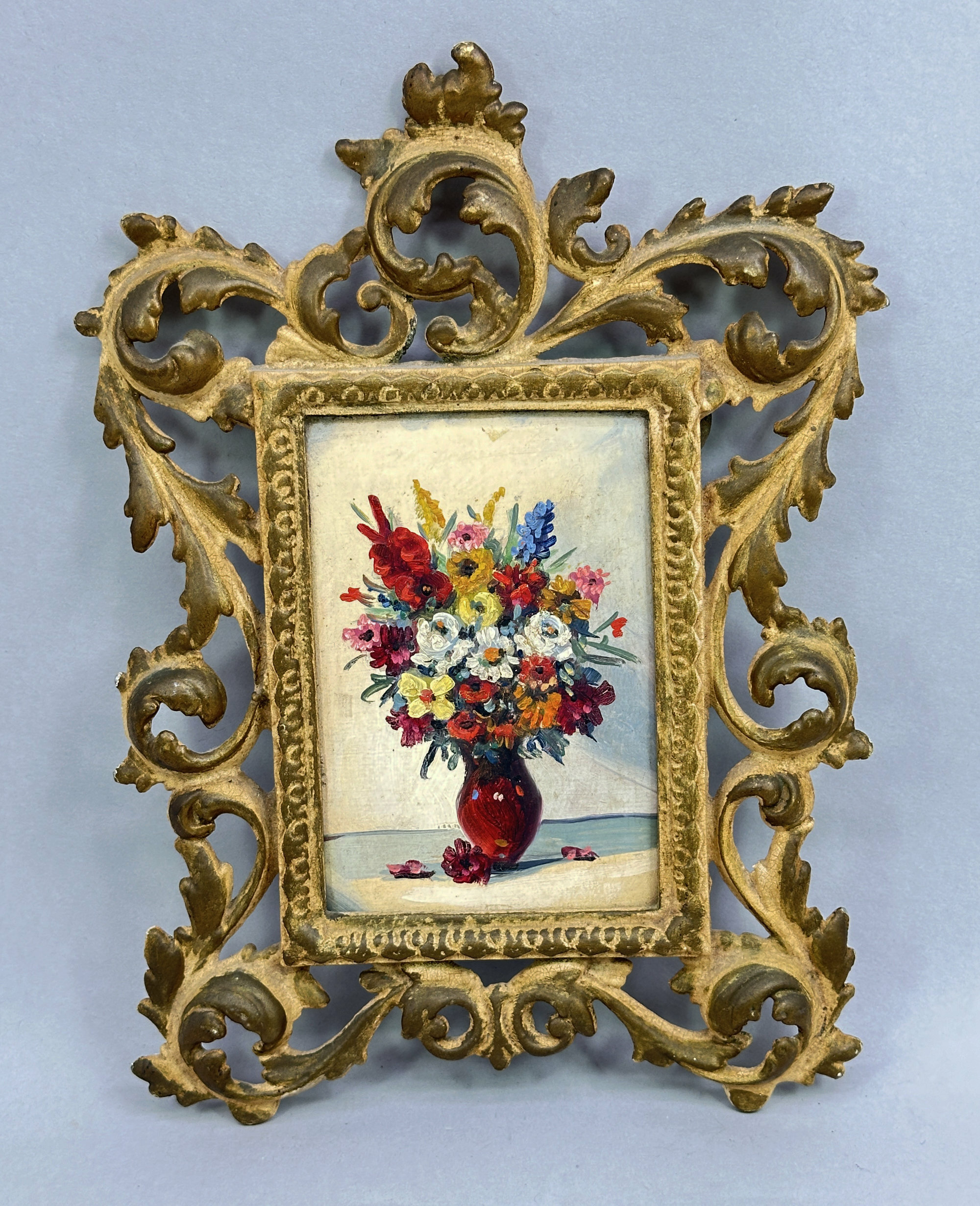
Baroque Style Picture Frame with Still Life, C20th
Price: £25
Renaissance Revival Brass Desk Set, English c 1900
Price: £55
Townshend & Co : Butler’s Crumb Tray and Matching Brush, Birmingham c1900
Price: £75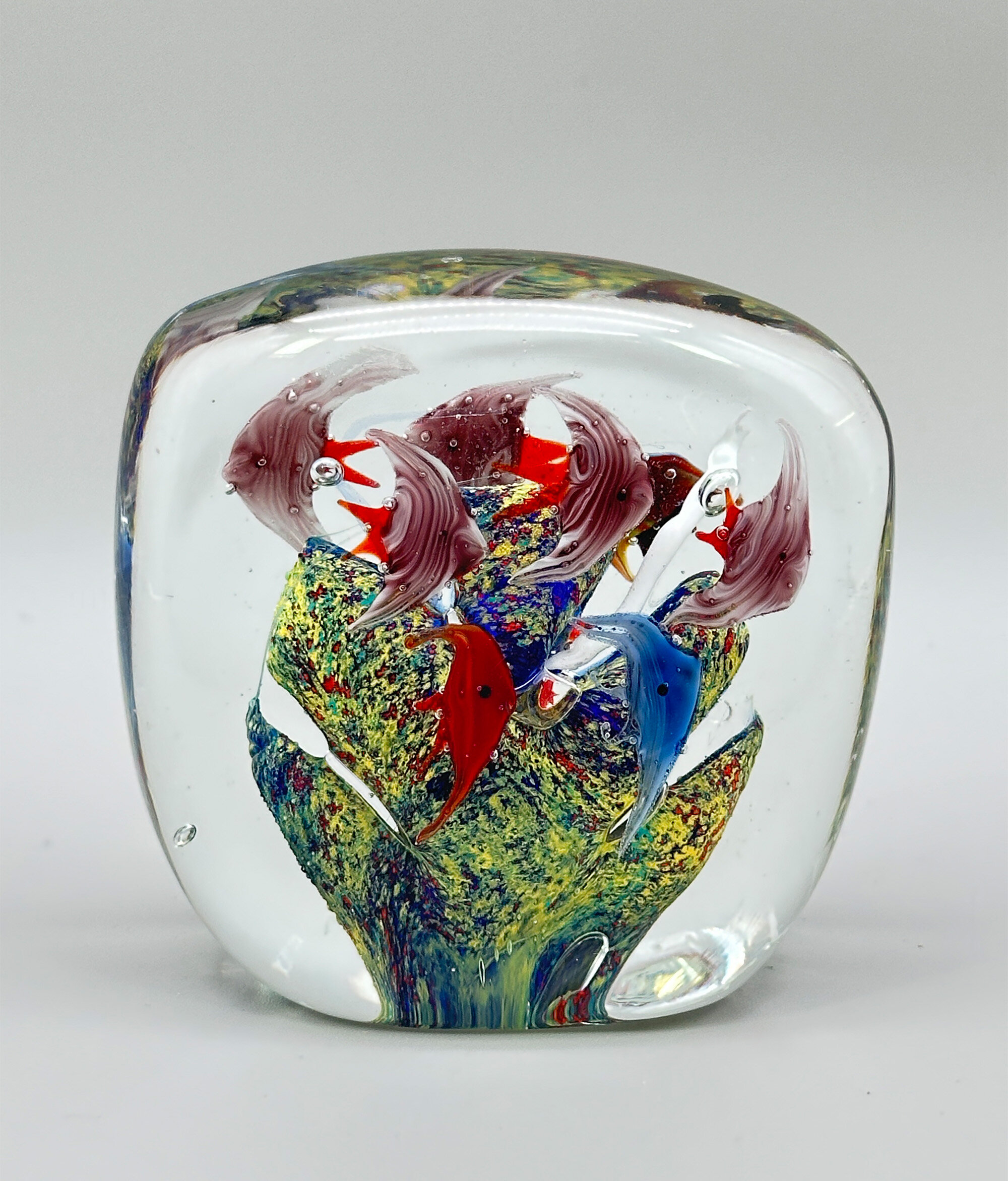
Glass Aquarium Paperweight, probably Murano second half C20th
Estimate: £30 – 40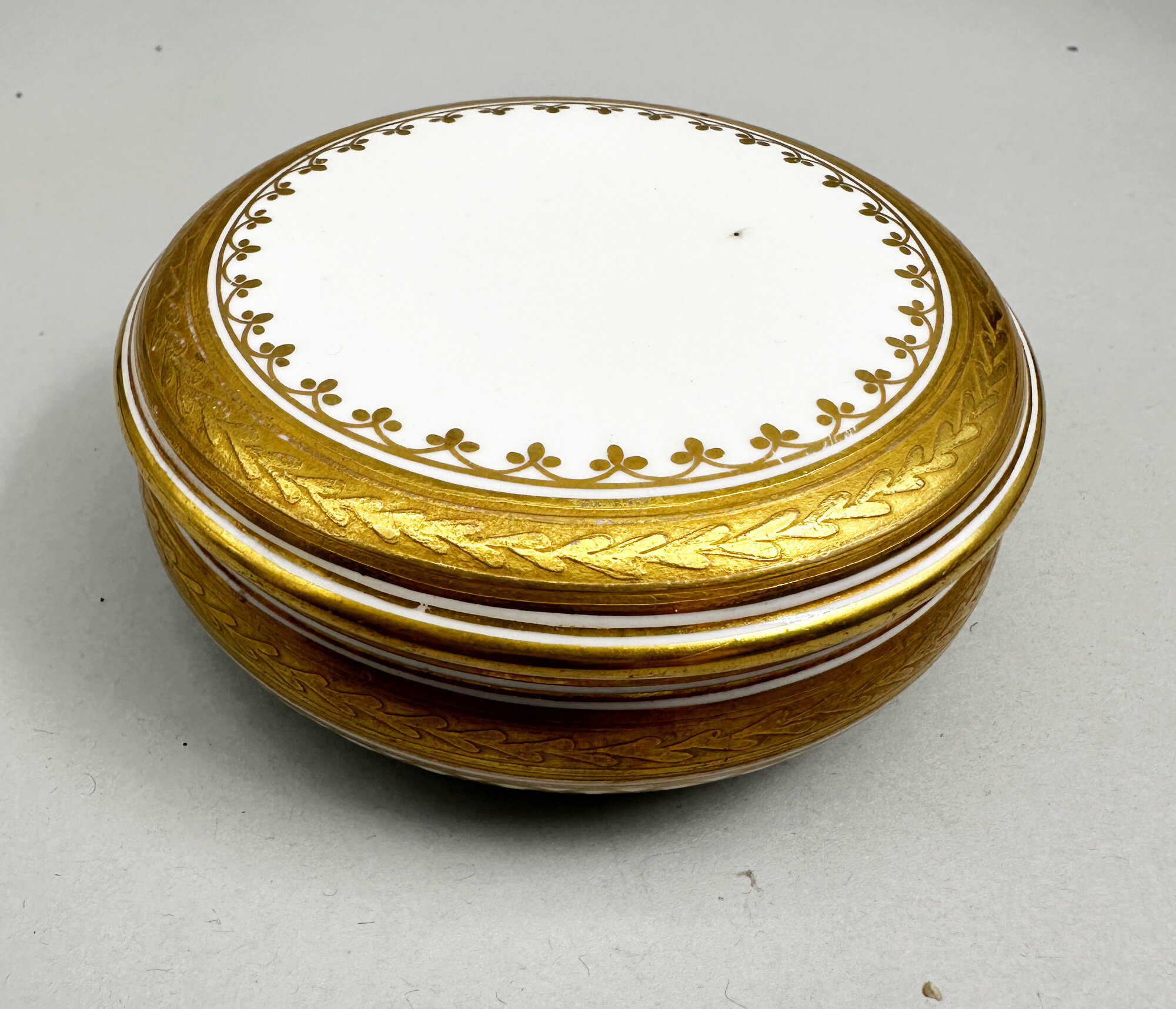
Gilt decorated English porcelain powder box and cover, probably mid C20th
Price: £15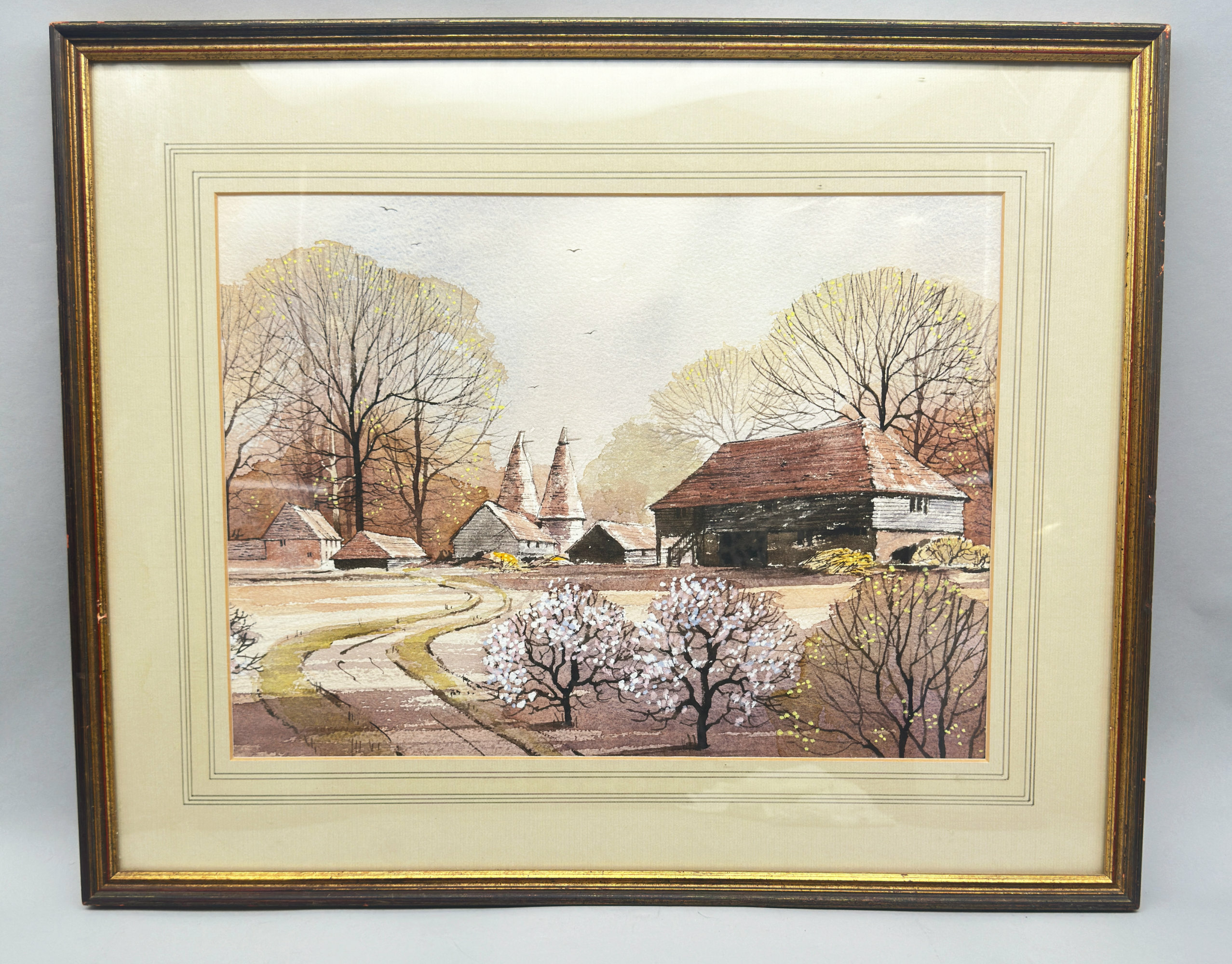
Watercolour by Elisabeth Castle, Kent Landscape Scene, framed, late C20th
Price: £45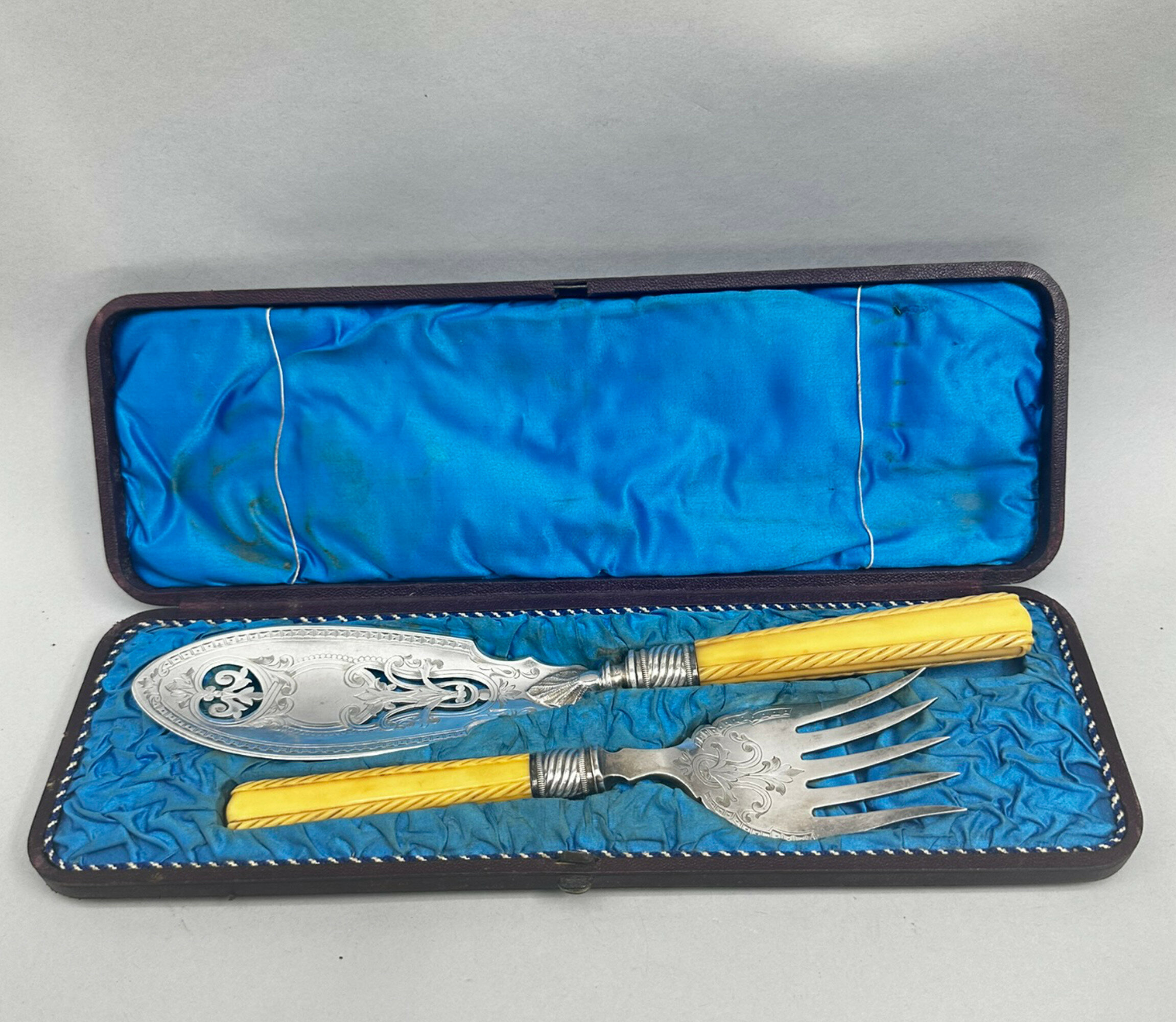
Pair of Silver Plated Fish Servers with fitted box, probably Edwardian
Price: £45
Art Nouveau Bronze Tray, stamped 172 Deposé, French c1900
Price: £95
Framed Watercolour, Harbour or Beachside Scene, signed, C20th
Price: £25
Chinese Straw Thread Picture on Silk, framed in original box, late C20th
Price: £45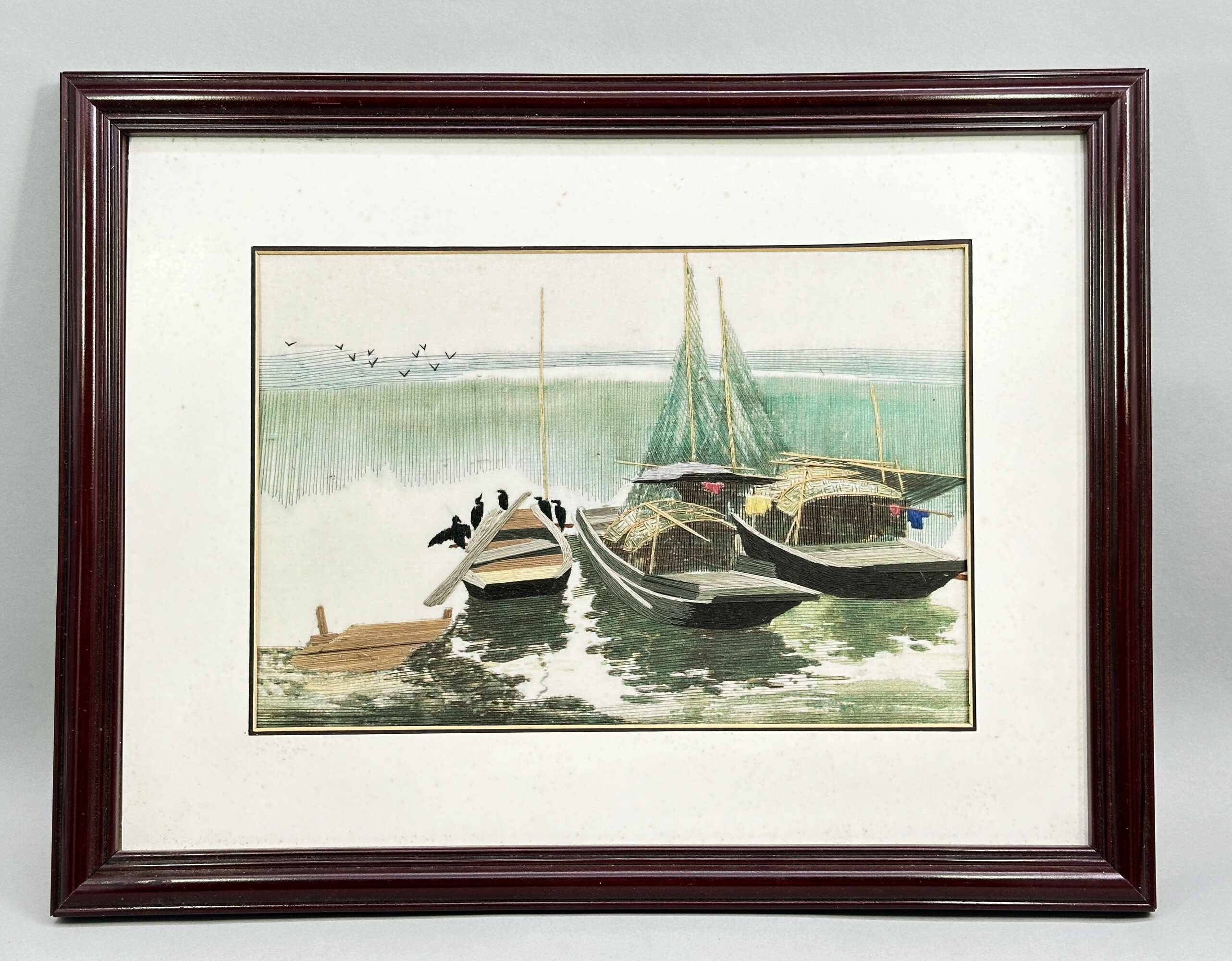
Chinese Straw Thread Picture on Silk, framed in original box, late C20th
Price: £45